BRITISH TITLED TRAINS DURING THE TRANSITION FROM STEAM
Imagine a small boy in short pants sitting in the front row of his local 'Flicks' during the mid-Fifties. It is one of two picture houses in Horsforth: the 'Imperial' on Town Street or the 'Glenroyal' on New Road Side, both of which were doing brisk business prior to the 1960s television boom. 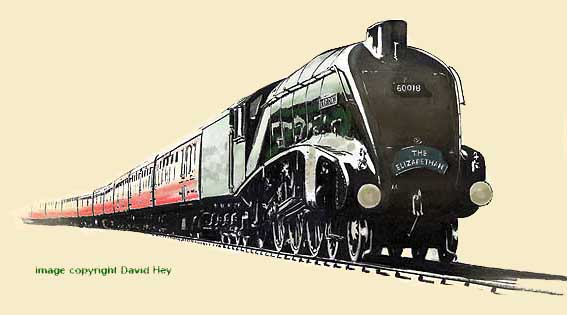 Okay, perhaps this scruffy urchin can't remember which cinema it was or even the exact year, but he does recall what happened next…he'd arrived in the middle of a public information film and the magnificent image of a speeding Class A4 60017 Flying Fox appeared on the screen.
Okay, perhaps this scruffy urchin can't remember which cinema it was or even the exact year, but he does recall what happened next…he'd arrived in the middle of a public information film and the magnificent image of a speeding Class A4 60017 Flying Fox appeared on the screen.
Whoa! Suddenly roused by feral exhilaration he sat bolt upright and yelled - 'Streeeeak!'
There was a gasp of disapproval, a 'shhh!' went round the auditorium, someone tittered. Then the grumpy old commissionaire arrived, shone his torch at the offending boy and clouted him across the back of the head - 'Shut your cake 'ole you stupid little squirt!' he said.
Humiliated beyond belief, the small boy's woeful sobbing was quite audible and he missed the rest of film through a stream of tears. At the same time he feared someone in the audience would recognise him, tell his mum and dad, which meant another beating when he got home! It's amazing what you remember from childhood, but then it's not something you easily forget either…
However, fast-forward fifty-odd years and I'm watching the same BTF 20-minute film 'Elizabethan Express' on TV at home and the memories of old spotting days come flooding back…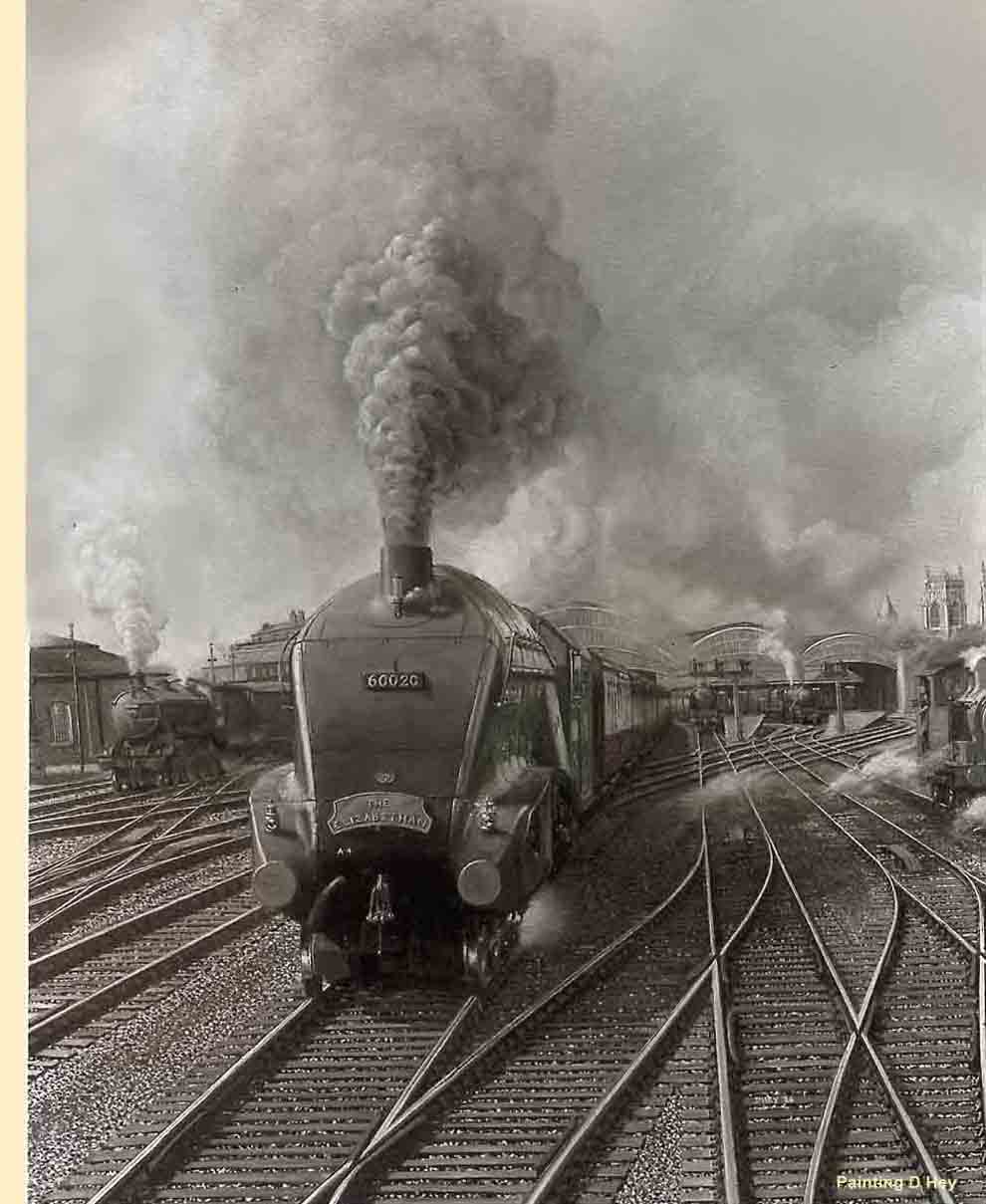 I'm talking about childhood reminiscences of Thirsk station during the mid-Fifties.
I'm talking about childhood reminiscences of Thirsk station during the mid-Fifties.
The station is situated on the superbly-aligned stretch of East Coast Main Line between York and Northallerton, which has seen more high-speed running than any other in Britain. During steam days the Class A4 'Streaks' were topping 90mph in regular service, especially on the fast expresses through Thirsk. From the platform edge, it was easy to spot these streamlined machines in the distance because the sun caught their sloping wedge-shaped fronts which produced the effect of a beam of light; though at first it was barely discerible, merely a pin prick shimmering through heat haze rising from the track. But there was no mistaking what was hurtling towards you; the glimmer of light would slowly transform into the distinctive streamlined shape of a 'Streak - so sleek and dashing; a thoroughbred racing machine in full flight, rocking and swaying over the points like a wild stallion.
Then, as the driver blew the melodious chimed whistle heralding his warning, the sleepy station was awakened to a wild and determined crescendo of sound; the ferocity of it was spellbinding. The platform shook beneath your feet as the train thundered by, whipping up a tumult of swirling smoke and steam, engulfing everything in its wake. Then it was gone, the moment all too brief; yet the magic of it still rooted you to the spot.
I recall seeing the Class A4s romping through Thirsk station on countless occasions, and I'll never forget the titled trains they hauled: 'The Talisman'; 'The Heart of Midlothian'; 'The Norseman'; the 'Tees-Tyne Pullman'; 'The Aberdonian'; 'The Flying Scotsman' - and, of course, 'The 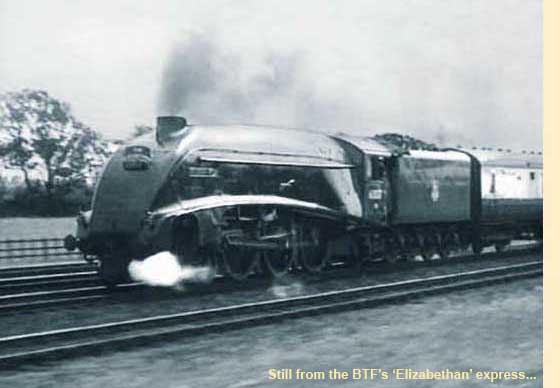 Elizabethan' - all of which brings me to the point. Why not upload a page of 'Titled Trains of Great Britain'. After all, a named train represented all that was great about old train spotting days...
Elizabethan' - all of which brings me to the point. Why not upload a page of 'Titled Trains of Great Britain'. After all, a named train represented all that was great about old train spotting days...
(Left) The British Transport Film's 'Elizabethan Express' (1954) was directed by Tony Thompson and written by Paul le Saux, whose whimsical verse commentary romanticised the human story behind the longest scheduled non-stop railway journey in the world…but wait! There's a snag! Driver McCloud has seen a signal check and applies the brakes. The A4 slows to a crawl; the tension mounts, the guard glances anxiously at his watch, but the signalman gives the 'all clear'. Fireman Mungo gets stuck in…the train picks up speed and the clickety-clack or wheels over rail joints increases in tempo. What a relief! 'She's on time!'...cue trumpet fanfare! The film sequences by cinematographer Billy Williams of 60017 Silver Fox at speed captures the whole drama perfectly, a great film to lift the nation's spirits during the immediate post-war era. This excellent film is included on the BFI British Transport Films DVD compilation 'On and Off the Rails'…click here for details.
EASTERN REGION EXPRESSES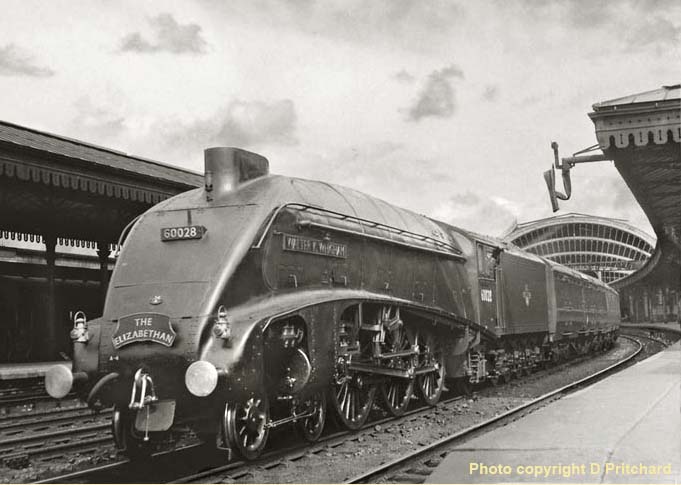
(Above-Below) The mid-morning departures of both up and down 'Elizabethan's' from London Kings Cross and Edinburgh Waverley meant a tea time arrival at both English and Scottish capitals; a 393-mile non-stop journey of 6 hours 30 minutes with an average speed of a mile per minute. Okay, perhaps 60 mph might be regarded as somewhat pedestrian by today's standards, but it was exemplary in view of the poor state of the ECML at that time. Here Class A4 60028 Walter K Whigham heads the southbound train through York. (Below) A nameplate measuring 86½" long, and clearly in ex-loco condition, went under the hammer for £27,000 at a Great Central Railwayana Auction on 13th July 2013. Originally numbered 4487 and named Sea Eagle, this Class A4 was built at Doncaster Works in 1937; the loco changed its name following an overhaul at the Plant on the 1st October 1947 when it emerged bearing the name of the Deputy Chairman of the LNER. The locomotive achieved fame on 24 August 1948 when it became the first of its Class to haul the up 'Flying Scotsman' non-stop from Edinburgh to Kings Cross taking the longer route via the Waverley line. The diversion was caused by heavy flooding of the ECML in south east Scotland and train services from Edinburgh were rerouted to St Boswells and then via Kelso before rejoining the East Coast Main line at Tweedmouth. 60028 was withdrawn from Kings Cross shed in December 1962 and cut up at Doncaster Works in January 1963.

 (Inset-Below) 'The Elizabethan' began life in 1949 when it was decided to create a new non-stop train between the capitals - aptly named 'Capitals Limited' - to run ahead of the 'Flying Scotsman' in both directions. In 1953, when a suitable commemoration was desired for the Coronation of Queen Elizabeth, the 'Capitals Limited' was changed to the 'Elizabethan' and the time allowance was cut to 6½ hours bringing the express to within the charmed circle of mile-a-minute running. (Below) In the summer of 1955, a young seven year-old train-mad Roy Lambeth was accompanying his dad on a visit to Wharton Park in Durham. His dad chose a vantage point just behind Durham South Signal Box where they could watch trains crossing Durham viaduct, and it was this visit that started Roy's lifetime love of steam and railways. If your own childhood reminiscences include the smell of acrid smoke, hot oil and steam, Roy's 'Rail Cameraman' stories on Page 48 will bring back many pungent memories. Here Class A4 60017 Silver Fox speeds south through Durham.
(Inset-Below) 'The Elizabethan' began life in 1949 when it was decided to create a new non-stop train between the capitals - aptly named 'Capitals Limited' - to run ahead of the 'Flying Scotsman' in both directions. In 1953, when a suitable commemoration was desired for the Coronation of Queen Elizabeth, the 'Capitals Limited' was changed to the 'Elizabethan' and the time allowance was cut to 6½ hours bringing the express to within the charmed circle of mile-a-minute running. (Below) In the summer of 1955, a young seven year-old train-mad Roy Lambeth was accompanying his dad on a visit to Wharton Park in Durham. His dad chose a vantage point just behind Durham South Signal Box where they could watch trains crossing Durham viaduct, and it was this visit that started Roy's lifetime love of steam and railways. If your own childhood reminiscences include the smell of acrid smoke, hot oil and steam, Roy's 'Rail Cameraman' stories on Page 48 will bring back many pungent memories. Here Class A4 60017 Silver Fox speeds south through Durham. 
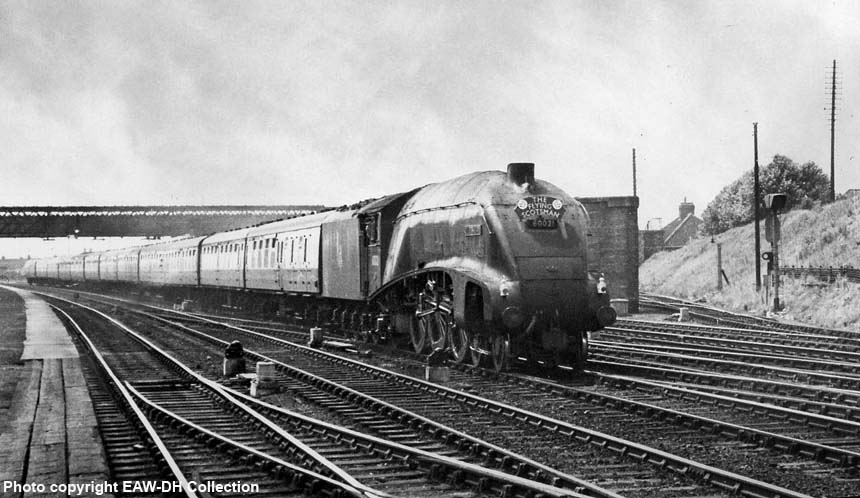
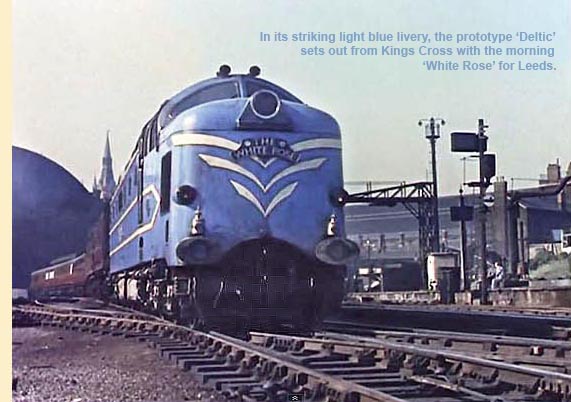 (Above-Below) When the Deltic fleet replaced the Class A4s on the Anglo-Scottish expresses the times between Kings Cross and Edinburgh were speeded up to those of the pre-war 'Coronation' streamliner expresses - 6 hours including a stop at Newcastle. Indeed no other steam locomotive class made such an remarkable impact than the Class A4, particularly the first member of the class, No 2509 Silver Link (lBR No 60014) when it averaged a speed of 100mph for 43 miles during its famous press run on the 'Silver Jubilee' on 27th September 1935. The train was named to mark the Silver Jubilee of King George V, and the first four A4s Nos 2509-12 carried names with a silver theme and emerged from Doncaster 'Plant' in a startling silver-grey livery to match the train set. Still going
(Above-Below) When the Deltic fleet replaced the Class A4s on the Anglo-Scottish expresses the times between Kings Cross and Edinburgh were speeded up to those of the pre-war 'Coronation' streamliner expresses - 6 hours including a stop at Newcastle. Indeed no other steam locomotive class made such an remarkable impact than the Class A4, particularly the first member of the class, No 2509 Silver Link (lBR No 60014) when it averaged a speed of 100mph for 43 miles during its famous press run on the 'Silver Jubilee' on 27th September 1935. The train was named to mark the Silver Jubilee of King George V, and the first four A4s Nos 2509-12 carried names with a silver theme and emerged from Doncaster 'Plant' in a startling silver-grey livery to match the train set. Still going 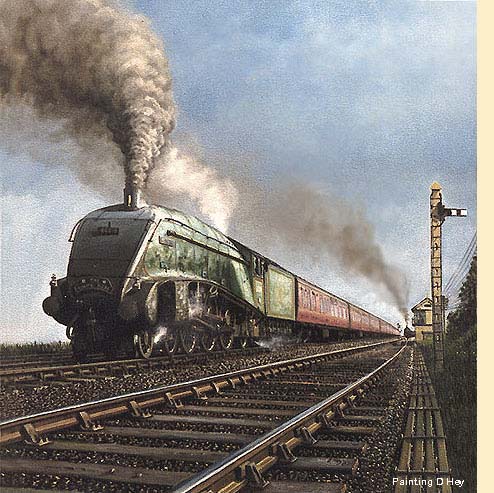 strong, Class A4 60021 Wild Swan passes Holgate station with the northbound 'Flying Scotsman' in the late Fifties. (Below) Fast-forward twenty-odd years and another remarkable loco made its debut in October 1955. Unofficially designated DP1 - 'Diesel Prototype One' - the English Electric Co 3,300hp Co-Co 'Deltic' diesel prototype was sponsored by the company in order to assess their marine Napier-Deltic engine in rail use. The widespread use of alloy in its construction led to a comparatively lightweight high rpm diesel engine which could be mounted on a Co-Co wheelbase. Following a spell of duty on the LMR's WCML service between Euston and Liverpool (see LMR section below) Deltic was transferred to the East Coast Main Line based at Hornsey. The Eastern Region immediately recognised its full potential, for having been denied ECML electrification the operating department was in urgent need of a more powerful diesel to substitute its earlier and less powerful EE Co Type 4 fleet. Here the prototype awaits departure from Kings Cross with the 08.50 'White Rose' to Leeds on 7th July 1959.
strong, Class A4 60021 Wild Swan passes Holgate station with the northbound 'Flying Scotsman' in the late Fifties. (Below) Fast-forward twenty-odd years and another remarkable loco made its debut in October 1955. Unofficially designated DP1 - 'Diesel Prototype One' - the English Electric Co 3,300hp Co-Co 'Deltic' diesel prototype was sponsored by the company in order to assess their marine Napier-Deltic engine in rail use. The widespread use of alloy in its construction led to a comparatively lightweight high rpm diesel engine which could be mounted on a Co-Co wheelbase. Following a spell of duty on the LMR's WCML service between Euston and Liverpool (see LMR section below) Deltic was transferred to the East Coast Main Line based at Hornsey. The Eastern Region immediately recognised its full potential, for having been denied ECML electrification the operating department was in urgent need of a more powerful diesel to substitute its earlier and less powerful EE Co Type 4 fleet. Here the prototype awaits departure from Kings Cross with the 08.50 'White Rose' to Leeds on 7th July 1959. 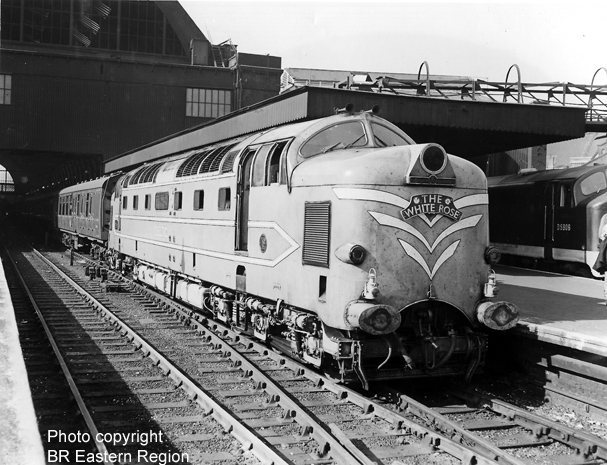
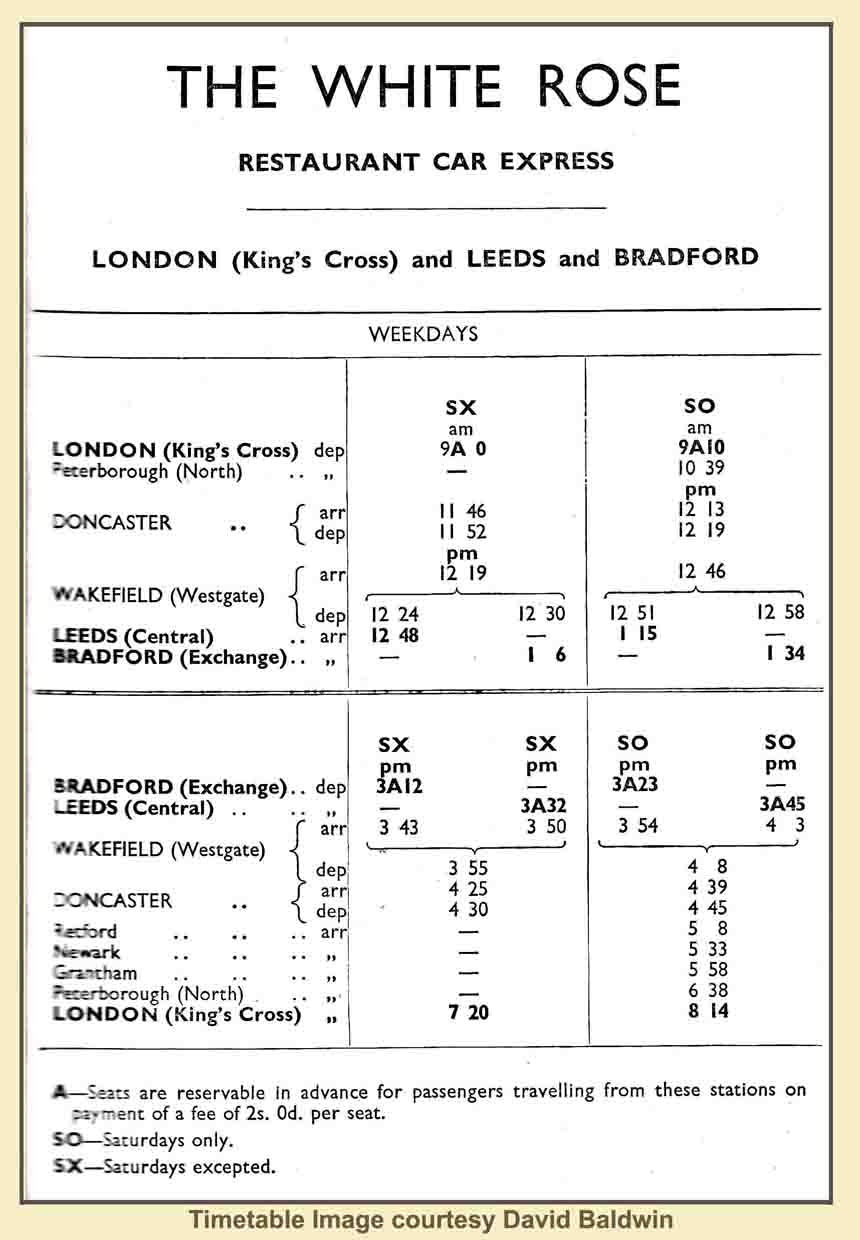

(Above) The 'White Rose' ran every weekday, leaving London Kings cross in the early morning and returning from Leeds Central in the afternoon. Sporting a Doncaster (36A) shedcode on the smokebox door, Class A3 No 60046 Diamond Jubilee heads the return working out of Leeds Central on the climb through Holbeck High Level. Note the gradient post on the left indicating the 1in 55 descent on the short spur to Geldard Junction; this was used by the Anglo-Scottish 'Queen of Scots' Pullman - a train I am very familiar with since it ran past my bedroom window on the line via Harrogate and Ripon (regaining the ECML at Northallerton). 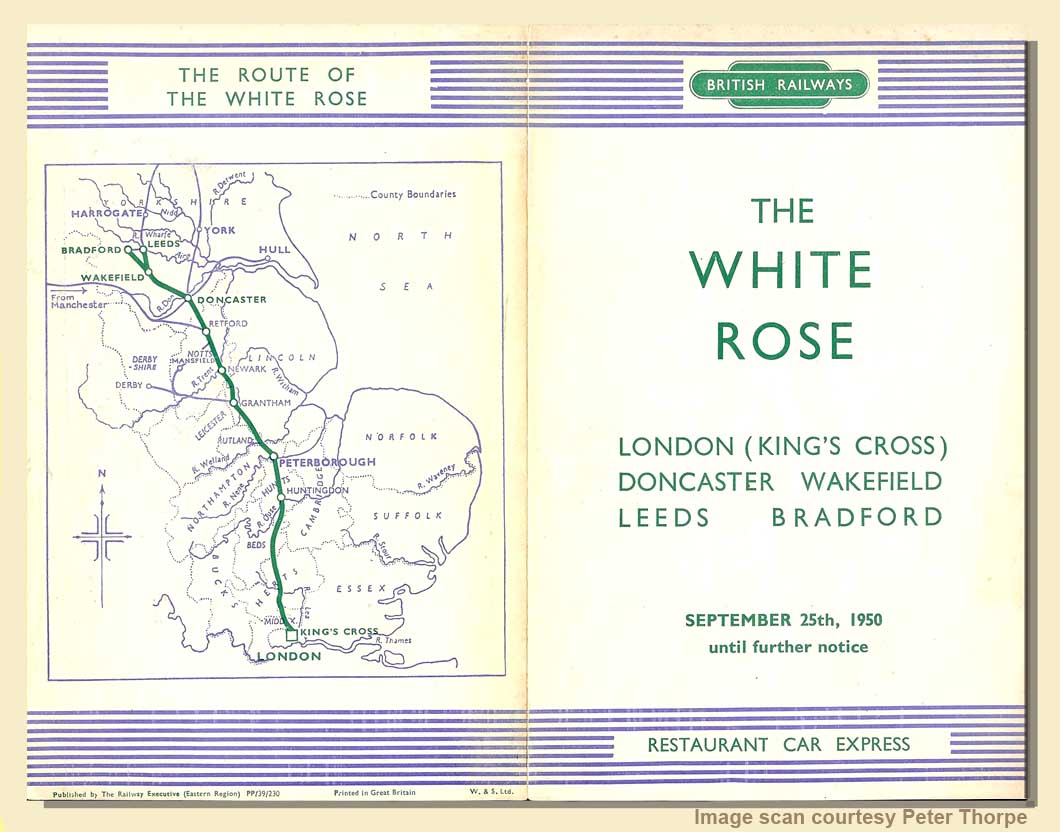
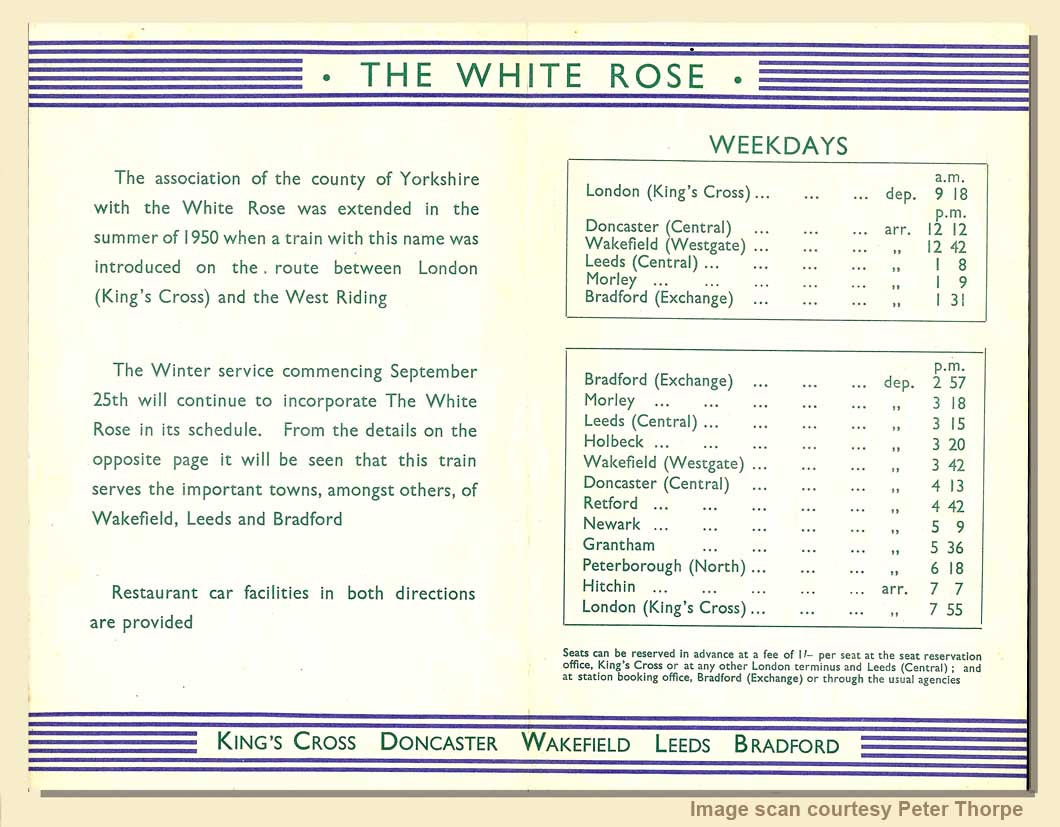
(Below) The line out of Leeds Central to Wakefield is a continuous climb up the bank from Central station through Holbeck High Level station. Past Copley Hill shed - with on a half mile breather just beyond Wortley South Box. This was followed by a further climb through Beeston Junction and Tingley Tunnel to Ardsley. Some magnificent smoke affects were to be seen as engines tackled this bank out of Leeds. Her Class A4 60013 Dominion of New Zealand makes a spirited departure with the up 'White Rose for Kings Cross.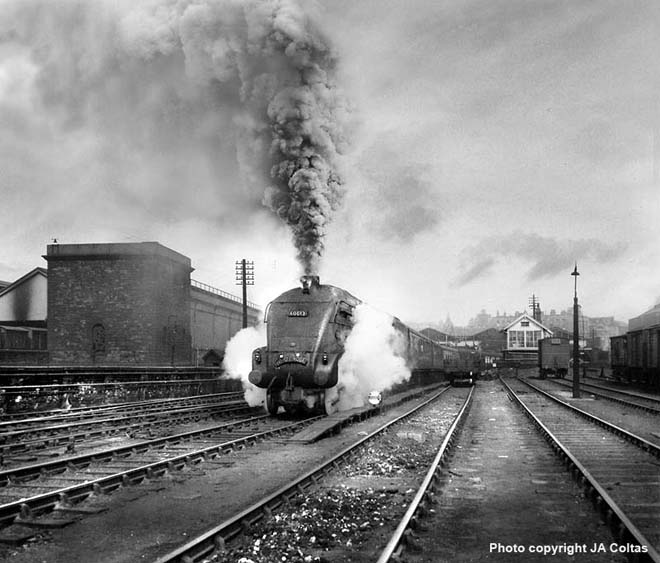
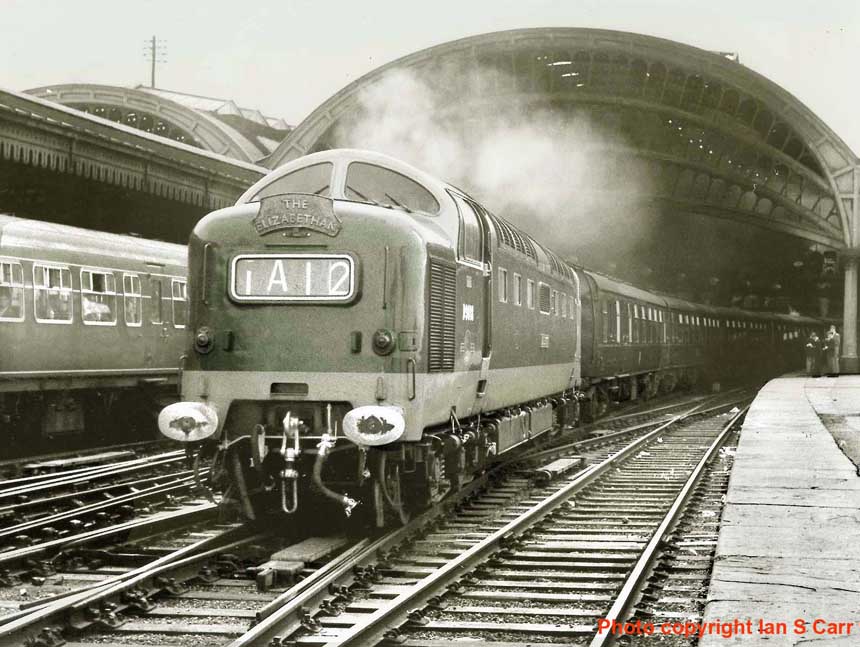
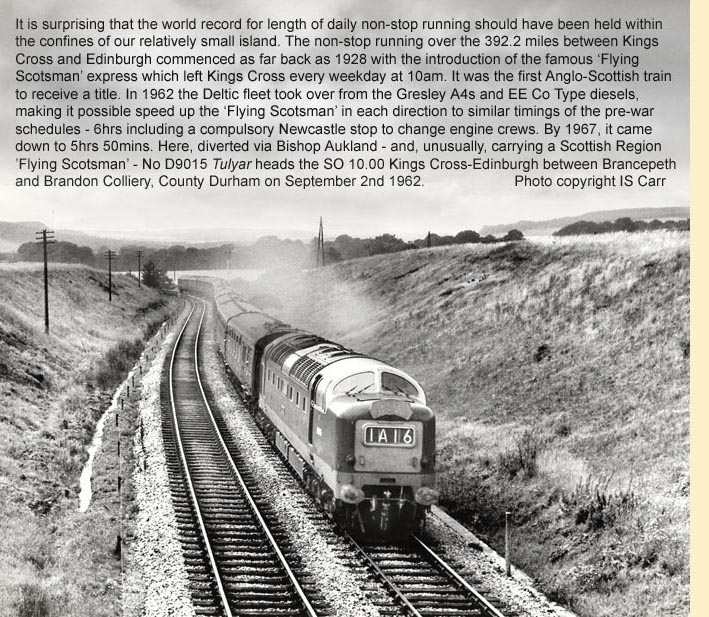 (Above-Insets-Below) Steam engine crews on the non-stop Anglo-Scottish turns changed by means of the corridor tenders fitted to most Gresley Class A4 Pacifics, but the non-stop record was discontinued at the commencement of the EE Deltics (Class 55s) reign when a Newcastle stop was introduced for changing crews. Train spotters dutifully note down the number of D9018 Ballymos passing York on the 'down' train on 13th August 1962. A top lamp iron has been fitted above the headcode panel on the nose to allow the locomotive
(Above-Insets-Below) Steam engine crews on the non-stop Anglo-Scottish turns changed by means of the corridor tenders fitted to most Gresley Class A4 Pacifics, but the non-stop record was discontinued at the commencement of the EE Deltics (Class 55s) reign when a Newcastle stop was introduced for changing crews. Train spotters dutifully note down the number of D9018 Ballymos passing York on the 'down' train on 13th August 1962. A top lamp iron has been fitted above the headcode panel on the nose to allow the locomotive  to carry a named-train headboard. (Below) By September 1961 thirteen Deltics were available, and at the beginning of the winter schedules the Class A4s were displaced from the premier ECML expresses and more frequently to be found on Kings Cross-West Riding duties. It was the beginning of the end of the A4's reign, for the Deltic fleet took charge of numerous Anglo-Scottish expresses. The rosters were mainly undertaken by the Haymarket allocation, which included the up morning 'Talisman' and down 'Aberdonian' - the up 'Flying Scotsman' and 10.15 from Kings Cross -
to carry a named-train headboard. (Below) By September 1961 thirteen Deltics were available, and at the beginning of the winter schedules the Class A4s were displaced from the premier ECML expresses and more frequently to be found on Kings Cross-West Riding duties. It was the beginning of the end of the A4's reign, for the Deltic fleet took charge of numerous Anglo-Scottish expresses. The rosters were mainly undertaken by the Haymarket allocation, which included the up morning 'Talisman' and down 'Aberdonian' - the up 'Flying Scotsman' and 10.15 from Kings Cross - 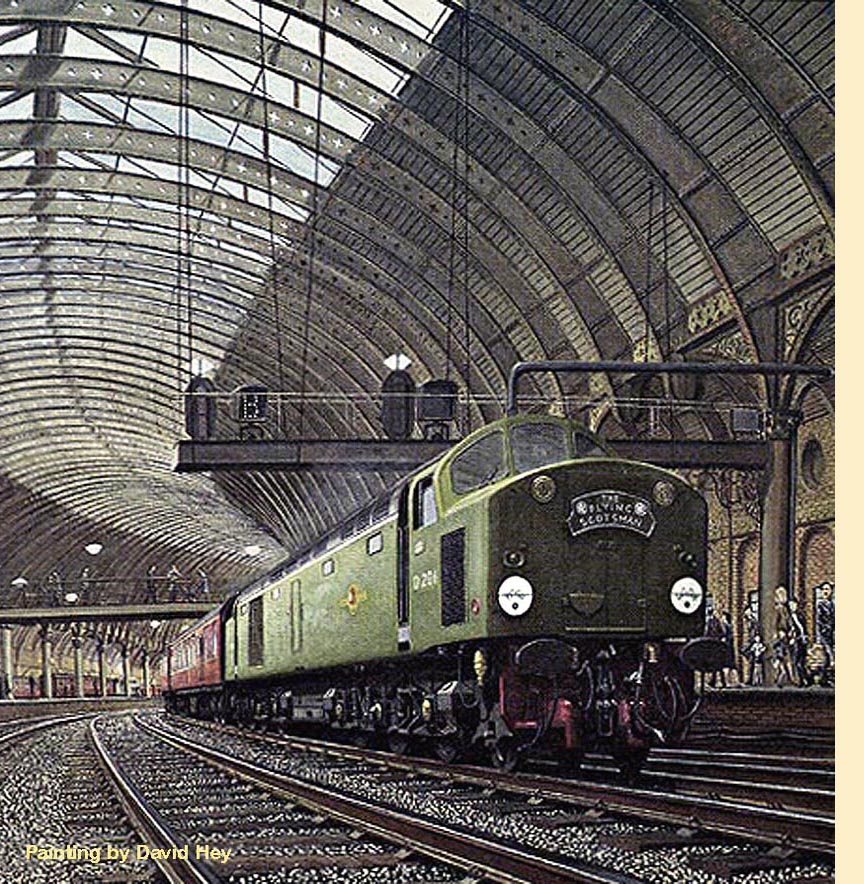 the up 'Heart of Midlothian' and 11.35 return from Kings Cross - the 11.15 from Edinburgh and the 'down' Flying Scotsman'.Ian S Carr is widely regarded as one of the elite among railway photographers. His shot of EE Co Deltic No D9009 Alycidon heading the 'up' 'Flying Scotsman' on the climb from Durham on August 8th 1961 (below) packs all the power of a 'Deltic' at full cry. No D9009 entered traffic less than three weeks earlier on July 21st, joining sister engines Nos D9001/3/7 at Finsbury Park. The depot's full allocation was made up of eight 'Deltics', with D9012/15/18/20 following in quick succession. For the record, Alycidon won the Goodwood Cup in 1949, and sired the famous Meld - No D9003 in the 'Deltic' fleet. This shot was taken in the days before top lamp irons were fitted to the nose end, hence the named-train headboards were mounted on a bracket that slipped into two front-end slots below the headcode display panel. Note also the standard express passenger headlamp code - two lamps above the bufferbeam - a legacy of steam days.
the up 'Heart of Midlothian' and 11.35 return from Kings Cross - the 11.15 from Edinburgh and the 'down' Flying Scotsman'.Ian S Carr is widely regarded as one of the elite among railway photographers. His shot of EE Co Deltic No D9009 Alycidon heading the 'up' 'Flying Scotsman' on the climb from Durham on August 8th 1961 (below) packs all the power of a 'Deltic' at full cry. No D9009 entered traffic less than three weeks earlier on July 21st, joining sister engines Nos D9001/3/7 at Finsbury Park. The depot's full allocation was made up of eight 'Deltics', with D9012/15/18/20 following in quick succession. For the record, Alycidon won the Goodwood Cup in 1949, and sired the famous Meld - No D9003 in the 'Deltic' fleet. This shot was taken in the days before top lamp irons were fitted to the nose end, hence the named-train headboards were mounted on a bracket that slipped into two front-end slots below the headcode display panel. Note also the standard express passenger headlamp code - two lamps above the bufferbeam - a legacy of steam days.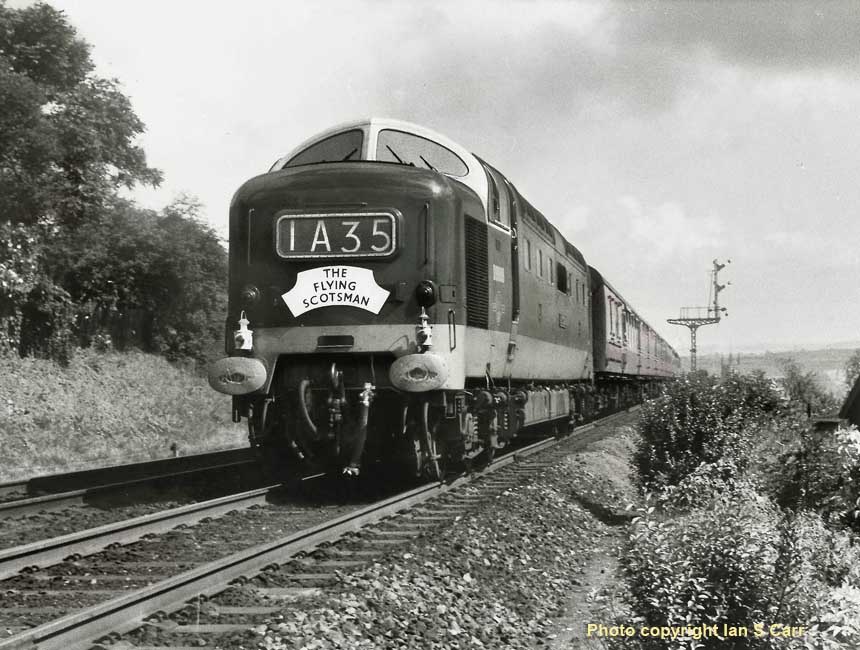
![]()
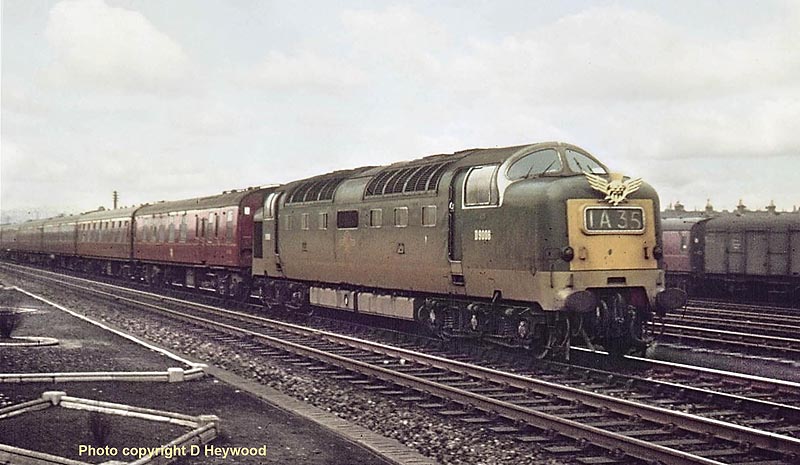
(Above) Enthusiasts expected the new diesel and electric traction to be cleaner than steam, but in 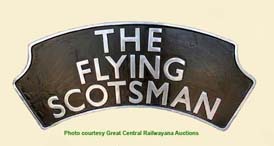 reality this was not the case. Since the new diesel had to work in uncomfortably-close proximity with steam they ended up just as filthy as their predecessors. Many factors can contribute to the general discoloration of paintwork, including the inorganic dust originating from brake shoes which can quickly spread itself as an even layer from rail level upwards. Within a few weeks the dirt eradicated any semblance of a locomotive livery. Already looking worse for wear, the two-tone livery of EE Co Deltic class No D9006 is barely discernible as it heads the 'Flying Scotsman' at York on 23rd June 1964. Introduced to traffic on 29th June 1961 D9006 wasn't named 'The Fife & Forfar Yeomanry' until 5th December 1964
reality this was not the case. Since the new diesel had to work in uncomfortably-close proximity with steam they ended up just as filthy as their predecessors. Many factors can contribute to the general discoloration of paintwork, including the inorganic dust originating from brake shoes which can quickly spread itself as an even layer from rail level upwards. Within a few weeks the dirt eradicated any semblance of a locomotive livery. Already looking worse for wear, the two-tone livery of EE Co Deltic class No D9006 is barely discernible as it heads the 'Flying Scotsman' at York on 23rd June 1964. Introduced to traffic on 29th June 1961 D9006 wasn't named 'The Fife & Forfar Yeomanry' until 5th December 1964 
(Inset-Below) Geordie Wilson from Gateshead shed, tells the story of the Flying Scotsman's wings…he writes - 'When I was a fireman at Gateshead I was on this turn. After coupling up, I went to the  ASM's office at Waverley and collected the wings - they were lightweight, just made of fibreglass and clipped onto the top bracket. It was a windy day and as we passed Marshall Meadows a sudden gust of wind lifted the wings off the bracket and they blew out to sea. When we got to Newcastle the ASM came storming along the platform, demanding to know why we hadn't got the wings on - 'Where the 'ell are they?' he bawled. The driver shrugged nonchalantly - 'You'd better get the Berwick lifeboat out and have a look in the North Sea!' he replied. It later transpired that the bracket was fitted with a grub screw which required tightening up to secure it, but as this involved a spanner it became a fitter's job! (Below) The changing scene at Selby...the Deltic-hauled down 'Flying Scotsman' and an unidentified Class A4 on less demanding freight duties in March 1960.
ASM's office at Waverley and collected the wings - they were lightweight, just made of fibreglass and clipped onto the top bracket. It was a windy day and as we passed Marshall Meadows a sudden gust of wind lifted the wings off the bracket and they blew out to sea. When we got to Newcastle the ASM came storming along the platform, demanding to know why we hadn't got the wings on - 'Where the 'ell are they?' he bawled. The driver shrugged nonchalantly - 'You'd better get the Berwick lifeboat out and have a look in the North Sea!' he replied. It later transpired that the bracket was fitted with a grub screw which required tightening up to secure it, but as this involved a spanner it became a fitter's job! (Below) The changing scene at Selby...the Deltic-hauled down 'Flying Scotsman' and an unidentified Class A4 on less demanding freight duties in March 1960.


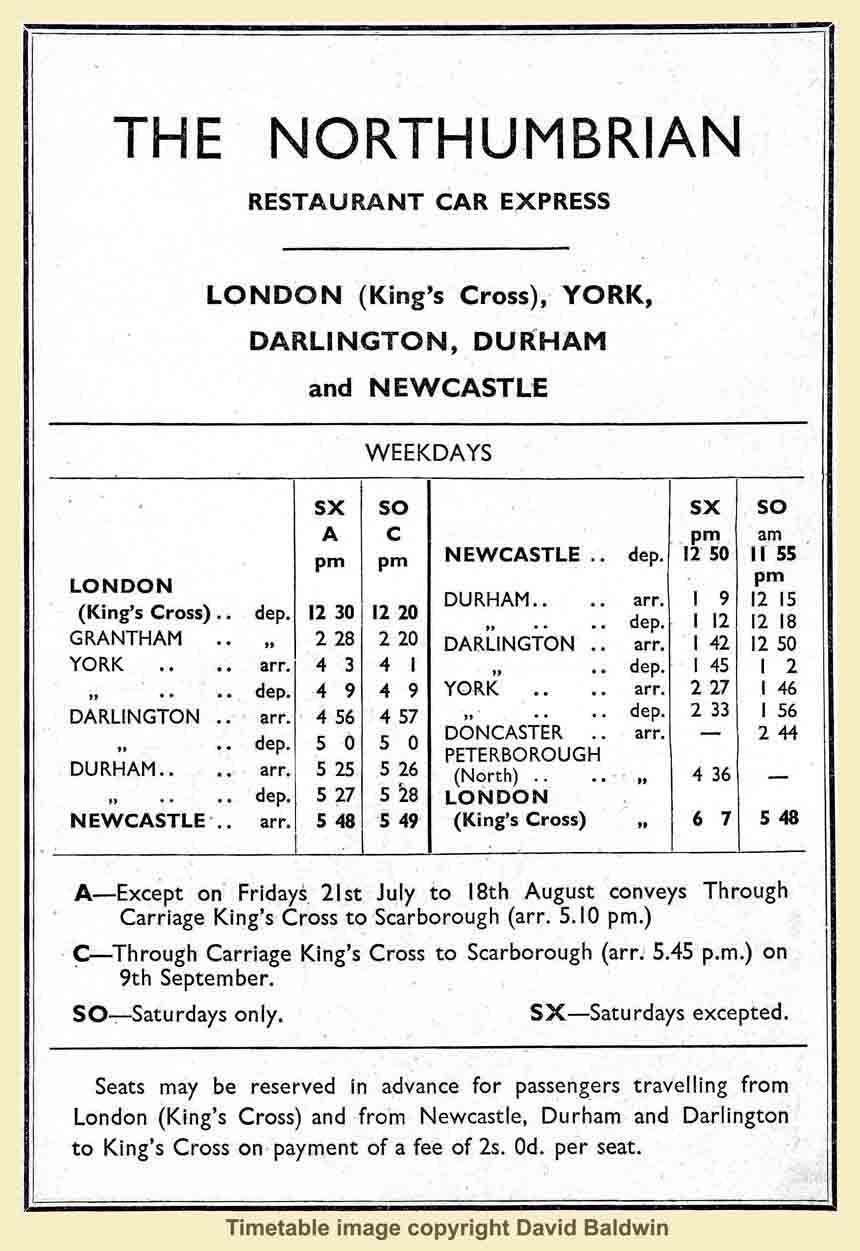
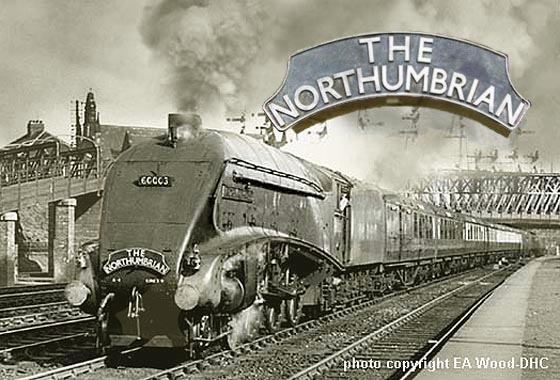
(Above-Inset) The southbound 'Northumbrian' express is headed byClass A4 No 60003 Andrew K McCosh at York in early British Railways blue livery; a portion of the train is made up of BR's new carmine and cream livery for its mainline coaching stock, or 'blood and custard' as it became popularly known. The 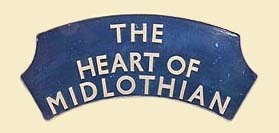 London Kings Cross-Newcastle 'Northumbrian' ran from 26th September 1949 until 13th June 1964. The A4 is sporting the plain cast aluminium headboard (without crests) and only two other headboards of the same dimensions were used: the 'North Briton and the 'Norfolkman'. This headboard went under the hammer for £1550 at a Sheffield Railwayana Auction in September 2008.
London Kings Cross-Newcastle 'Northumbrian' ran from 26th September 1949 until 13th June 1964. The A4 is sporting the plain cast aluminium headboard (without crests) and only two other headboards of the same dimensions were used: the 'North Briton and the 'Norfolkman'. This headboard went under the hammer for £1550 at a Sheffield Railwayana Auction in September 2008.
(Inset Above) The Kings Cross and Edinburgh (Waverley) 'Heart of Midlothian' was introduced on 3rd May 1951 to coincide with the Festival of Britain. The headboard went under the hammer for £2,800 at a GCR Auction in April 2012. The back of the board is marked Return To Grantham MPD, and the front of the plate has been repainted over the original light blue ScR paintwork which is still visible in places underneath. The last titled run of this Anglo-Scottish express was on 4th May 1968.
(Inset Right) The cast  aluminium 'Fair Maid' headboard was carried by the short-lived Kings Cross-Perth express which was inaugurated in 1957 to extend the 'Talisman' north of Edinburgh, but by the autumn of 1958 the through train to Perth was withdrawn from the timetable. The face of the board is restored in light blue, and on the back is displayed the names of other express headboards of the same dimensions such as 'The Comet' and 'The Manxman'.
aluminium 'Fair Maid' headboard was carried by the short-lived Kings Cross-Perth express which was inaugurated in 1957 to extend the 'Talisman' north of Edinburgh, but by the autumn of 1958 the through train to Perth was withdrawn from the timetable. The face of the board is restored in light blue, and on the back is displayed the names of other express headboards of the same dimensions such as 'The Comet' and 'The Manxman'.
(Below) The 'Talisman' was introduced in the summer of 1956 as the post-war successor to the pre-war 'Coronation'; the 'down' train departed Kings Cross at 4:00pm at the same time as the southbound train from Edinburgh. Such was the success of the afternoon train that two additional morning services were introduced in 1957 leaving Kings Cross northbound at 7:45am and Edinburgh southbound at 7:30am. Here No 60029 Woodcock shows her paces on the fast stretch of ECML north of York. 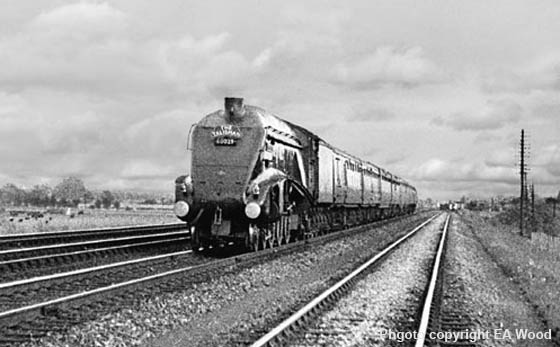
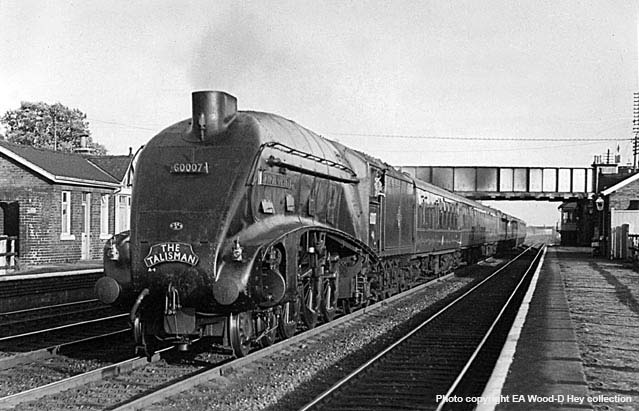
(Above-Below) The 'Talisman' was almost exclusively Class A4 Pacific haulage during steam days. It is the turn for the now-preserved No 60007 Sir Nigel Gresley, seen here racing through Tollerton north of York. (Below) The 'Talisman' name continued throughout the 'Deltic' era and subsequent 1C125 service on the ECML. The northbound morning 'Talisman' heads past Shaftholme Junction box.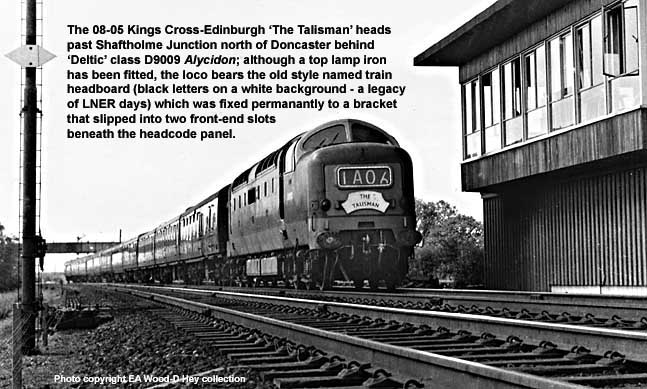
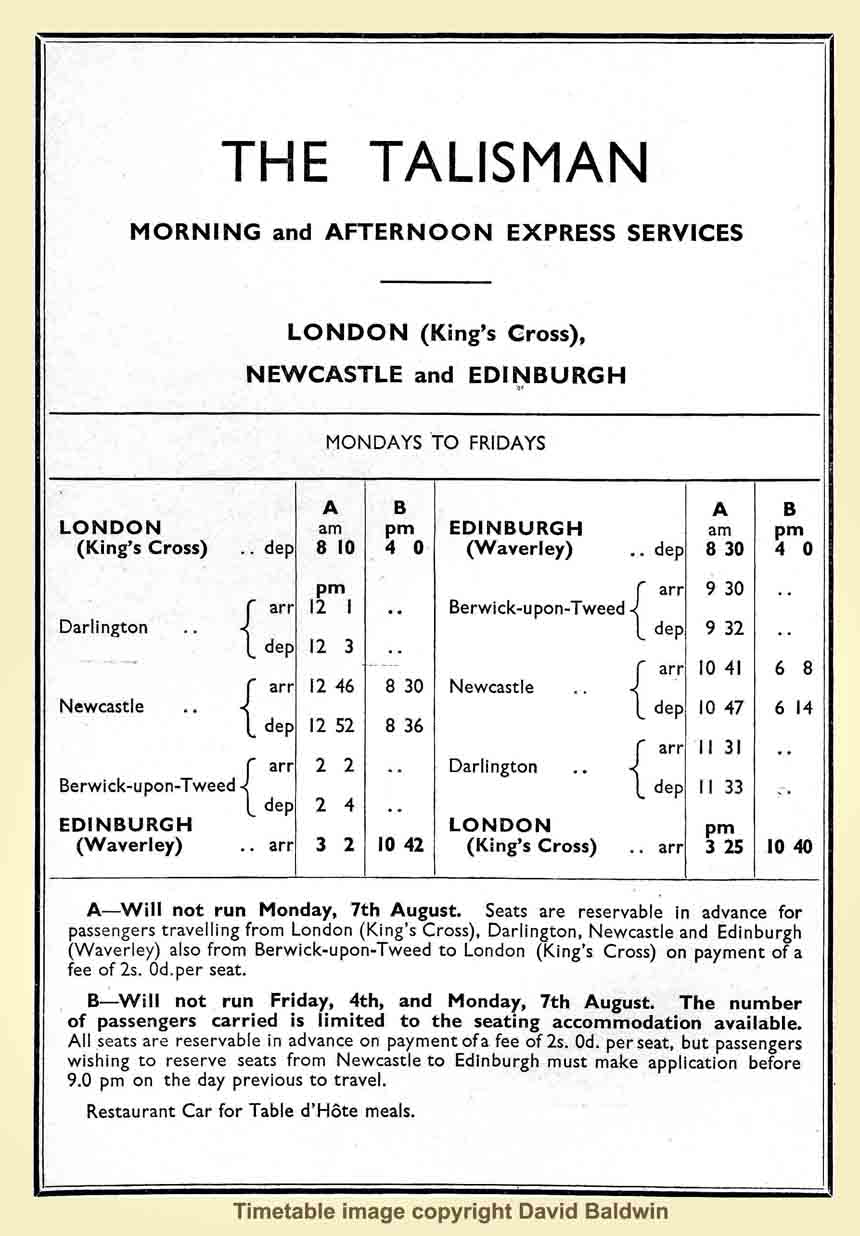
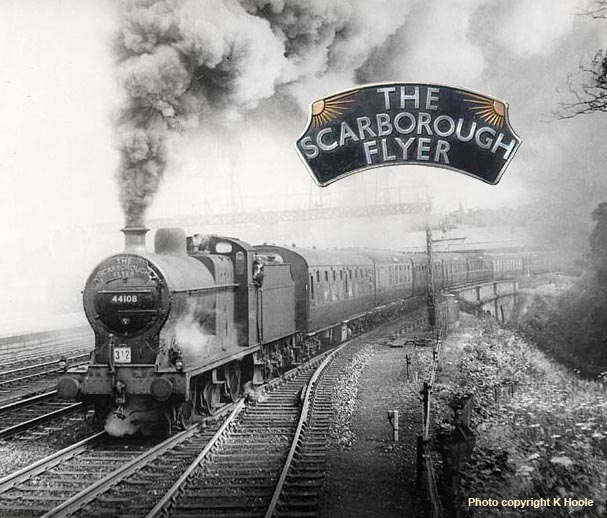
(Above) Following nationalisation of the 'Big Four' railway companies in 1948, many locomotives from an operational standpoint worked beyond their arbitrary Regions, and it was not unusual for former companies engines to work hundreds of miles from the Region they were initially allocated, however this shot of a lowly ex-LMS Class 4F No 44108 working the 'Scarborough Flyer' stumped me for years, until I was contacted by Pete Stellings who wrote: 'The late-Ken Hoole's photo of 4F 44108 departing Scarborough is definitely 'The Scarborough Flyer'...
This working prompted a letter to the authority's from Ken, who took the picture when he presided over the then Scarborough Railway Society (SRS). When Ken took the photo I was sat opposite on the shed adjacent to Washbeck Signal Cabin; this was my usual Saturday morning spot when I was an avid train spotter in the mid 50s. The nominated diagram for the 'Flyer' was the engine used on the early newspaper train from York arriving approx 04.00. This engine then worked the 'Flyer' back to York where a Pacific took over for the remainder of the run to Kings Cross. A variety of motive power has been provided for the 'Flyer', including a Woodford Halse V2 on one occasion, but I am sure a B16/2 or B16/3 was normally diagrammed to fulfil this roll.
York shed must have been scratching for one on this day, so the 4F arrived and was prepared, however the driver said - 'NO I'm not taking that!' and was offered a B16/1 instead.
Perhaps the B16 had a dirty fire or something else was not up to standard because the driver said 'no' to that one as well. I must also mention that he refused to put the headboardon the B16 and threw it on the ground! The 4F duly went down to the station and took out the 'Flyer' with the headboard, and as far as I can recall reached York more or less on time. 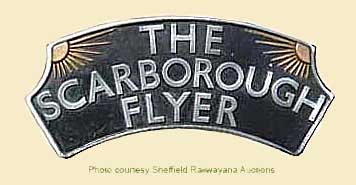 Ken Hoole and others relayed this story at the following SRS meeting, when Ken read out his letter to the authorities, the gist of which said that the stock for the 'Flyer' was cosmopolitan (ie teak and modern stock mixed) and needed upgrading for such a prestigious train. He also added that as the morning newspaper train was not run to a fast timing, the motive power could be a Pacific running tender first (the turntable at Scarborough was too small for turning a Pacific although it managed a Britannia). Ken also suggested that even a V2 would have been more suitable being able to run beyond York. The actual date of the 4F photo slips my memory (see footnote below) though it is documented in 'Trains Illustrated' I suspect 1957/58...'
Ken Hoole and others relayed this story at the following SRS meeting, when Ken read out his letter to the authorities, the gist of which said that the stock for the 'Flyer' was cosmopolitan (ie teak and modern stock mixed) and needed upgrading for such a prestigious train. He also added that as the morning newspaper train was not run to a fast timing, the motive power could be a Pacific running tender first (the turntable at Scarborough was too small for turning a Pacific although it managed a Britannia). Ken also suggested that even a V2 would have been more suitable being able to run beyond York. The actual date of the 4F photo slips my memory (see footnote below) though it is documented in 'Trains Illustrated' I suspect 1957/58...'
(Inset Above Right) A sign of the inflationary times...a letter of receipt for £10 dated 1965 (obtained on purchase by the vendor) accompanied this 'Scarborough Flyer' headboard when it went under the hammer at a Sheffield Railwayan Auction in June 2008. Click here to visit the company's fabulous website.
Footnote: the date of the photo is Saturday 5th July 1958. 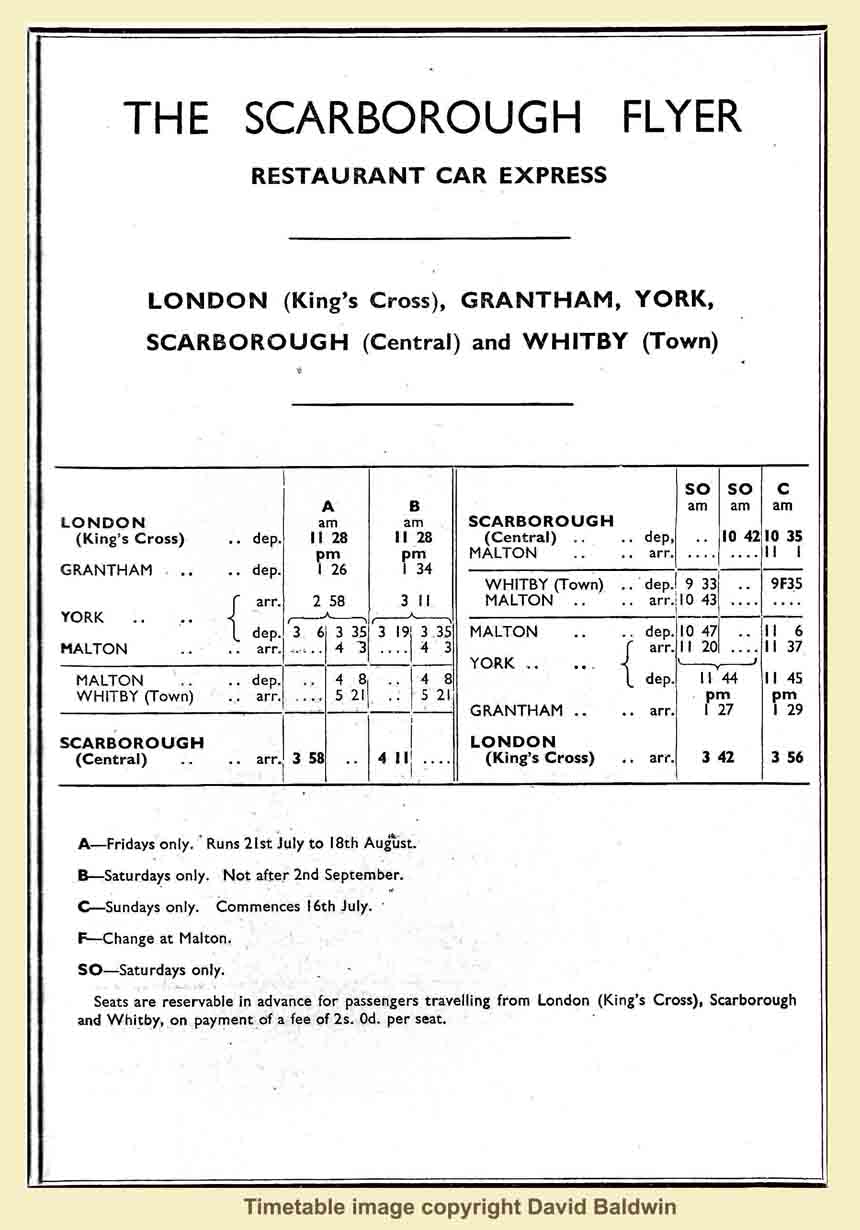
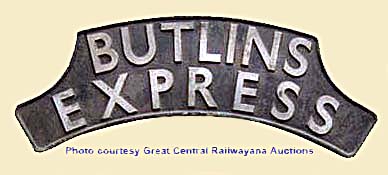 (Inset Left) A locomotive headboard, 'Butlins Express', as used on Great Eastern line trains from Liverpool Street to Clacton-on-Sea for the famous holiday camp in the late 1950s and early Sixties. The cast aluminium headboard with original black paintwork over earlier blue, went under the hammer at a Great Central Railwayana Auction in July 2009; the back of the plate shows the names of other named train headboards of the same dimensions: Granite City, Devonian, Inter-City, White Rose etc. (Below) B1 Class 61179 (sporting a white headboard with black letters) simmers gently at Kings Cross station after working the 12.05pm 'Butlin's Express' from Butlin's Holiday Camp in Skegness on 15th June 1962. The Driver sits on a mail barrow waiting for the locomotive to be released for disposal duties at Top Shed; similarly an unidentified Deltic with the WTT number 1A21 waits to be released from platform 5 after working the 09.55am from Newcastle.
(Inset Left) A locomotive headboard, 'Butlins Express', as used on Great Eastern line trains from Liverpool Street to Clacton-on-Sea for the famous holiday camp in the late 1950s and early Sixties. The cast aluminium headboard with original black paintwork over earlier blue, went under the hammer at a Great Central Railwayana Auction in July 2009; the back of the plate shows the names of other named train headboards of the same dimensions: Granite City, Devonian, Inter-City, White Rose etc. (Below) B1 Class 61179 (sporting a white headboard with black letters) simmers gently at Kings Cross station after working the 12.05pm 'Butlin's Express' from Butlin's Holiday Camp in Skegness on 15th June 1962. The Driver sits on a mail barrow waiting for the locomotive to be released for disposal duties at Top Shed; similarly an unidentified Deltic with the WTT number 1A21 waits to be released from platform 5 after working the 09.55am from Newcastle.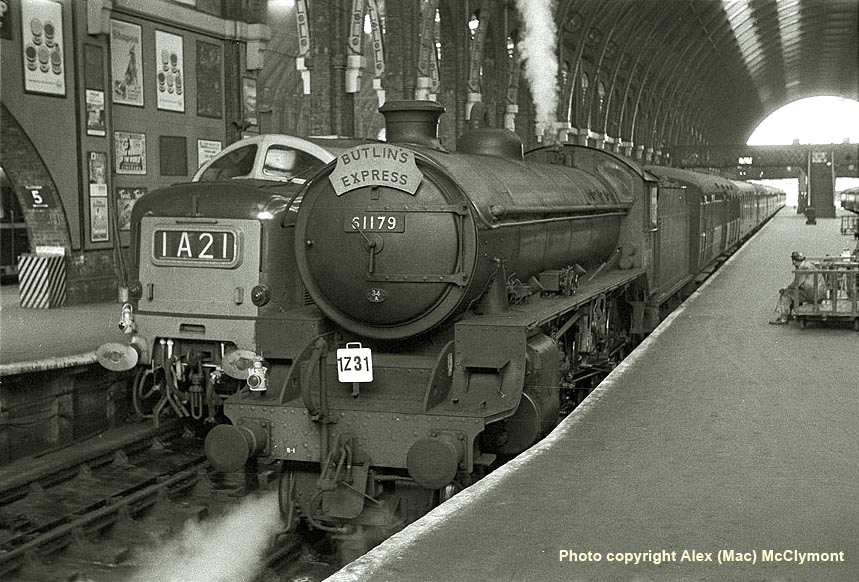
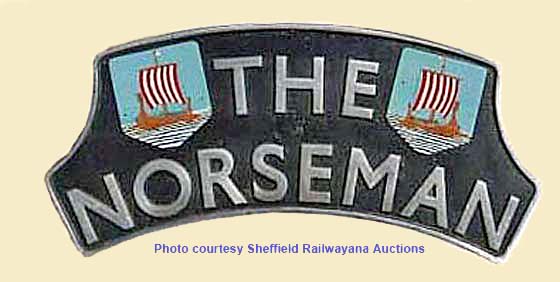
(Above) This decorative cast aluminium 'Norseman' headboard measuring 33" x 12½" has been attractively restored with the letters polished only. The headboard features two enamel vignettes showing a Nordic seaborne sailing boat carrying a raiding party from Scandinavia. The back has a fixing bracket and has been repainted, but a section showing the names of other headboards of the same dimensions has been left untouched. Names such as 'The Scandinavian', 'The Fenman', 'The Easterling', 'The Master Cutler', 'The Aberdonian', 'The Broadsman' and more are all present. The 'Norseman' ran on Wednesdays and Fridays only exclusively for Norwegian boat passengers between Kings Cross and Newcastle Tyne Commission Quay. The service began in the summer of 1950 to the mid-1960s and was one of the fastest expresses on the East Coast Main Line. 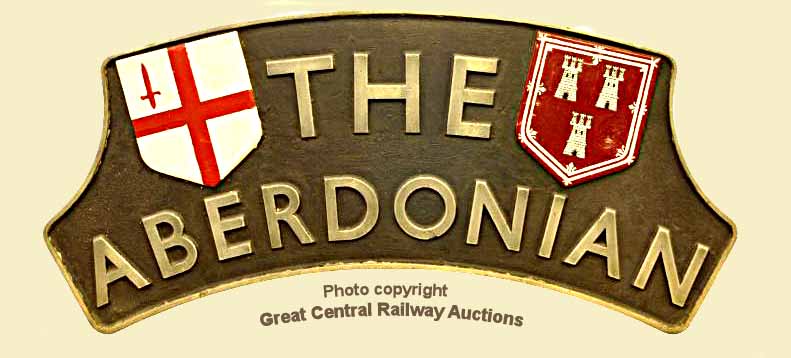
(Above) This is an example of the cast aluminium 'Aberdonian' headboard as carried on the King's Cross to Aberdeen sleeping car service. The train was introduced in July 1927 and continued to run by that name until May 1971. This style of BR headboard, featuring two shields depicting the arms of London and Aberdeen, was introduced in May 1952 and continued to be used until the service was taken over by the Deltic fleet at the start of the Summer timetable in 1962. Most frequently the 'Aberdonian' service was entrusted to the A1 or A2 Class Pacific during steam days. Measuring 33½"x16" this cast aluminium headboard, in original condition, went under the hammer for £3400 at a Great Central Railwayana Auction on 3 September 2016.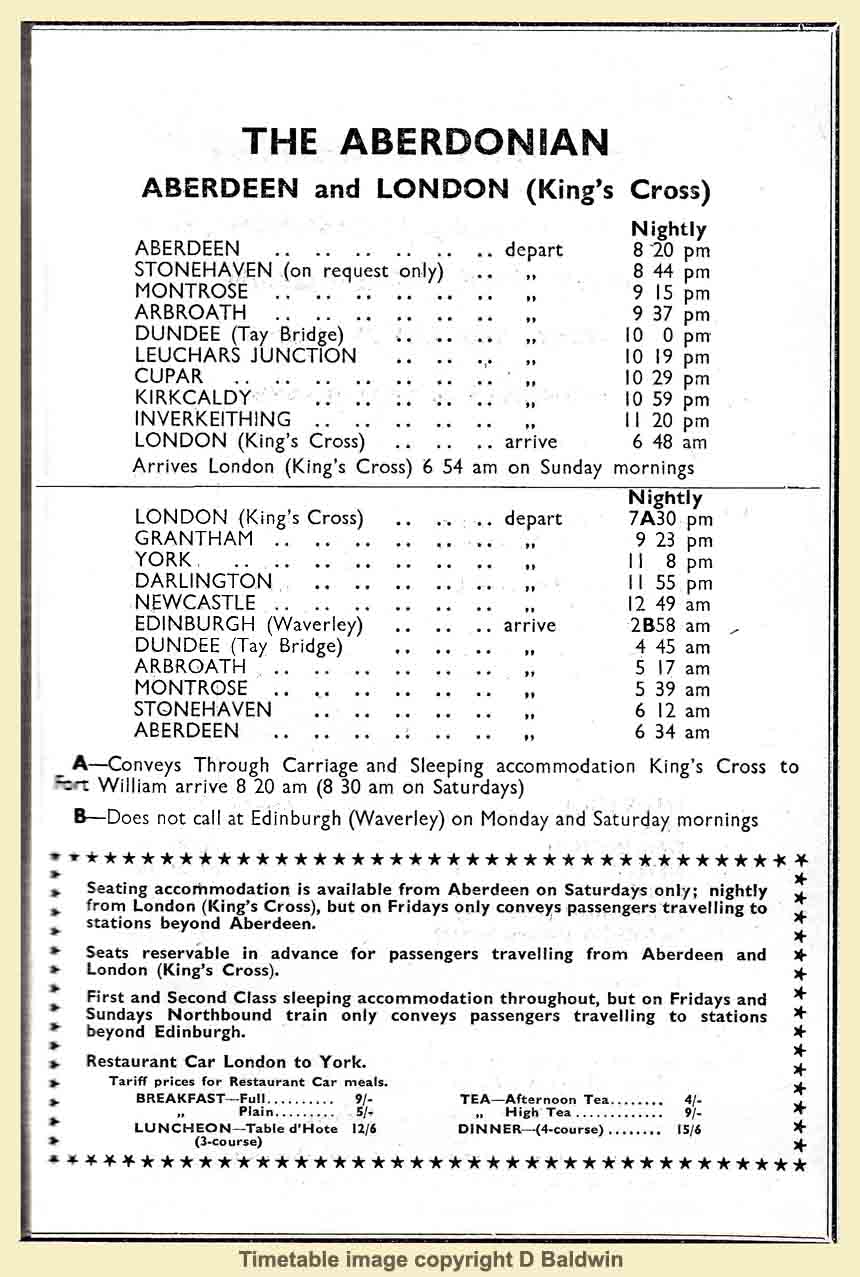
(Inset Right) A raw-looking cast aluminium headboard 'Tees-Tyne Pullman' measuring 40" x 10" shows the front stripped of paint, whereas the back remains in totally ex-loco condition. Traces of the words 'Tees- Tyne Pullman' can be found stamped in the back. Plenty of wear and tear is evident, particularly at the base near the back bracket, where successive drivers have bashed it from below to remove it from the lamp bracket. The 'Tees-Tyne Pullman' operated between Kings Cross and Newcastle-upon-Tyne from 1948 until its withdrawal in 1976 (more Tees-Tyne information below).
Tyne Pullman' can be found stamped in the back. Plenty of wear and tear is evident, particularly at the base near the back bracket, where successive drivers have bashed it from below to remove it from the lamp bracket. The 'Tees-Tyne Pullman' operated between Kings Cross and Newcastle-upon-Tyne from 1948 until its withdrawal in 1976 (more Tees-Tyne information below).
(Above) The 'Master Cutler' has a varied history. This titled train was innaugurated on the London & North Eastern Railway from Sheffield Victoria to Marylebone via the Great Central route in 1947. When the EE Co pilot scheme Type 4s D201/D206-9 arrived at Hornsey (later Finsbury Park) the Eastern Region revived the Pullman service between Kings Cross and Sheffield Victoria. The lightweight 'Master Cutler', 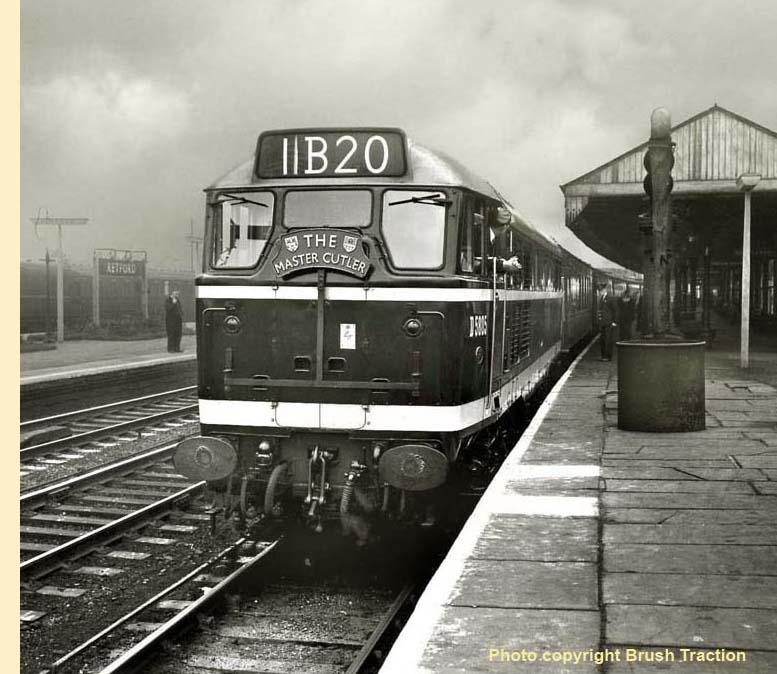 usually made up of six Pullman cars of 250 tons gross tons, ran twice each day with stops at Peterborough, Grantham and Retford. Here, No D207 poses for publicity pictures, whilst (below) sister Type 4 D208 heads the down train out of Retford to gain the Sheffield lines in April 1959. A typical diagram for the Hornsey Type 4s was the down 'Master Cutler out of Kings Cross and the next morning's 07.20 return from Sheffied Victoria, spending their time in the Yorkshire area with overnight freight workings to and from Annesly yard, Nottingham.
usually made up of six Pullman cars of 250 tons gross tons, ran twice each day with stops at Peterborough, Grantham and Retford. Here, No D207 poses for publicity pictures, whilst (below) sister Type 4 D208 heads the down train out of Retford to gain the Sheffield lines in April 1959. A typical diagram for the Hornsey Type 4s was the down 'Master Cutler out of Kings Cross and the next morning's 07.20 return from Sheffied Victoria, spending their time in the Yorkshire area with overnight freight workings to and from Annesly yard, Nottingham.
(Inset) The lightweight Pullman's schedule was well within the capabilities of the less-powerful Brush Type 2s. Here the driver of No D5805 awaits the right away with the 07.20 Sheffield Victoria-London Kings Cross 'Master Cutler' at Retford on November 16th 1961. Following abolition of the headcode disc system for train identification, four-character headcode boxes began to appear on the cab roofs on Brush's 243 production machines, however supply problems saw this modification fitted at random sequences during construction and old-style roofs continued to appear on some locomotives, dubbed 'Skinheads' by enthusiasts. The ER fitted brackets onto the lamp irons of their allocation to allow a named train headboard to be carried. The 'Master Cutler' name is still used today on the morning 'up' and evening 'down' service in each direction between Sheffield Midland and St Pancras operated by East Midlands Trains.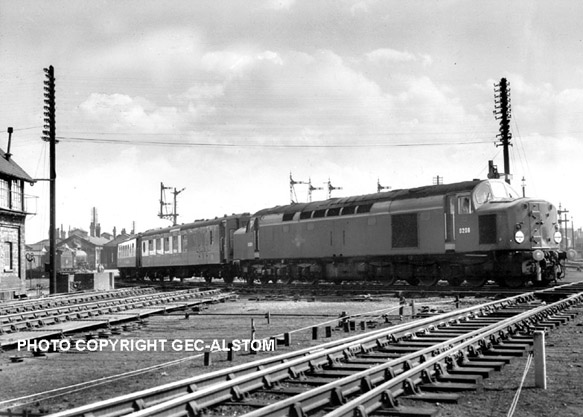
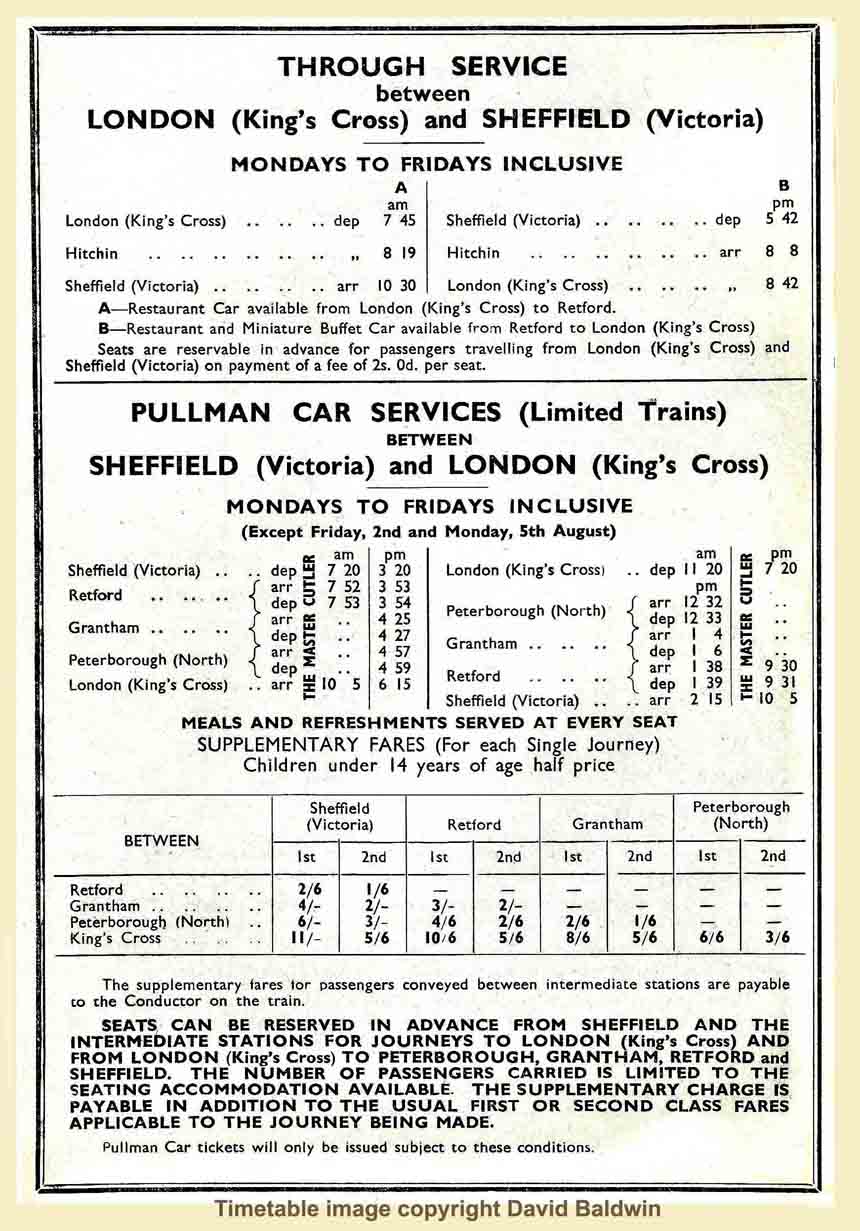
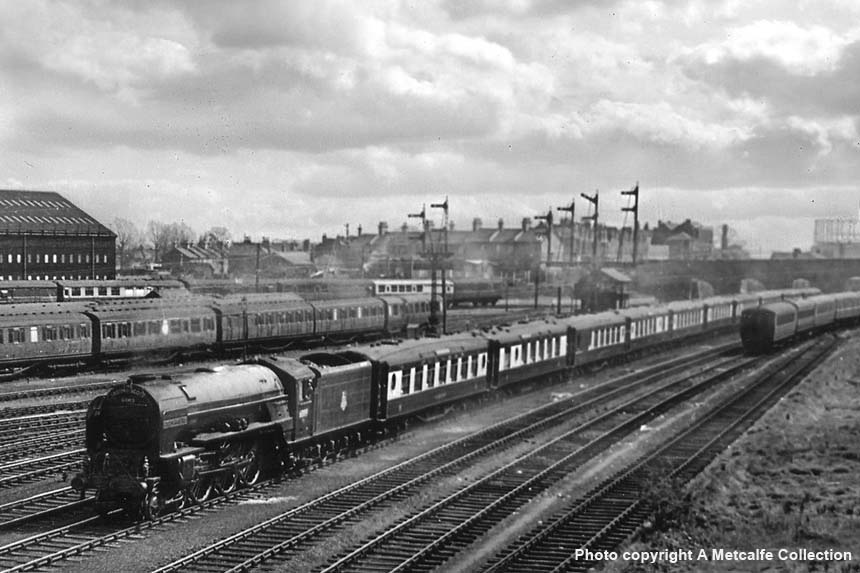
(Above-Inset-Below) Staying with ECML Pullman trains, Class A1 No 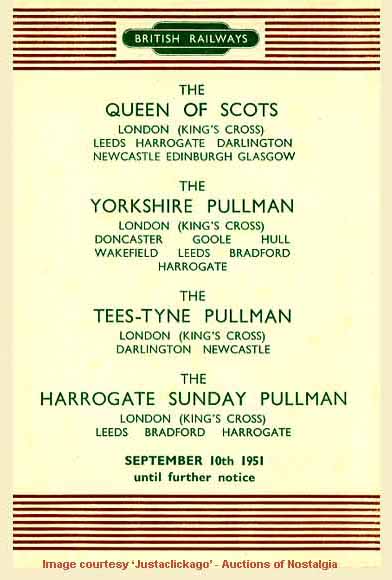 60117 Bois Roussel heads the northbound 'Queen of Scots Pullman at the start of the journey from London Kings Cross and Glasgow Queen Street. Four loco depots provided Pacific engines for this 451 mile run: Haymarket, Heaton and Neville Hill produced a Class A3 for the various legs north of Leeds, whereas Copley Hill provided a Class A1 Pacific for the journey between Kings Cross and Leeds Central in both directions. The Pullman train was usually made up of eight cars north of Leeds, whereas the Leeds-Kings Cross run had ten cars weighing some 400 tons, the two additional cars being attached at Leeds Central where the train reversed. The additional cars can be seen in this inset (right) of Class A1 Pacific No 60118 - later to be named Archibald Sturrock - getting to grips with the climb out of Leeds Central through Holbeck High Level with the southbound train for Kings Cross.The loco is sporting the earlier headboard with black letters on a white background. (Below) Similarly, the two additional cars can be seen immediately behind Peak class No D170 (later TOPS Class 46 No 46033) as it approaches Wortley South Junction with the 'Queen of Scots' from
60117 Bois Roussel heads the northbound 'Queen of Scots Pullman at the start of the journey from London Kings Cross and Glasgow Queen Street. Four loco depots provided Pacific engines for this 451 mile run: Haymarket, Heaton and Neville Hill produced a Class A3 for the various legs north of Leeds, whereas Copley Hill provided a Class A1 Pacific for the journey between Kings Cross and Leeds Central in both directions. The Pullman train was usually made up of eight cars north of Leeds, whereas the Leeds-Kings Cross run had ten cars weighing some 400 tons, the two additional cars being attached at Leeds Central where the train reversed. The additional cars can be seen in this inset (right) of Class A1 Pacific No 60118 - later to be named Archibald Sturrock - getting to grips with the climb out of Leeds Central through Holbeck High Level with the southbound train for Kings Cross.The loco is sporting the earlier headboard with black letters on a white background. (Below) Similarly, the two additional cars can be seen immediately behind Peak class No D170 (later TOPS Class 46 No 46033) as it approaches Wortley South Junction with the 'Queen of Scots' from 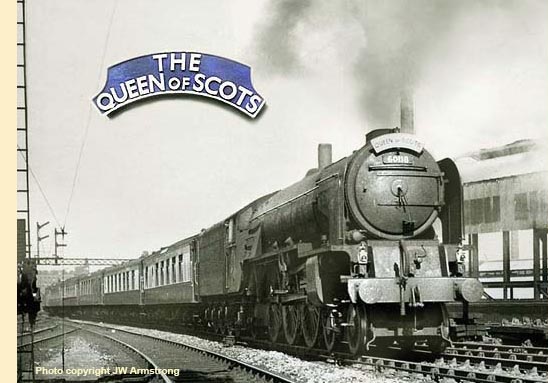 Kings Cross. The train is made up of an almost uniform rake of the new Metro-Cammel Pullman cars, first introduced on the London-Sheffield 'Master Cutler' Pullman in September 1960. They appeared on the 'Yorkshire Pullman' and 'Tees-Tyne' Pullman duties in January the following year. The 44 vehicles were used entirely on the East Coast main line services, but as no Pullman brake cars were built in the same order, the elderly flat-sided Pullman brakes were utilised, in this case situated the third vehicle from the front.
Kings Cross. The train is made up of an almost uniform rake of the new Metro-Cammel Pullman cars, first introduced on the London-Sheffield 'Master Cutler' Pullman in September 1960. They appeared on the 'Yorkshire Pullman' and 'Tees-Tyne' Pullman duties in January the following year. The 44 vehicles were used entirely on the East Coast main line services, but as no Pullman brake cars were built in the same order, the elderly flat-sided Pullman brakes were utilised, in this case situated the third vehicle from the front. 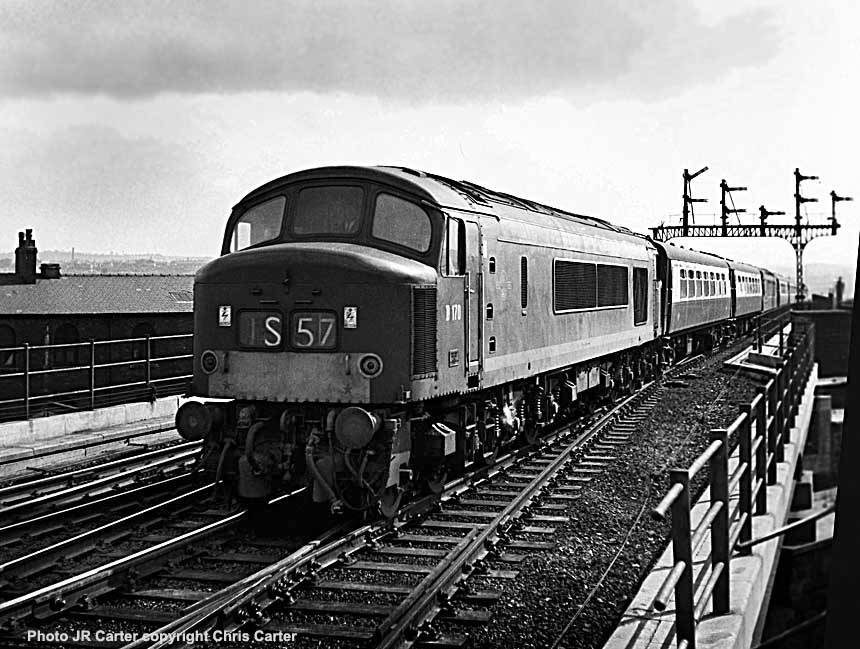
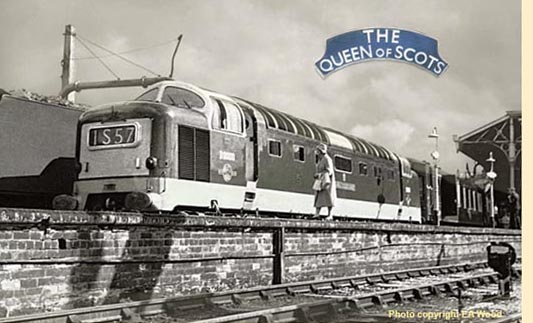 (Inset Left-Right) Albeit there's no headboard on the nose-end there is no mistaking the famous headcode - 1S57 northbound 'Queen of Scots' - displayed in the route indicator panel of the now-preserved EE Deltic class D9000 (TOPS Class 55022) during an obligatory stop at Harrogate. Some wag tells me the lady in the photo is asking the driver if the train stops at Poppleton! (Inset Below Right) A locomotive headboard 'The Queen of Scots' as used on the Pullman Car train which ran from Kings Cross to Glasgow Central via Leeds Central, where it reversed, and Edinburgh Waverley. This style of headboard was introduced in 1949 and carried by Class A1 and A3 Pacifics until the end of steam haulage. The cast aluminium headboard measures 41" X 10", with the front repainted in the Scottish Region blue. This lot sold for £4000 at April 2009. (Bottom) Echoes of childhood spotting days on the Leeds-Harrogate line during the 1950s. The 1S57 northbound 'Queen of Scots' Pullman tops the
(Inset Left-Right) Albeit there's no headboard on the nose-end there is no mistaking the famous headcode - 1S57 northbound 'Queen of Scots' - displayed in the route indicator panel of the now-preserved EE Deltic class D9000 (TOPS Class 55022) during an obligatory stop at Harrogate. Some wag tells me the lady in the photo is asking the driver if the train stops at Poppleton! (Inset Below Right) A locomotive headboard 'The Queen of Scots' as used on the Pullman Car train which ran from Kings Cross to Glasgow Central via Leeds Central, where it reversed, and Edinburgh Waverley. This style of headboard was introduced in 1949 and carried by Class A1 and A3 Pacifics until the end of steam haulage. The cast aluminium headboard measures 41" X 10", with the front repainted in the Scottish Region blue. This lot sold for £4000 at April 2009. (Bottom) Echoes of childhood spotting days on the Leeds-Harrogate line during the 1950s. The 1S57 northbound 'Queen of Scots' Pullman tops the 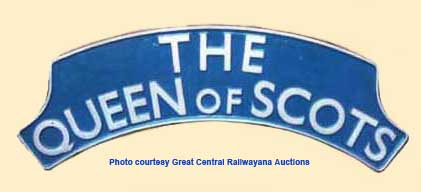 summit of Headingley Bank just north of Horsforth station in July 1962. The 'Queen of Scots' was the most luxurious train on the Leeds-Harrogate line - and what luxury! The carriages had electric table lamps, which left an indelible impression on this youngster in the early Fifties. We lived in a house without electricity until 1954, and so there were no labour-saving devices such as fridge-freezers, vacuum cleaners and washing machines. Instead the household chores had to be done the hard way, especially on a washday. First a peggy tub was filled with hot water from the gas boiler. Then, as the dirtiest clothes soaked, the more stubborn stains were removed on a scrubbing board followed by strenuous possing before the heavy sheets and towels were rinsed in a stone sink, the whites soaked in water laced with Dolly Blue. Then, the clothes were squeezed through a mangle and 'pegged' out to dry on the washing line - what a palaver!
summit of Headingley Bank just north of Horsforth station in July 1962. The 'Queen of Scots' was the most luxurious train on the Leeds-Harrogate line - and what luxury! The carriages had electric table lamps, which left an indelible impression on this youngster in the early Fifties. We lived in a house without electricity until 1954, and so there were no labour-saving devices such as fridge-freezers, vacuum cleaners and washing machines. Instead the household chores had to be done the hard way, especially on a washday. First a peggy tub was filled with hot water from the gas boiler. Then, as the dirtiest clothes soaked, the more stubborn stains were removed on a scrubbing board followed by strenuous possing before the heavy sheets and towels were rinsed in a stone sink, the whites soaked in water laced with Dolly Blue. Then, the clothes were squeezed through a mangle and 'pegged' out to dry on the washing line - what a palaver! 
![]()

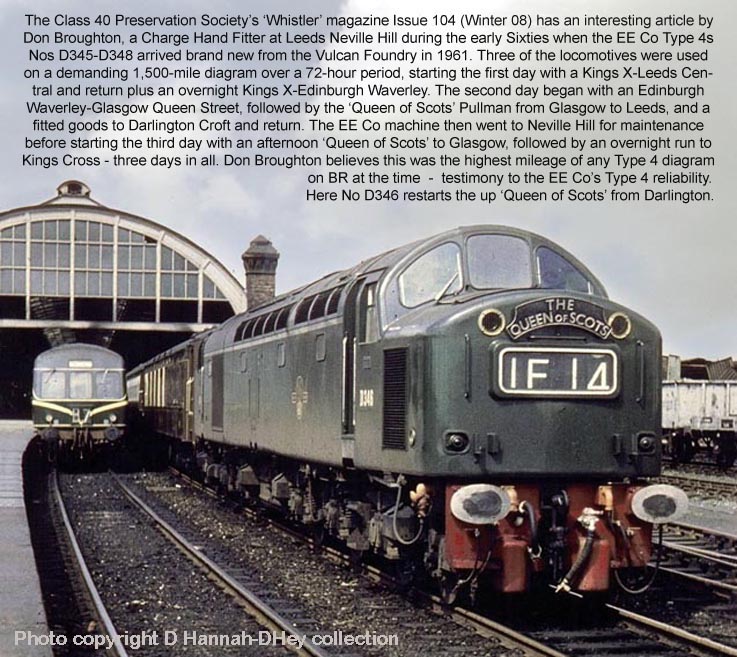
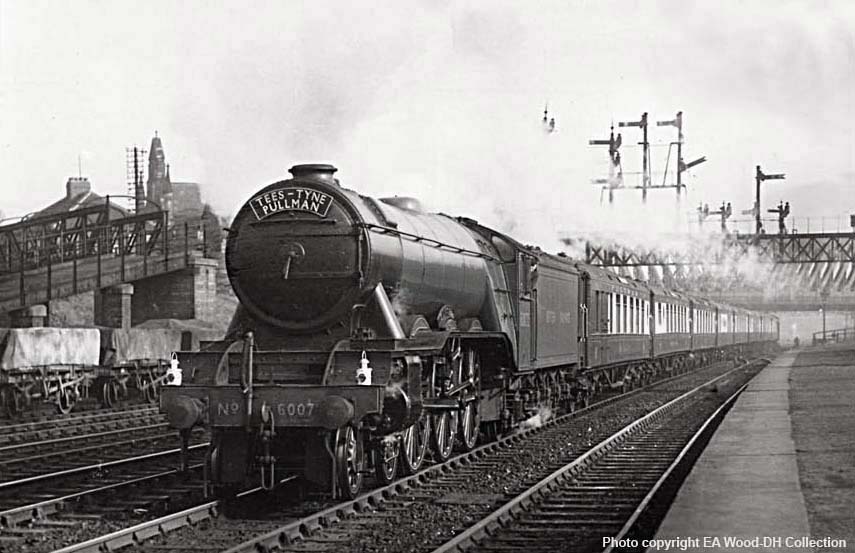
(Above-Inset right) After nationalisation in 1948, the newly-formed British Railways began experimenting with a number of liveries with a view to adopting a future standard for its express-passenger engines of a Class 8 power classification (dark blue) and for its fleet of express-passenger locomotives with a lower tractive effort (light green). Eventually a lighter shade of blue was chosen for its large express locos, which  included the ex-SR 'Merchant Navy', the ex-LMSR Pacifics, the ex-GWR 'King' class 4-6-0s and the Peppercorn and Gresley Pacifics of the Eastern and North Eastern Regions. The repainting was started before the first British Railways totem device had been designed and BRITISH RAILWAYS was painted in full on the tender sides. Still awaiting its new five-digit smokebox numberplate, Class A3 No 60072 Sunstar heads the southbound Tees-Tyne Pullman out of York. For the record, the London King's Cross to Newcastle-upon-Tyne 'Tees-Tyne Pullman' was introduced in 1948. (Inset Right) Class A4 No 60034 Lord Faringdon heads the northbound Tees-Tyne Pullman through Hitchen in 1960.
included the ex-SR 'Merchant Navy', the ex-LMSR Pacifics, the ex-GWR 'King' class 4-6-0s and the Peppercorn and Gresley Pacifics of the Eastern and North Eastern Regions. The repainting was started before the first British Railways totem device had been designed and BRITISH RAILWAYS was painted in full on the tender sides. Still awaiting its new five-digit smokebox numberplate, Class A3 No 60072 Sunstar heads the southbound Tees-Tyne Pullman out of York. For the record, the London King's Cross to Newcastle-upon-Tyne 'Tees-Tyne Pullman' was introduced in 1948. (Inset Right) Class A4 No 60034 Lord Faringdon heads the northbound Tees-Tyne Pullman through Hitchen in 1960. 
(Inset Below) When the British Transport Commission aquired the Pullman Car Company in 1954, the company's elderly stock of Pullman cars was in urgent need of replacement. In order to conciliate the exacting demands of this niche First-class service, the BTC decided to modernise the Pullman fleet as part of the 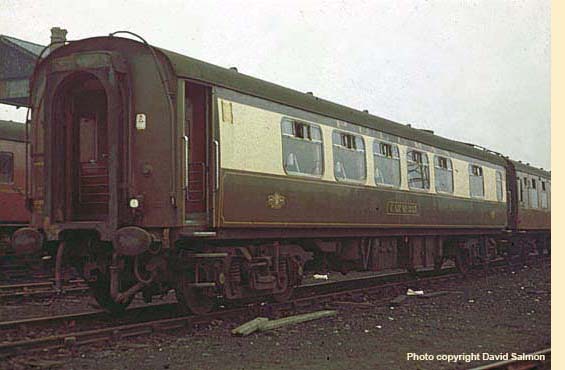 1955 Modernisation Plan. The proposed new rolling stock included the introduction of a radically new diesel multiple-unit Blue Pullman service comprised of 36 vehicles, forerunner of the 1C125 fleet. Surprisingly, the LMR's new 'Midland Pullman' service between Manchester Central and London St Pancras, and the WR's 'Birmingham Pullman' from Wolverhampton Low Level to London Paddington, appeared in a striking Nanking Blue and cream livery rather than the traditional umber and cream Pullman colours. In 1960-61, Metro-Cammell received an order for 44 new loco-hauled Pullman cars for East Coast Main Line Pullman services. These were based on the BR's Mk 1 design, followed in 1966 by an additional 29 cars, based on the BR Mk 2 design to be used on a new Manchester Pullman and Liverpool Pullman service over the newly electrified West Coast Main Line to Euston, replacing the Blue Pullman service between Manchester Central and St Pancras via the Midlands. The LMR's redundant Blue Pullman sets were allocated to the Western Region in 1969. However, in spite of investment in new carriages the Pullmans were in gradual decline due largely to increased competition from domestic air travel together with substantial improvements made by BR its normal services comprised of ordinary Mark 2 stock. This included air-conditioning as standard in both first and second class. By the 1970s the non-air conditioned Pullman carriages were becoming dated compared to the newer British Rail Mark 2 carriages, and with the imminent introduction of InterCity 125 trains, the Tees-Tyne Pullman was finally withdrawn in 1976.(Below) Class A4 No 60032 heads the northbound Pullman through Tollerton.
1955 Modernisation Plan. The proposed new rolling stock included the introduction of a radically new diesel multiple-unit Blue Pullman service comprised of 36 vehicles, forerunner of the 1C125 fleet. Surprisingly, the LMR's new 'Midland Pullman' service between Manchester Central and London St Pancras, and the WR's 'Birmingham Pullman' from Wolverhampton Low Level to London Paddington, appeared in a striking Nanking Blue and cream livery rather than the traditional umber and cream Pullman colours. In 1960-61, Metro-Cammell received an order for 44 new loco-hauled Pullman cars for East Coast Main Line Pullman services. These were based on the BR's Mk 1 design, followed in 1966 by an additional 29 cars, based on the BR Mk 2 design to be used on a new Manchester Pullman and Liverpool Pullman service over the newly electrified West Coast Main Line to Euston, replacing the Blue Pullman service between Manchester Central and St Pancras via the Midlands. The LMR's redundant Blue Pullman sets were allocated to the Western Region in 1969. However, in spite of investment in new carriages the Pullmans were in gradual decline due largely to increased competition from domestic air travel together with substantial improvements made by BR its normal services comprised of ordinary Mark 2 stock. This included air-conditioning as standard in both first and second class. By the 1970s the non-air conditioned Pullman carriages were becoming dated compared to the newer British Rail Mark 2 carriages, and with the imminent introduction of InterCity 125 trains, the Tees-Tyne Pullman was finally withdrawn in 1976.(Below) Class A4 No 60032 heads the northbound Pullman through Tollerton. 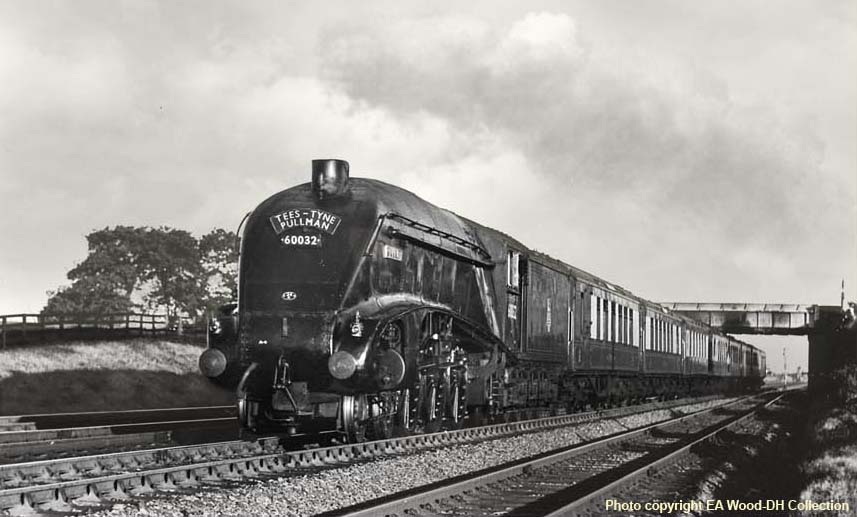
 (Inset Left-Below) Peppercorn's Class A1 No 60158 (later to be named Aberdonian) heads the 'Tees-Tyne' Pullman north of York. BR Fitter, Chris Boylan, writes - ' I believe 60158 was a Doncaster engine; a worthy successor to Gresley's A4s, and capable of 100mph running. If an A1 started riding roughly the only way to deal with that problem was to drop the reversing gear down from 15% to 40% and keep the regulator wide open. If you want a side-splitter try this one for size. Mr Potter was heading for Edinburgh with his mate Albert, and on approaching Lucker Troughs his mate told him to be ready to drop the scoop to pick up water. Alan duly obliged, but when he lifted the scoop and opened the test valves there was no water! The result of this faux par is that they had to make an unscheduled stop at Berwick, and to their amazement they found that the water scoop had been removed! This was a classic example of a breakdown in communications…' (Below) EE Type 4 take over the helm.
(Inset Left-Below) Peppercorn's Class A1 No 60158 (later to be named Aberdonian) heads the 'Tees-Tyne' Pullman north of York. BR Fitter, Chris Boylan, writes - ' I believe 60158 was a Doncaster engine; a worthy successor to Gresley's A4s, and capable of 100mph running. If an A1 started riding roughly the only way to deal with that problem was to drop the reversing gear down from 15% to 40% and keep the regulator wide open. If you want a side-splitter try this one for size. Mr Potter was heading for Edinburgh with his mate Albert, and on approaching Lucker Troughs his mate told him to be ready to drop the scoop to pick up water. Alan duly obliged, but when he lifted the scoop and opened the test valves there was no water! The result of this faux par is that they had to make an unscheduled stop at Berwick, and to their amazement they found that the water scoop had been removed! This was a classic example of a breakdown in communications…' (Below) EE Type 4 take over the helm. 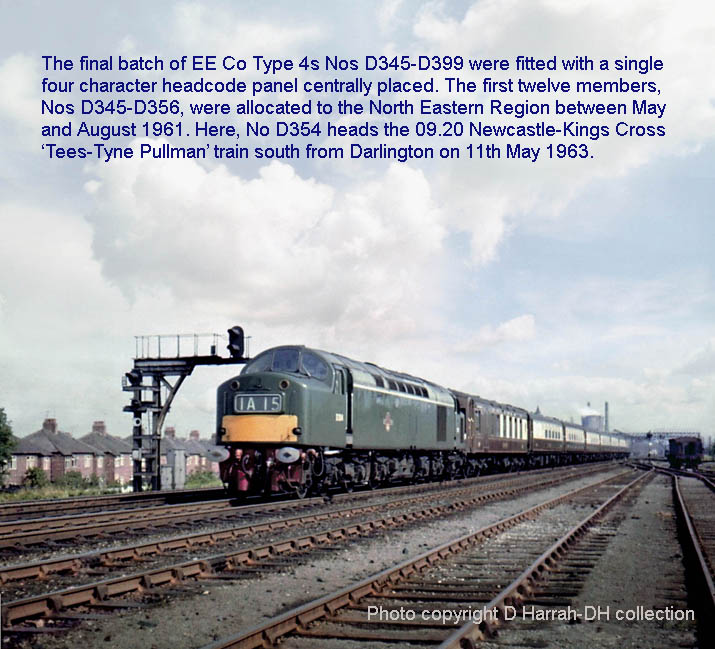

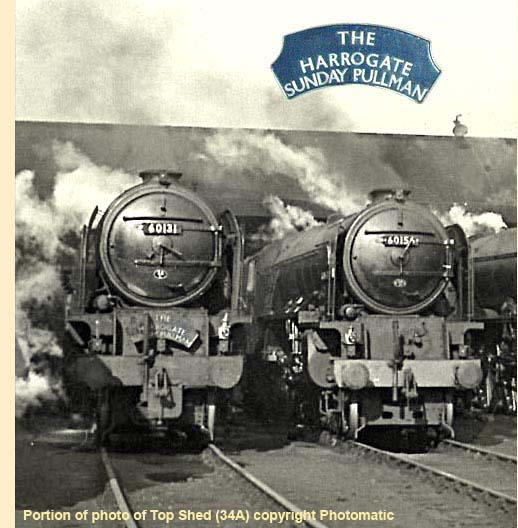 Above-Below) Built at Darlington in October 1948, Class A1 Pacific No 60133 Pommern makes a fine sight on the southbound 'Yorkshire Pullman' at Great Ponton on 20th August 1952. A Copley Hill shed (56C) for much of its life, 60133 was regularly used on the Kings Cross service out of Leeds, and was the first of 13 members of the class to be named after a thoroughbred racehorse. The inserted locomotive headboard was used on this luxury Pullmam service from Kings Cross to Leeds and Harrogate, with portions for Hull and Bradford.This board is cast aluminium 39¾" wide with integral bracket to the rear, and went under the hammer at a recent Great Central Railwayana Auction. The Yorkshire Pullman (London King's Cross-Harrogate and Hull Paragon (up to 1967), ended its days in 1978. (Below)
Above-Below) Built at Darlington in October 1948, Class A1 Pacific No 60133 Pommern makes a fine sight on the southbound 'Yorkshire Pullman' at Great Ponton on 20th August 1952. A Copley Hill shed (56C) for much of its life, 60133 was regularly used on the Kings Cross service out of Leeds, and was the first of 13 members of the class to be named after a thoroughbred racehorse. The inserted locomotive headboard was used on this luxury Pullmam service from Kings Cross to Leeds and Harrogate, with portions for Hull and Bradford.This board is cast aluminium 39¾" wide with integral bracket to the rear, and went under the hammer at a recent Great Central Railwayana Auction. The Yorkshire Pullman (London King's Cross-Harrogate and Hull Paragon (up to 1967), ended its days in 1978. (Below)![]()

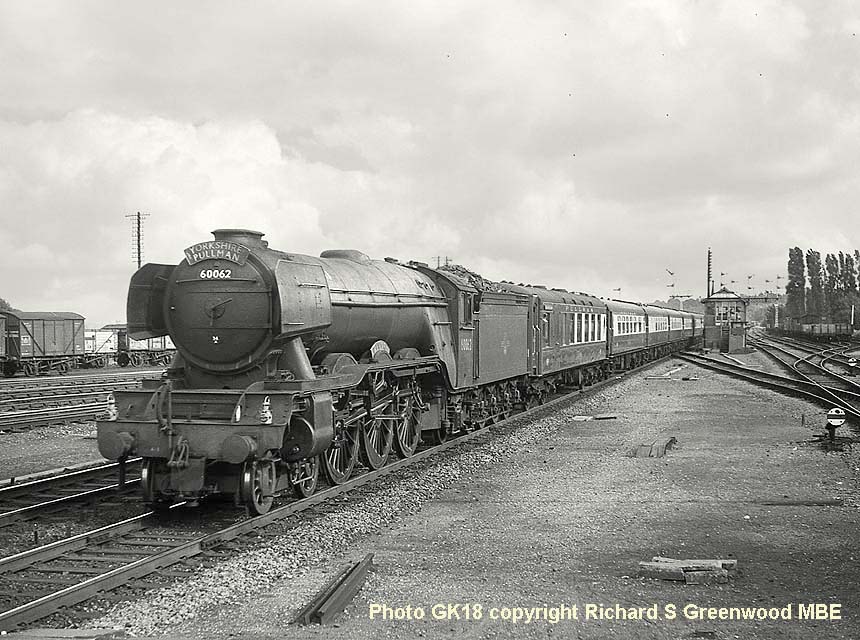
(Above) Class A3 No 60062 Minoru is seen heading the northbound 'Yorkshire Pullman' with newly-fitted German smoke deflectors in place. Built at Doncaster Works as A1 Class No 2561 in May 1925, the loco was rebuilt as an A3 in June 1944 and renumbered 62 in October 1946, later BR 60063. Allocated new to Gorton, it had no fewer than sixteen shed changes, including three spells at Doncaster, the same again at Grantham and New England, and four times at Kings Cross, before returning to Gorton, and then on to Haymarket, followed by a stint at Copley Hill and finally New England from where it was withdrawn in December 1964, doubtless suffering post traumatic stress disorder from all the moving around it did! The A3 was cut up by Kings of Norwich the following March. For the record, 60063 was named Minoru after the racehorse owned by HM King Edward which won the 1909 Derby and 2000 Guineas. 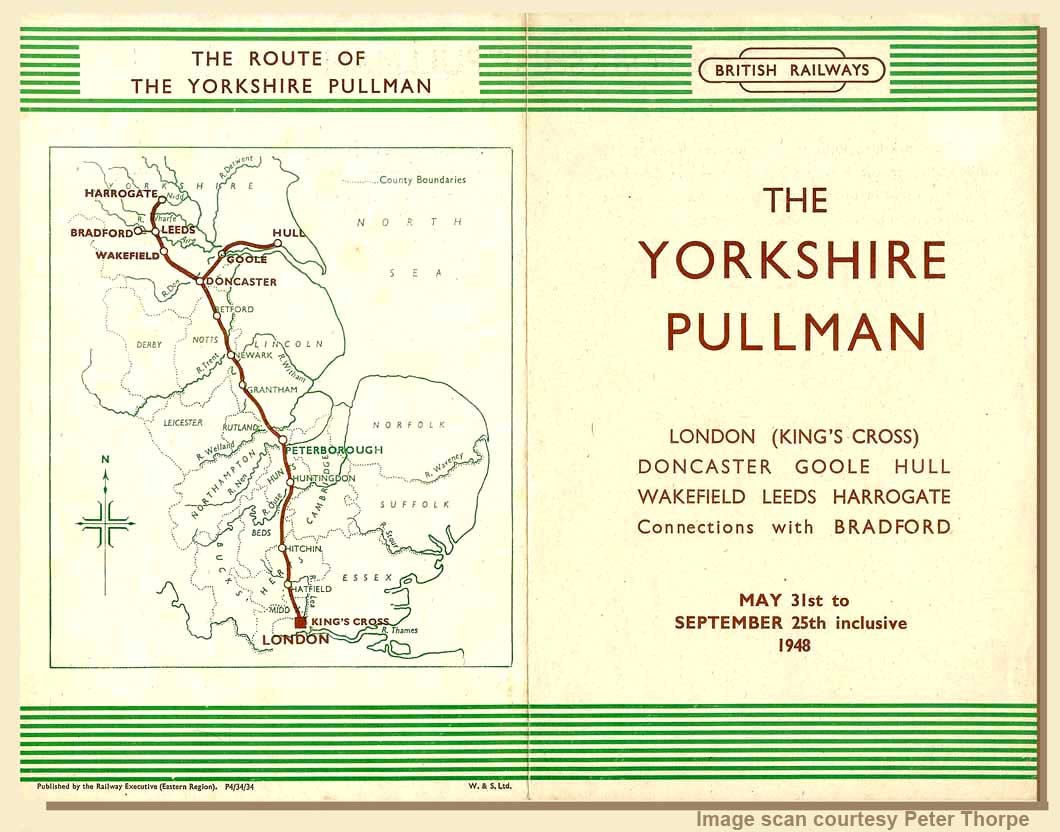
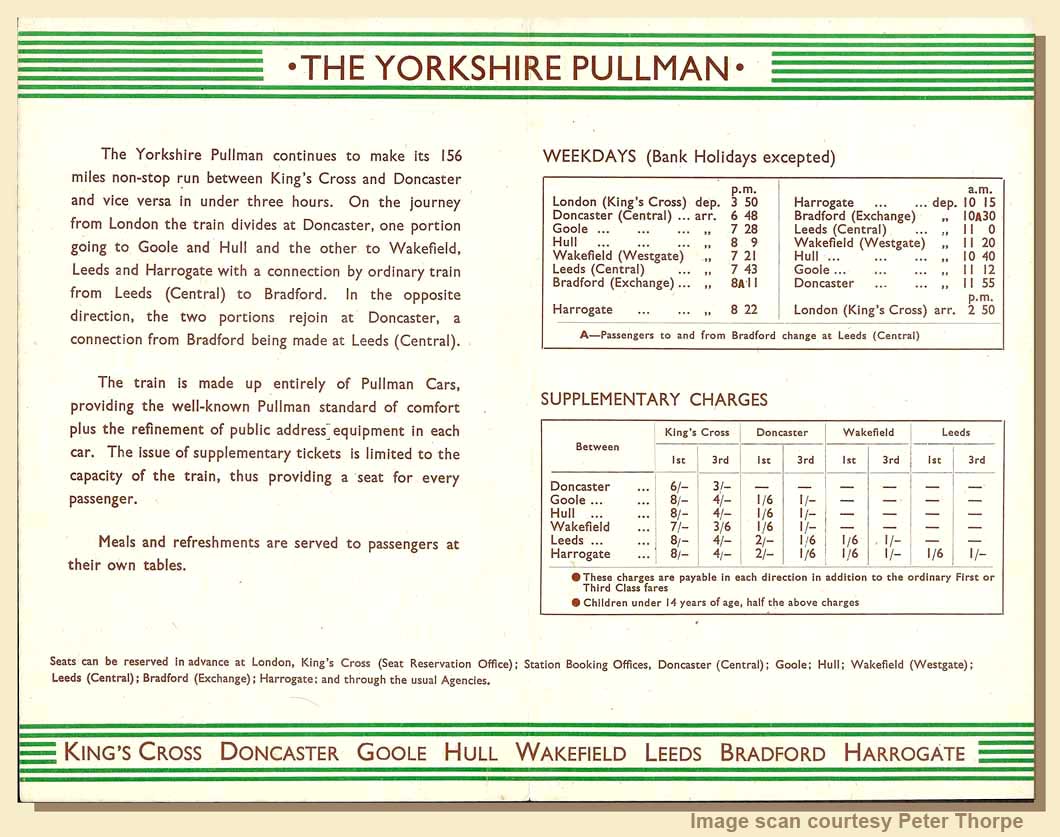
(Below) The new Brush Type 4s (total built 512) appeared in a pleasing two tone green livery incorporating a yellow visual warning panel on the front ends. The radiator grilles in the roof section at cantrail level were later replaced with hydraulically operated slats controlled by a thermostat which opened and closed the aperture to allow for greater cooling. The Brush machines (later Class 47s) were widely used across the railway network not only to replace steam but to substitute the 'First-Generation' diesels and as a consequence their initial batch allocations were quickly eradicated. Here No D1571 (later 47545) heads the 'up' 'Yorkshire Pullman' past Beeston Junction in May 1965. The titled train was withdrawn in May 1978, to be re-instated seven years later with the introduction of a new Pullman service made up of a refurbished High Speed Train (1C125). 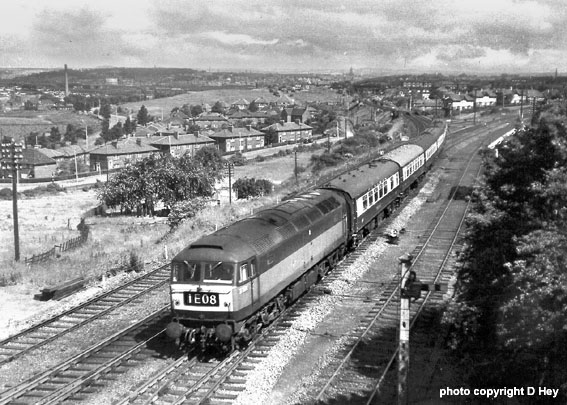
(Inset Left) In 1951, 'Britannia' Class 7MT Pacific No 70000 was the first of the twelve new British Railways Standard types to be introduced to traffic. Designed at Derby and built at Crewe, with sections also  designed at Brighton, Doncaster and Swindon, beautifying was not on the agenda, the basic ethos being simplicity in construction, lower coal consumption, and longer mileage between classified repairs. Of the first 25 Britannias built, Nos 70000-03/05-13 were allocated to Stratford and Norwich sheds on the Eastern Region in 1951, where they received high praise on the GE section of the Eastern Region, though this is hardly surprising since locomen previously had no larger engines than the Class 5MT 'Sandringhams' and Thompson Class B1s, the latter having a fire grate area of only 27.9 sq ft compared the 'Britannias' 42 sq ft.
designed at Brighton, Doncaster and Swindon, beautifying was not on the agenda, the basic ethos being simplicity in construction, lower coal consumption, and longer mileage between classified repairs. Of the first 25 Britannias built, Nos 70000-03/05-13 were allocated to Stratford and Norwich sheds on the Eastern Region in 1951, where they received high praise on the GE section of the Eastern Region, though this is hardly surprising since locomen previously had no larger engines than the Class 5MT 'Sandringhams' and Thompson Class B1s, the latter having a fire grate area of only 27.9 sq ft compared the 'Britannias' 42 sq ft.  (Inset Right) Sporting a Norwich shedplate (32A) on the smokebox door, No 70011 Hotspur heads the 'up' 'Norfolkman' past Norwich Trowse on September 5th 1952. (Below) The 'Britannia'class transformed the Eastern Region's East Anglian service out of Liverpool Street, working two return trips daily between London and Norwich, either via Ipswich or Cambridge. The new timetable of hourly nine-coach trains included the 3.30pm down 'Broadsman' which for some time became the fastest train in the country. Here Britannia class 7MT No 70034 Thomas Hardy arrives at Liverpool Street with the 'East Anglian'.
(Inset Right) Sporting a Norwich shedplate (32A) on the smokebox door, No 70011 Hotspur heads the 'up' 'Norfolkman' past Norwich Trowse on September 5th 1952. (Below) The 'Britannia'class transformed the Eastern Region's East Anglian service out of Liverpool Street, working two return trips daily between London and Norwich, either via Ipswich or Cambridge. The new timetable of hourly nine-coach trains included the 3.30pm down 'Broadsman' which for some time became the fastest train in the country. Here Britannia class 7MT No 70034 Thomas Hardy arrives at Liverpool Street with the 'East Anglian'. 
BR LONDON MIDLAND REGION EXPRESSES
(Above-Insets-Below) The 'Royal Scot' is probably the most famous express to run between London (Euston) and Glasgow. The name was first conferred in July 1927 on a train that had been operating since 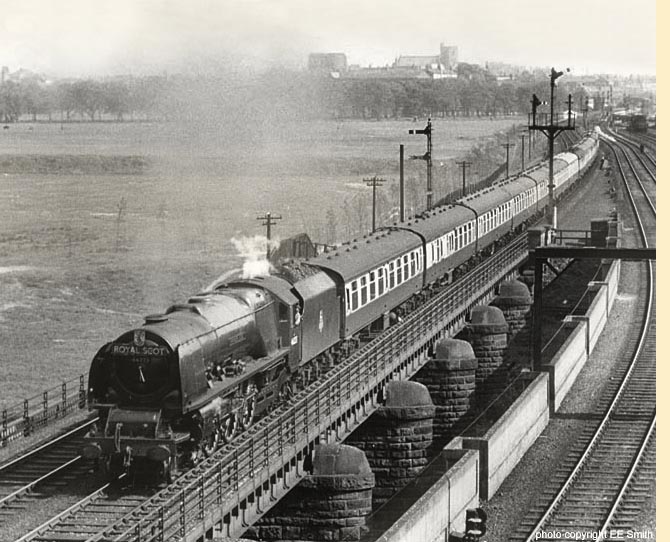 February 1848, albeit more popularly known as the 'Ten o'clock' in 1862 due to its departure time from Euston. The introduction of the 'Royal Scot' title was a tactical marketing strategy by the LMS to rival the LNER's 'Flying Scotsman' express which also departed London at 10.00am. Over the years the Anglo-Scottish express has seen haulage by LNWR Precedent Class 2-4-0s, LNWR Precursor Class 4-4-0s and LNWR Claughton Class 4-6-0s, in each case involving a changeover to a Caledonian Railway loco at Carlisle Citadel. In 1927 the more powerful LMS Royal Scot Class 7P 4-6-0 locos were introduced, but as the train gradually became heavier the Class 8P LMS Princess Royal Pacifics were introduced in 1933, followed by LMS 'Coronation' Class locos in 1937. Sadly the 'Royal Scot' name was dropped in 2003 and there is now no equivalent special
February 1848, albeit more popularly known as the 'Ten o'clock' in 1862 due to its departure time from Euston. The introduction of the 'Royal Scot' title was a tactical marketing strategy by the LMS to rival the LNER's 'Flying Scotsman' express which also departed London at 10.00am. Over the years the Anglo-Scottish express has seen haulage by LNWR Precedent Class 2-4-0s, LNWR Precursor Class 4-4-0s and LNWR Claughton Class 4-6-0s, in each case involving a changeover to a Caledonian Railway loco at Carlisle Citadel. In 1927 the more powerful LMS Royal Scot Class 7P 4-6-0 locos were introduced, but as the train gradually became heavier the Class 8P LMS Princess Royal Pacifics were introduced in 1933, followed by LMS 'Coronation' Class locos in 1937. Sadly the 'Royal Scot' name was dropped in 2003 and there is now no equivalent special 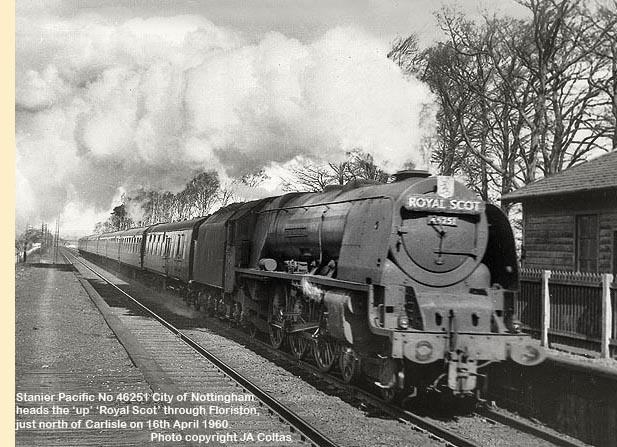 train of that name. Instead, the WCML has an hourly (peak) or two-hourly (off-peak) service of British Rail Class 390 Pendolino units operated by Virgin Trains. How times have changed! (Top) Harking back to steam days, here is Stanier's 'Coronation' class Pacific No 46247 City of Liverpool, introduced to traffic in September 1943 (complete with streamlined casing in wartime black livery) heading the up 'Royal Scot' through Rugby in June 1957. The loco was withdrawn from principal main line duties in May 1963 after some twenty years in service. (Inset) 46223 Princess Alice heads the 'Royal Scot' at Carlisle. (Inset Right) 46251 City of Nottingham heads the southbound train at Floriston in April 1960. (Inset Below) During the Fifties, British Railways made great strides with the introduction of named trains and the fitting of headboards to locomotives. The standard pattern keystone-
train of that name. Instead, the WCML has an hourly (peak) or two-hourly (off-peak) service of British Rail Class 390 Pendolino units operated by Virgin Trains. How times have changed! (Top) Harking back to steam days, here is Stanier's 'Coronation' class Pacific No 46247 City of Liverpool, introduced to traffic in September 1943 (complete with streamlined casing in wartime black livery) heading the up 'Royal Scot' through Rugby in June 1957. The loco was withdrawn from principal main line duties in May 1963 after some twenty years in service. (Inset) 46223 Princess Alice heads the 'Royal Scot' at Carlisle. (Inset Right) 46251 City of Nottingham heads the southbound train at Floriston in April 1960. (Inset Below) During the Fifties, British Railways made great strides with the introduction of named trains and the fitting of headboards to locomotives. The standard pattern keystone-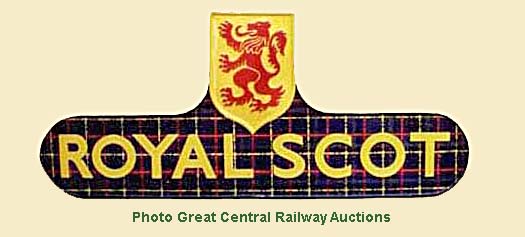 shaped headboards had polished Gill Sans lettering mounted on a black background (later red was adopted by the LMR). By 1956, however, the LMR took full advantage of BR's leniency towards the uniformity of designs and came up with the distinctive 'Royal Scot' and 'Caledonian' headboards. This cast aluminium locomotive headboard 'Royal Scot' measures 69" x 25½", with yellow lettering on a tartan background crowned by a heraldic shield displaying a red lion rampart from the Royal Banner of Scotland; this headboard sold for £6,400 at a GCR Auction on 25th April 2009. (Below) A train spotting hotspot of yesteryear..no prizes for guessing where!
shaped headboards had polished Gill Sans lettering mounted on a black background (later red was adopted by the LMR). By 1956, however, the LMR took full advantage of BR's leniency towards the uniformity of designs and came up with the distinctive 'Royal Scot' and 'Caledonian' headboards. This cast aluminium locomotive headboard 'Royal Scot' measures 69" x 25½", with yellow lettering on a tartan background crowned by a heraldic shield displaying a red lion rampart from the Royal Banner of Scotland; this headboard sold for £6,400 at a GCR Auction on 25th April 2009. (Below) A train spotting hotspot of yesteryear..no prizes for guessing where!
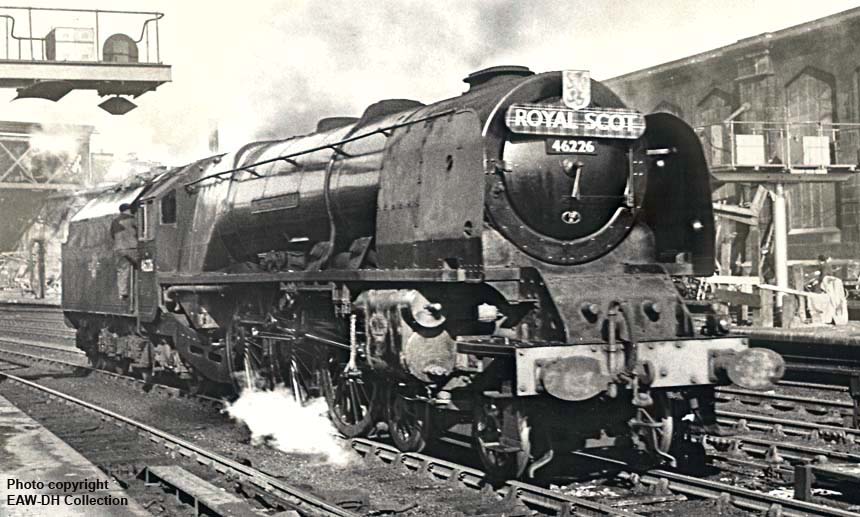
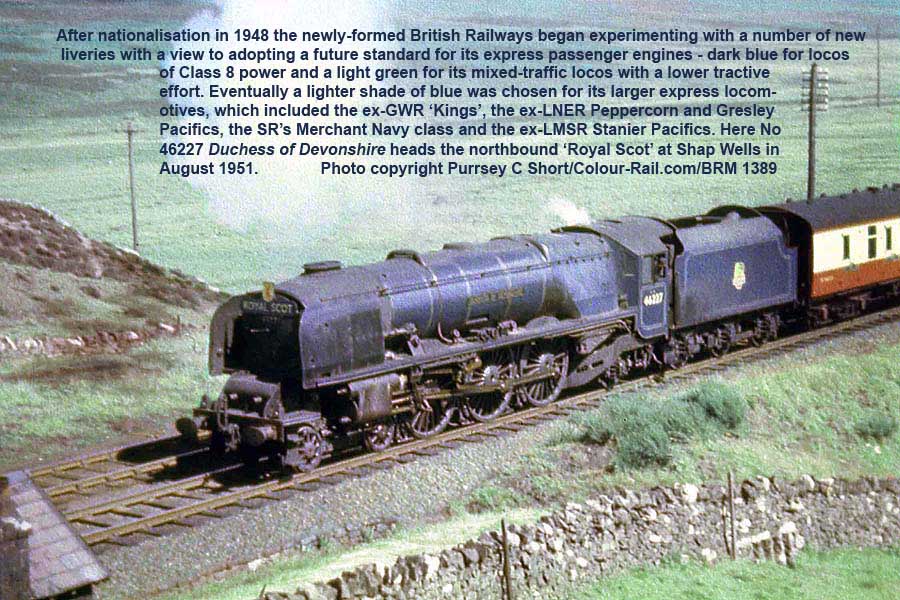

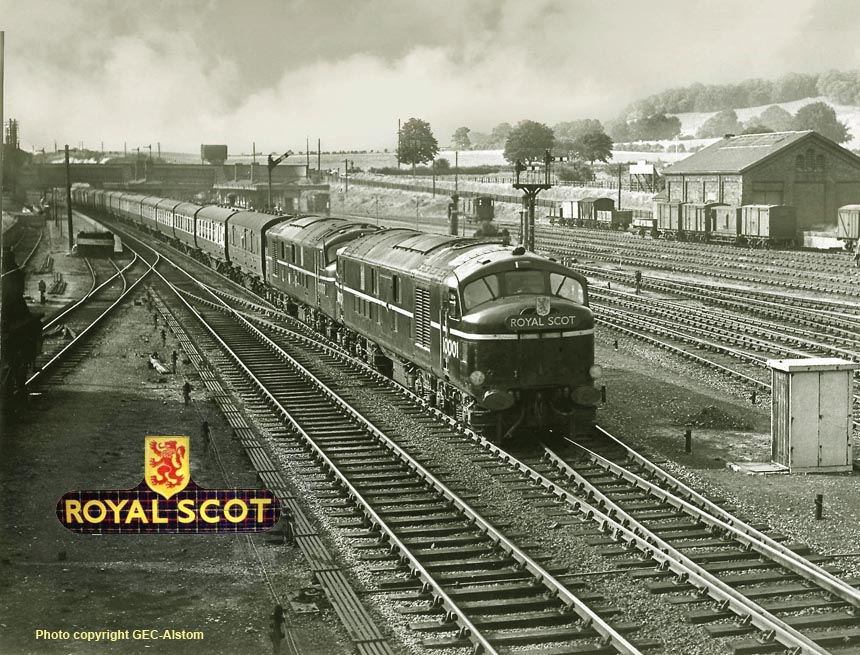
(Above-Inset-Below) LMS/English Electric Co 1,600hp Co-Co twins Nos 10000/1 as we remember them - powering the 'Royal Scot' in early British Railways days. Working in multiple, the Co-Co twins were regularly employed on the heavy Anglo-Scottish expresses during the 1950s. Indeed I first 'copped' Nos 10000/1 during a visit to the railway Mecca at Crewe with my spotting chum, 'Bonzo'; a veritable professor  on all things to do with railways. The pair were heading the up 'Royal Scot' express and, judging by Bonzo's impeccable time-keeping, running a few minutes ahead of their booked time. Leading the ensemble was a rather grubby No 10000 in green livery with the BR insignia on its side, and carrying the distinctive tartan 'Royal Scot' headboard on the nose-end. I was quite giddy at 'copping' them until I heard a loud groan rising up from the pack of spotters, then another - and another - until the footbridge was awakened to a crescendo of cat calls and boos. I'd never heard the likes of it before. I glanced at Bonzo swigging his Tizer, his face showing a variety of emotions. I wasn't sure whether he was caught up by the hostility around us, or suffering from trapped wind? It turned out to be neither...like me, he was pleased as Punch; the Co-Co twins were 'cops' for the both of us and, after watching them glide through the station, we dutifully logged them in our books, away from prying eyes. Not only did the 'Royal Scot' express have a distinctive tartan-coloured headboard, in keeping with most express trains of the day it had carriage destination boards, however the 'Royal Scot' boards had a tartan background plus an end cover for the gangway door of the rear coach, all of which added a certain panache to this Anglo-Scottish service. Sadly, such extravagances as locomotive headboards and carriage destination boards began to disappear during the Sixties, and most of the titled trains were named only in the timetable and the headboards discarded.
on all things to do with railways. The pair were heading the up 'Royal Scot' express and, judging by Bonzo's impeccable time-keeping, running a few minutes ahead of their booked time. Leading the ensemble was a rather grubby No 10000 in green livery with the BR insignia on its side, and carrying the distinctive tartan 'Royal Scot' headboard on the nose-end. I was quite giddy at 'copping' them until I heard a loud groan rising up from the pack of spotters, then another - and another - until the footbridge was awakened to a crescendo of cat calls and boos. I'd never heard the likes of it before. I glanced at Bonzo swigging his Tizer, his face showing a variety of emotions. I wasn't sure whether he was caught up by the hostility around us, or suffering from trapped wind? It turned out to be neither...like me, he was pleased as Punch; the Co-Co twins were 'cops' for the both of us and, after watching them glide through the station, we dutifully logged them in our books, away from prying eyes. Not only did the 'Royal Scot' express have a distinctive tartan-coloured headboard, in keeping with most express trains of the day it had carriage destination boards, however the 'Royal Scot' boards had a tartan background plus an end cover for the gangway door of the rear coach, all of which added a certain panache to this Anglo-Scottish service. Sadly, such extravagances as locomotive headboards and carriage destination boards began to disappear during the Sixties, and most of the titled trains were named only in the timetable and the headboards discarded. 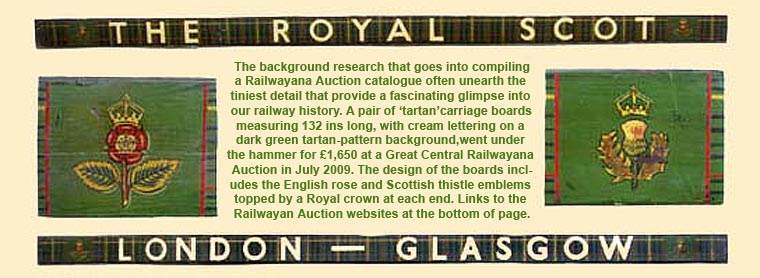
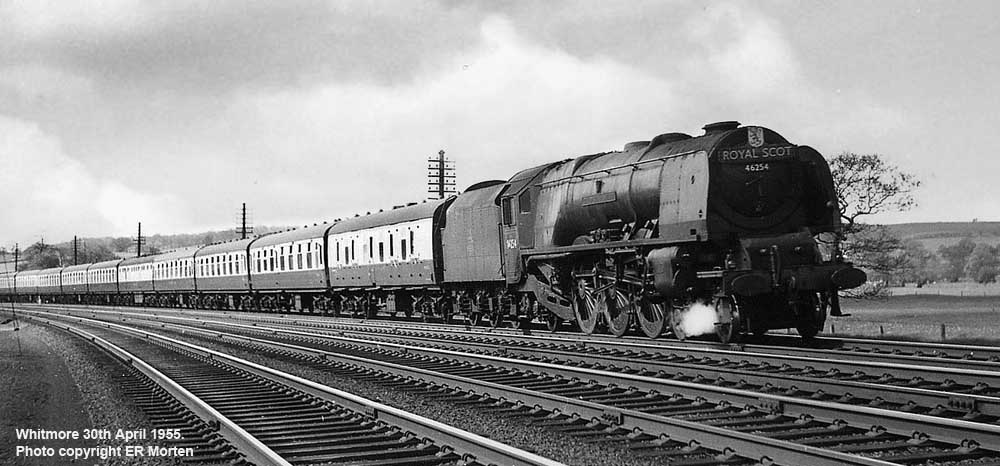
(Above-Below) The splendid sight of Stanier Class 8P No 46254 City of Stoke on Trent heading the 'up' 'Royal Scot' at Whitmore on 30th April 1955. (Inset Right) By 1960 the down Royal Scot had its departure time from Euston changed to 09:05. The northbound train was speeded up by 40 minutes and the southbound train by 15 minutes, for a new journey time in both directions of 7 hours 15 minutes. This was identical with two other WCML titled trains of the era, namely the 'Caledonian' and the 'Mid-day Scot', all three trains being restricted to eight coaches to save weight, and the number of passengers limited to the seating capacity available on the train, standing passengers not being permitted. All three ran non-stop between London and Carlisle, where the locomotive was changed. 
(Above-Inset Right) A pair of BR LMR posters featuring the 'Royal Scot' and 'Mid-Day Scot' timings recently went under the hammer at the world renowned specialist railwayana and transport auctioneers, Great Western Railwayana Auctions (GWRA) Ltd. Now in 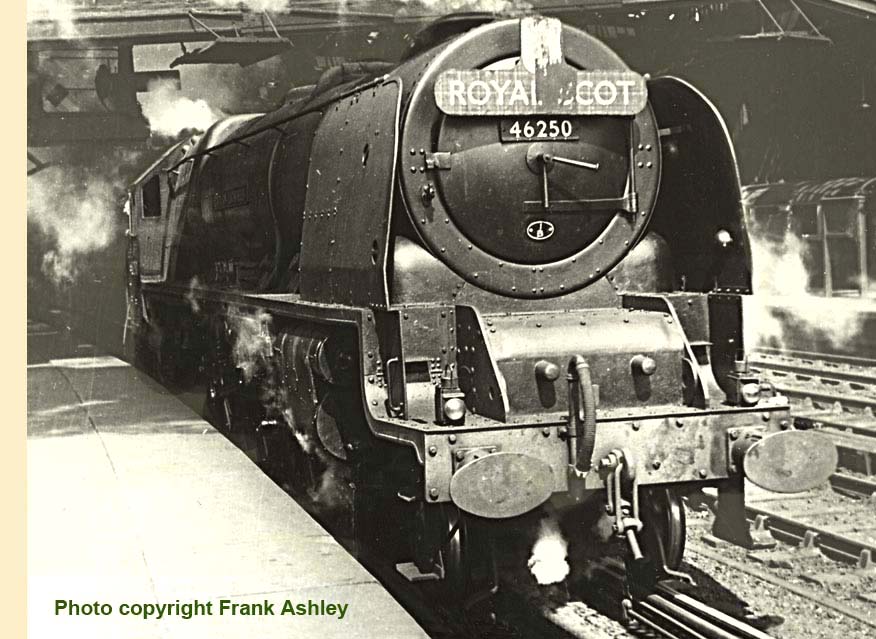 their 21st year GWRA is the longest established railwayana auction house still under the same ownership. Click HERE to visit the GWRA's excellent website. (Inset) Sporting a battered-looking headboard, 46250 City of Lichfield awaits the right away with the southbound train from Carlisle.
their 21st year GWRA is the longest established railwayana auction house still under the same ownership. Click HERE to visit the GWRA's excellent website. (Inset) Sporting a battered-looking headboard, 46250 City of Lichfield awaits the right away with the southbound train from Carlisle.
(Below) Another WCML spotting Mecca was Tamworth, which is featured on the Train Spotting page 4. This shot below was taken on 12th February 1957 and shows the 'down' 'Royal Scot' in the hands of the SR/EE Co diesel electrics No 10201-2 in place of the usual Stanier Class 8P Pacific. The Southern Railway was the most progressive of all the four main railway companies having invested heavily in 3rd rail electrification during the 1930s. The SR's Chief Mechanical Engineer, OV Bulleid, was looking at diesel-electric traction as an alternative to costly third-rail electrification on some west of England routes. The result was the SR/EE Co diesel electric No 10201, built at Ashford works in 1950. The power unit was the same 16-cylinder 16SVT engine as fitted to the LMS Co-Cos, but equipped with the Napier 75100 Turbocharger producing a 1,750hp prototype. The SR/English Electric 1,750hp ICo-Co1, No 10201, emerged from Ashford Works in November 1950, followed by 10202 in August 1951, and the third of the trio, No 10203 (with output raised to 2,000hp) entered traffic until April 1954. The trio was appropriated by the LMR for use on a variety of duties - Anglo-Scottish, Birmingham and Manchester, with frequent spells on locals to Bletchly. The additional horsepower of No 10203 gave it a distinctly superior performance, often working the 'Royal Scot' single-handed. By the end of 1963 all three SR diesel-electrics were withdrawn. 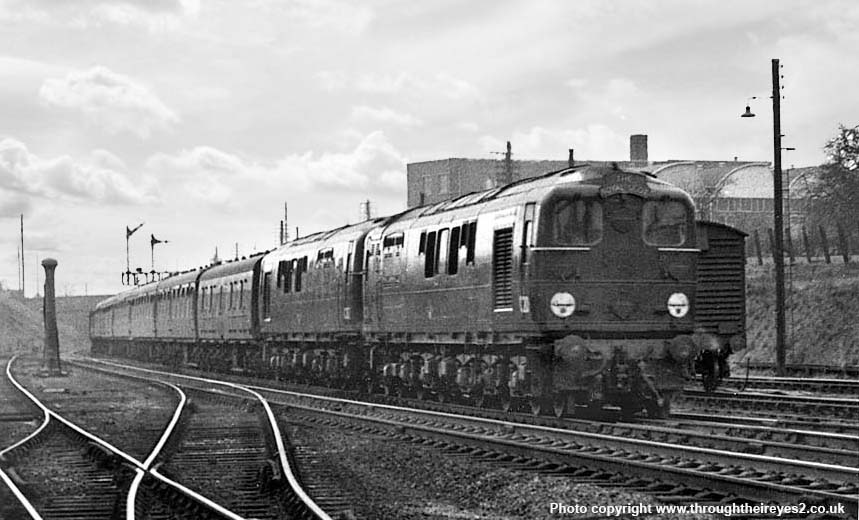
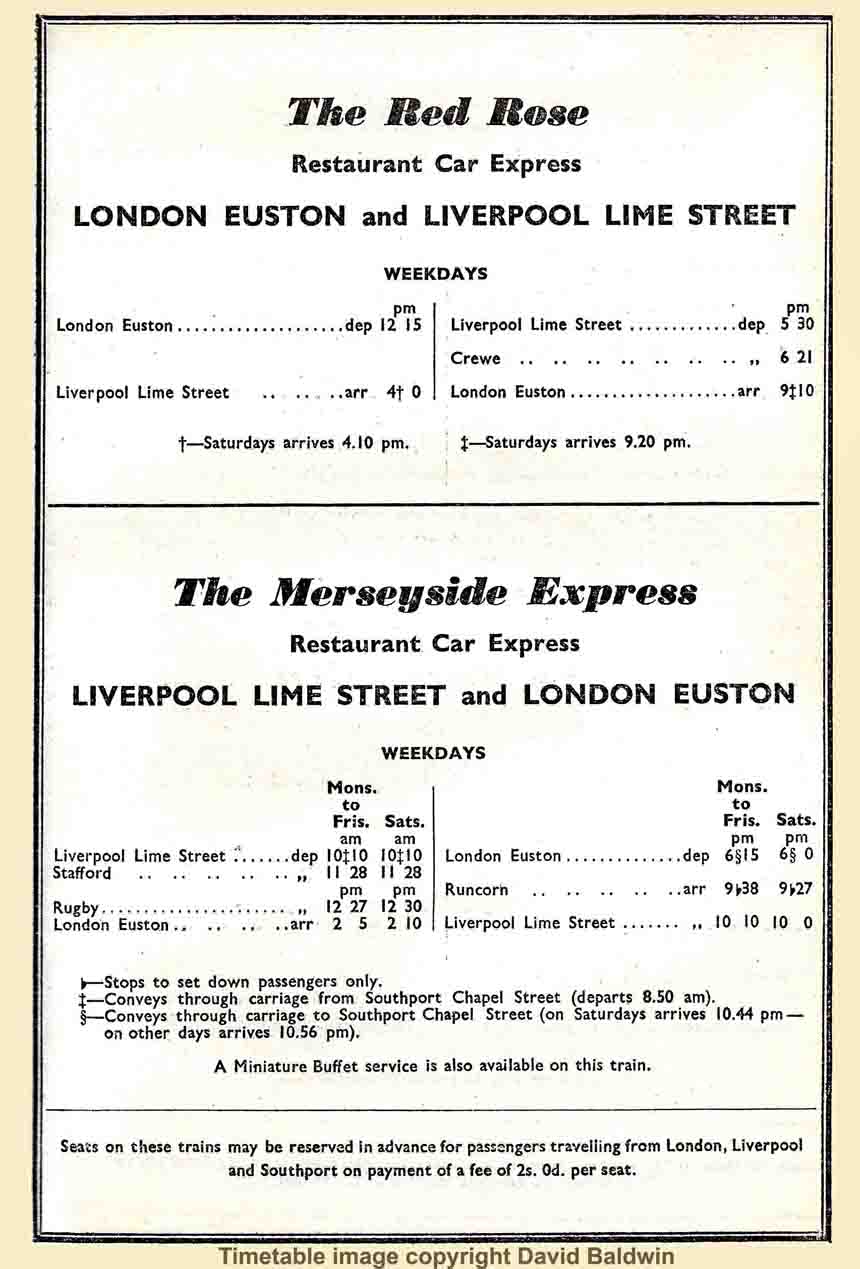

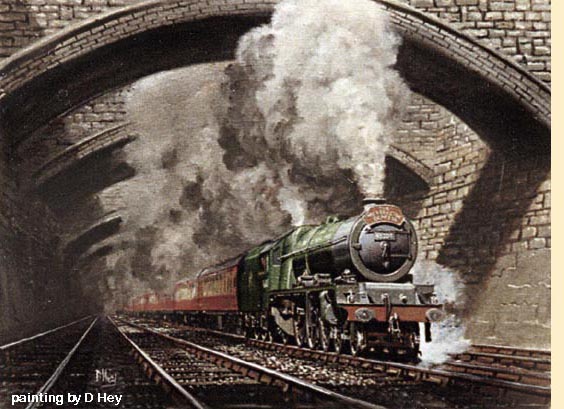 (Above-Below) Returning to the English Electric Co's 3,300hp prototype, it was originally intended to call it Enterprise, but the name was dropped when it was found that Hudswell Clarke of Leeds had a range of locomotives bearing the same name. As a result, the EE Co prototype became known as Deltic, derived from the 'V' shape of the engine resembling that of the inverted Greek letter 'Delta'. Working from Edge Hill shed, the Deltic's first assignment in revenue-earning service involved running-in turns on overnight freights between Liverpool and London. This was followed with regular trips on the 10.10am up 'Merseyside Express' and the 16.15 return 'Shamrock' from Euston. Here the prototype waits to depart from Liverpool Lime Street on its inaugural run on 13th December 1955. (Below) In wintry conditions Deltic works the return 16.15 Euston-Liverpool 'Shamrock' express just north of Stafford.
(Above-Below) Returning to the English Electric Co's 3,300hp prototype, it was originally intended to call it Enterprise, but the name was dropped when it was found that Hudswell Clarke of Leeds had a range of locomotives bearing the same name. As a result, the EE Co prototype became known as Deltic, derived from the 'V' shape of the engine resembling that of the inverted Greek letter 'Delta'. Working from Edge Hill shed, the Deltic's first assignment in revenue-earning service involved running-in turns on overnight freights between Liverpool and London. This was followed with regular trips on the 10.10am up 'Merseyside Express' and the 16.15 return 'Shamrock' from Euston. Here the prototype waits to depart from Liverpool Lime Street on its inaugural run on 13th December 1955. (Below) In wintry conditions Deltic works the return 16.15 Euston-Liverpool 'Shamrock' express just north of Stafford. 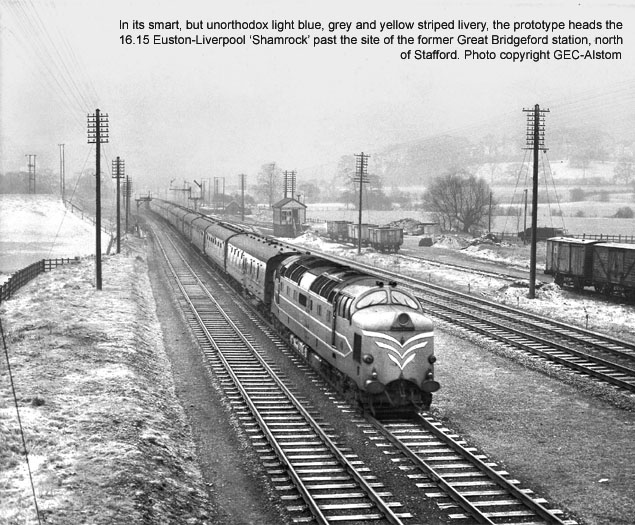
(Insets Right & Below) After the EE Type 4s arrived on the LMR, it was realised that a 2,000hp machine, being closely equivalent to a Class 7P 'Britannia' steam locomotive, did not meet the most onerous 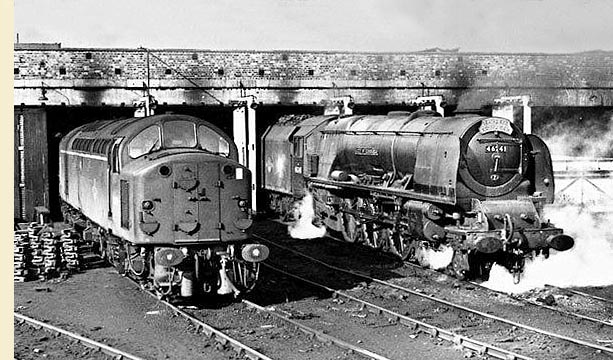 requirements of the heavy, fast trains previously worked by the Stanier Pacifics. However, if one looks at the comparable performances of steam and diesel traction, then diesels were able to show a marked reduction in operating costs which gave them the edge over steam. Although the diesel drawbar pull power on the EE Type was not much better than that which could be exerted from a Class 7P steam loco at full power, such a performance by steam would have demanded an unlimited supply of top grade coal, plus a rate of firing well beyond the sustained effort of a single fireman. Here Type 4 No D305 and 'Coronation' class No 46241 City of Edinburgh stand side by side at Edge Hill shed. No 46241 is sporting an 'Empress Voyager' headboard, the
requirements of the heavy, fast trains previously worked by the Stanier Pacifics. However, if one looks at the comparable performances of steam and diesel traction, then diesels were able to show a marked reduction in operating costs which gave them the edge over steam. Although the diesel drawbar pull power on the EE Type was not much better than that which could be exerted from a Class 7P steam loco at full power, such a performance by steam would have demanded an unlimited supply of top grade coal, plus a rate of firing well beyond the sustained effort of a single fireman. Here Type 4 No D305 and 'Coronation' class No 46241 City of Edinburgh stand side by side at Edge Hill shed. No 46241 is sporting an 'Empress Voyager' headboard, the  short-lived Euston-Liverpool Riverside express that ran from 1953-1956. With Type 4 haulage predominant on the WCML, and electrification proceeding steadily south of Crewe, the London Midland Region could find little suitable work for their still serviceable Pacifics, although they valued their coal pushing tenders in overhead electrified areas as an insurance against train crews attempting to climb into tenders to trim the coal forward. The entire 'Coronation' class had gone by October 1964. Another shot of Type 4 D305 at Edge Hill (8A), this time sporting a 'Shamrock' headboard that day.
short-lived Euston-Liverpool Riverside express that ran from 1953-1956. With Type 4 haulage predominant on the WCML, and electrification proceeding steadily south of Crewe, the London Midland Region could find little suitable work for their still serviceable Pacifics, although they valued their coal pushing tenders in overhead electrified areas as an insurance against train crews attempting to climb into tenders to trim the coal forward. The entire 'Coronation' class had gone by October 1964. Another shot of Type 4 D305 at Edge Hill (8A), this time sporting a 'Shamrock' headboard that day.
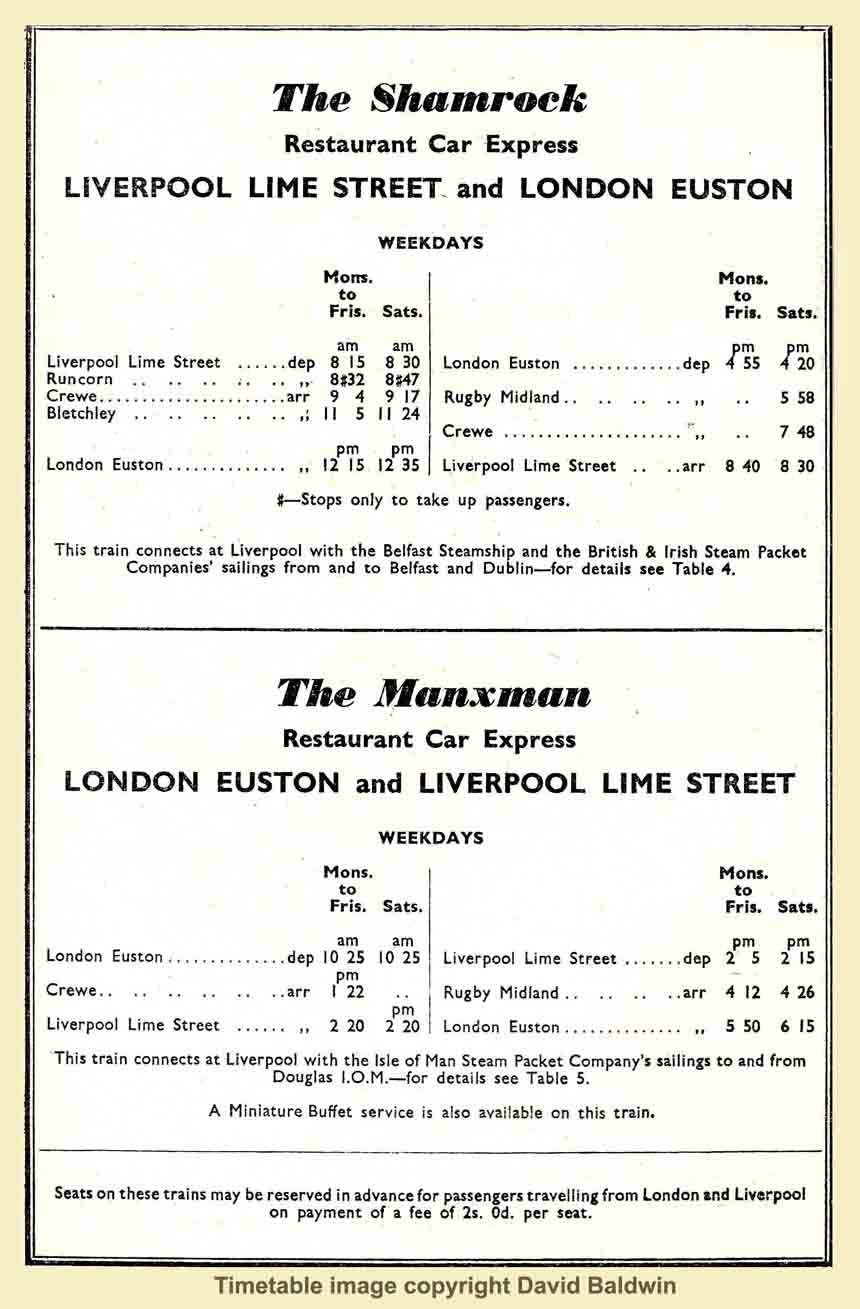
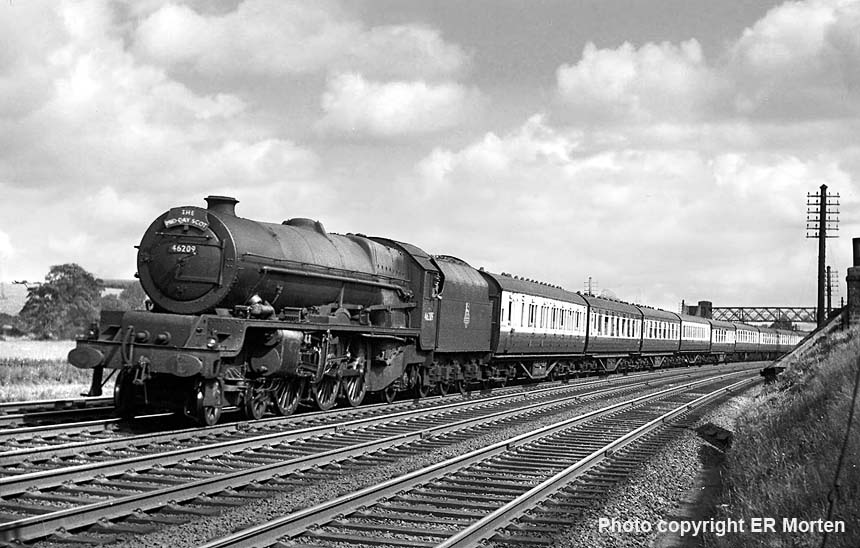
(Above-Inset-Below) Few British express trains have a more varied history than the LMSR's 'Midday Scot'. Inaugurated in 1891, the afternoon service between Euston, Edinburgh and Glasgow became the first  Anglo-Scottish train composed entirely of corridor stock. By 1936, the 'down' train was comprised of never less than 14 bogies of 445 tons which required haulage by one of the Class 8P Stanier Pacifics throughout the 401 miles without change between Euston and Glasgow. It was one of the most exacting schedules in LMSR history. A superb shot by master cameraman ER Morten of Stanier's 'Lizzie' No 46209 Princess Beatrice heading the northbound train at Whitmore on the last leg of its initial 158-mile non-stop run from Euston to Crewe on 23rd July 1957. (Inset Right) The now-preserved Class 8P Pacific No 71000 Duke of Gloucester heads north through Madeley just south of Crewe with the down 'Mid-Day Scot on 18th June 1955. Some twelve years later, 71000 was stripped of both outside cylinders and valve gear in readiness for disposal, and the butchered 71000 was sold for scrap to Woodham Brothers of South Wales where it languished for many years. In 1974 a group of enthusiasts purchased the locomotive, and the Duke of Gloucester Steam Locomotive Trust was formed. No 71000 was subsequently rescued from Barry by the Trust, and following restoration by a dedicated team
Anglo-Scottish train composed entirely of corridor stock. By 1936, the 'down' train was comprised of never less than 14 bogies of 445 tons which required haulage by one of the Class 8P Stanier Pacifics throughout the 401 miles without change between Euston and Glasgow. It was one of the most exacting schedules in LMSR history. A superb shot by master cameraman ER Morten of Stanier's 'Lizzie' No 46209 Princess Beatrice heading the northbound train at Whitmore on the last leg of its initial 158-mile non-stop run from Euston to Crewe on 23rd July 1957. (Inset Right) The now-preserved Class 8P Pacific No 71000 Duke of Gloucester heads north through Madeley just south of Crewe with the down 'Mid-Day Scot on 18th June 1955. Some twelve years later, 71000 was stripped of both outside cylinders and valve gear in readiness for disposal, and the butchered 71000 was sold for scrap to Woodham Brothers of South Wales where it languished for many years. In 1974 a group of enthusiasts purchased the locomotive, and the Duke of Gloucester Steam Locomotive Trust was formed. No 71000 was subsequently rescued from Barry by the Trust, and following restoration by a dedicated team 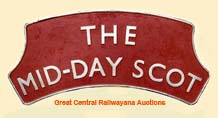 of volunteers and the engine has become one of the great crowd-pullers in the preservation movement.
of volunteers and the engine has become one of the great crowd-pullers in the preservation movement.
(Inset Left) A locomotive headboard as used on the 'Mid-Day Scot' from the Summer of 1951 went under the hammer at a Great central Railwayana Auction. The titled train was introduced in 1927 but withdrawn during the war years and not reinstated until 1949. It last ran in June 1965. The headboard is in original unrestored condition with red paintwork, measuring 33" X 15½", and showing plenty of signs of use over many years.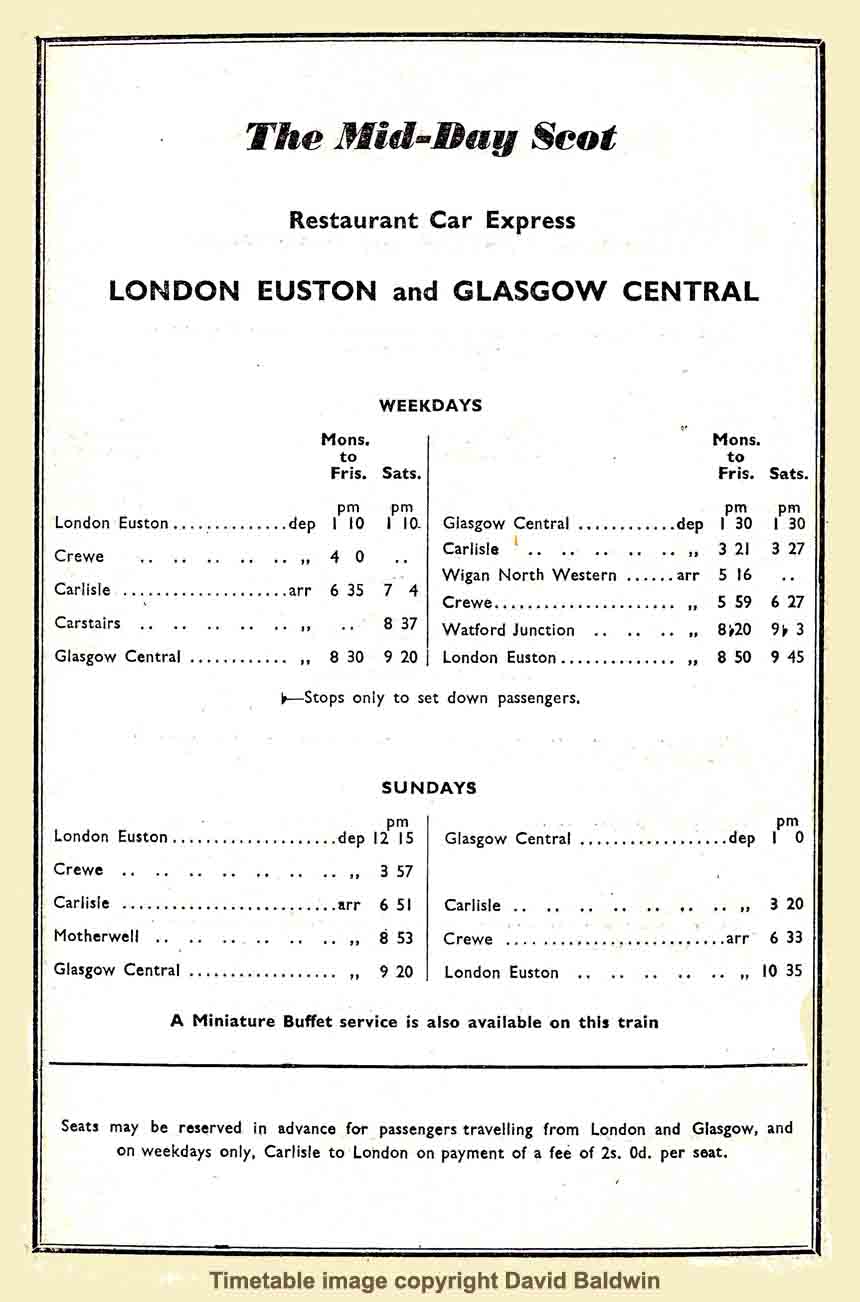
(Below) Footplate Cameraman, JR Carter, took this shot 'Coronation' class No 46239 City of Chester on the turntable at Crewe North shed prior to hauling the 'Mid-day Scot'. No 46239 was one of the five red streamliners to emerge from Crewe works in 1939; its bevelled smokebox door was altered to the conventional shape in February 1957. 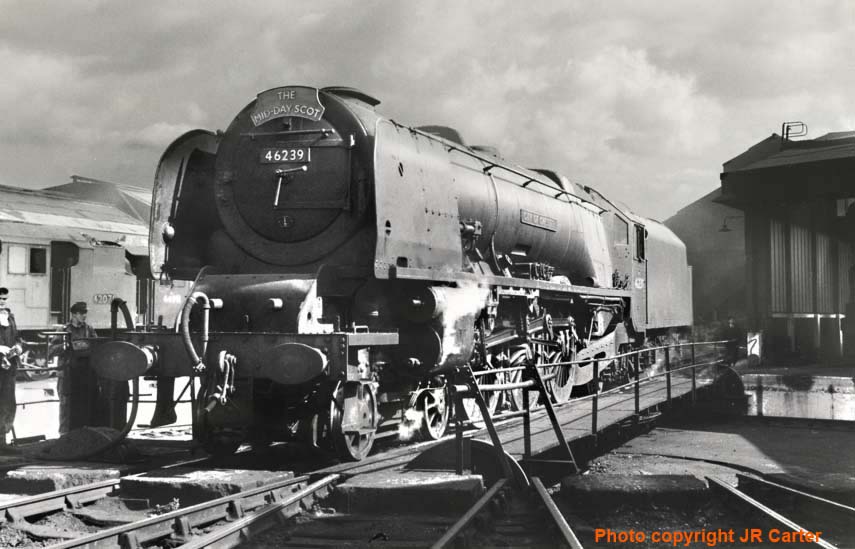
![]()

(Above-Below) The first production EE Co Type 4s destined for the LMR were delivered between May and November 1959. They were allocated initially to Camden, Wiilesden, Crewe and Carlisle Upperby, then to Edge Hill and Longsight as deliveries proceeded.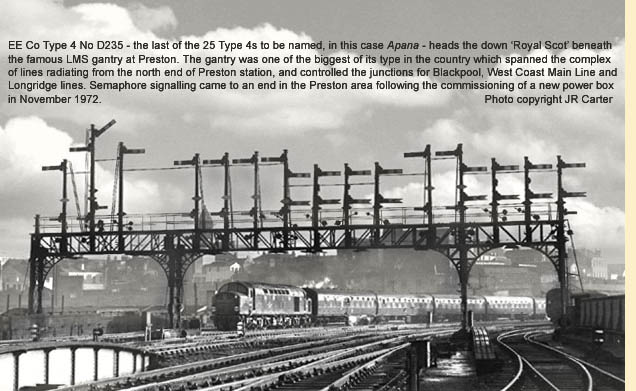 the exception of D226) received names taken from famous ships belonging to the Canadian Pacific, Cunard and Elder Dempster Lines - all three companies being associated with sailings from the port of Liverpool. A named locomotive certainly added some much-needed panache to the early days of dieselisation. No D211 - the second of the LMR's Camden batch, introduced to traffic in June 1959 - was named Mauretania by the Chairman of the Cunard Steamship Company at Liverpool Riverside in September 1960. Bearing the distinctive tartan-coloured 'Royal Scot' headboard, No D211 skims over Hest Bank troughs with the 'down' express on April 3rd 1961. Water troughs were spaced at intervals of approximately thirty five miles on the WCML enabling the tenders of steam locomotives to be replenished at speed. This photo was taken before the introduction of electrical train heating (ETH) and the EE Type 4s were equipped with auxiliary water boilers to provide steam heating for passenger coaching stock. As the locomotives were primarily intended for long distance non-stop runs they were fitted with water scoops to replenish their steam heat boilers at speed from water troughs
the exception of D226) received names taken from famous ships belonging to the Canadian Pacific, Cunard and Elder Dempster Lines - all three companies being associated with sailings from the port of Liverpool. A named locomotive certainly added some much-needed panache to the early days of dieselisation. No D211 - the second of the LMR's Camden batch, introduced to traffic in June 1959 - was named Mauretania by the Chairman of the Cunard Steamship Company at Liverpool Riverside in September 1960. Bearing the distinctive tartan-coloured 'Royal Scot' headboard, No D211 skims over Hest Bank troughs with the 'down' express on April 3rd 1961. Water troughs were spaced at intervals of approximately thirty five miles on the WCML enabling the tenders of steam locomotives to be replenished at speed. This photo was taken before the introduction of electrical train heating (ETH) and the EE Type 4s were equipped with auxiliary water boilers to provide steam heating for passenger coaching stock. As the locomotives were primarily intended for long distance non-stop runs they were fitted with water scoops to replenish their steam heat boilers at speed from water troughs 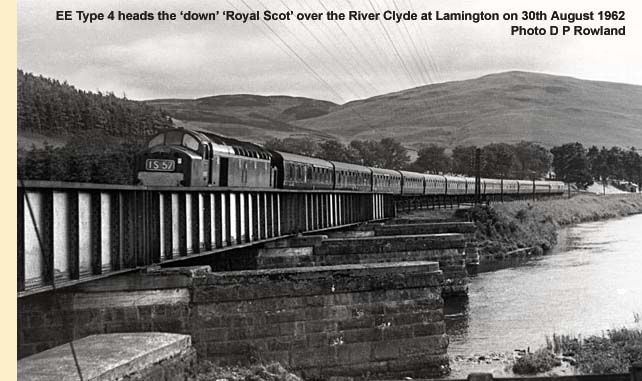 between the rails. The lineside indicator on the left displays a white 'X' (illuminated at night) which enabled the secondman to determine when the scoop should be lowered at the start of the trough section.
between the rails. The lineside indicator on the left displays a white 'X' (illuminated at night) which enabled the secondman to determine when the scoop should be lowered at the start of the trough section.
(Below) EE Type 4 No D233, later to be named Empress of England, was the first Type 4 allocated to Holyhead for crew training in November 1959, and by the Spring of the following year the EE Co machines became a regular sight on the North Wales Coast line, ousting in the process Holyhead's allocation of five 'Britannias' from one of the LMRs longest-serving titled trains - 'The Irish Mail' which operated between London Euston and Holyhead to connect with sailings to Ireland. For over two decades the North Wales Coast main line reverberated to EE Co 16-cylinder engines on the Holyhead-Euston expresses...here No D288 heads the 'down' train out of Chester. 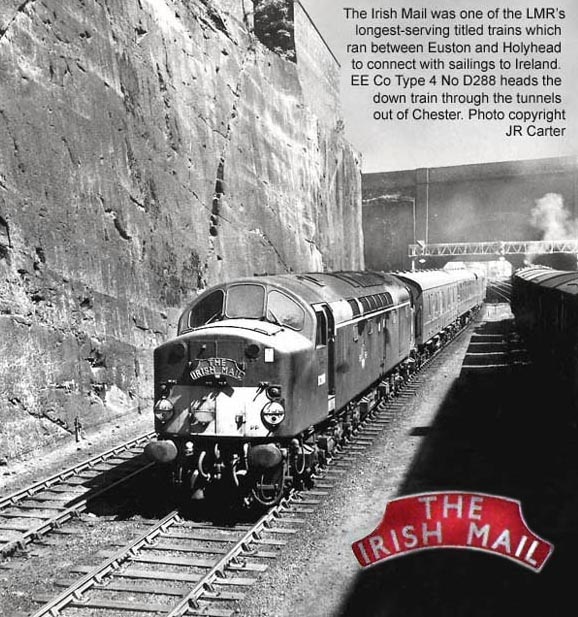

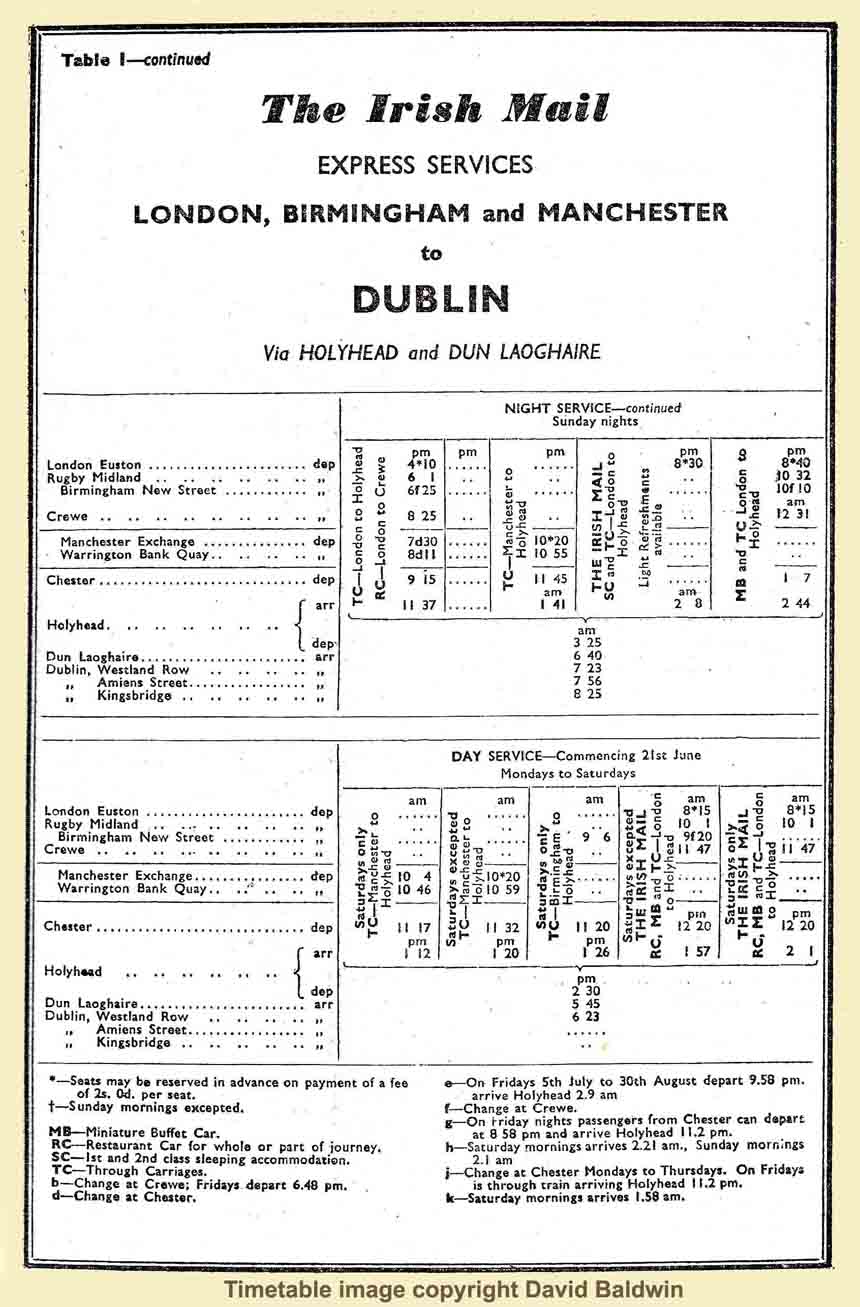

The 'Irish Mail' is the oldest named train in the world; it ran between London Euston and Holyhead to connect with sailings to Dublin. The first Irish Mail train left Euston Station at 8.45pm on 1st August 1848 and was timed to arrive at Holyhead at 6.45 the following morning. Here 'Royal Scot' class No 46134 The 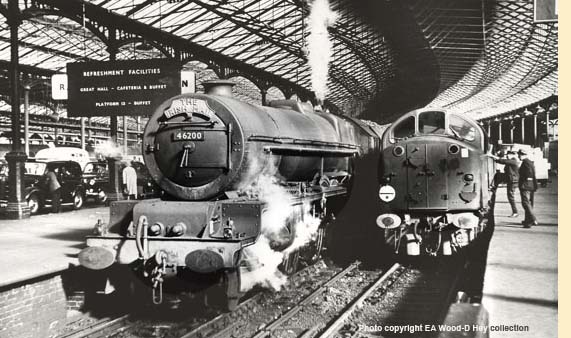 Cheshire Regiment heads the northbound 'Irish Mail' in June 1954. (Inset Left) New and old at Euston: the doyen of the Stanier 'Princess Royal' class, No 46200, sporting an 'Irish Mail' headboard stands side by side with an unidentified EE Type 4, both waiting release from the platform. (Inset Right) Both the LNWR and LMS were keen to publicise the Anglo-Irish service and several posters were published featuring the 'Irish Mail' express at various points along the North Wales Coast Line. This railway poster by Norman Wilkinso shows a panoramic view of Robert Stephenson's famous tubular Britannia Bridge spanning the Menai Straits which linked the Welsh mainland with the Isle of Anglesey. The publicity blurb states - 'The train left Euston on 1st August 1848, was called The Irish Mail, and has been named ever since. It started at 8.45pm that night, and that is its time today. But the Britannia Bridge was not yet built and passengers and mail bags had to take a coach from Bangor by Telford's Suspension Bridge to Anglesey where another train awaited them. By June 1850 the
Cheshire Regiment heads the northbound 'Irish Mail' in June 1954. (Inset Left) New and old at Euston: the doyen of the Stanier 'Princess Royal' class, No 46200, sporting an 'Irish Mail' headboard stands side by side with an unidentified EE Type 4, both waiting release from the platform. (Inset Right) Both the LNWR and LMS were keen to publicise the Anglo-Irish service and several posters were published featuring the 'Irish Mail' express at various points along the North Wales Coast Line. This railway poster by Norman Wilkinso shows a panoramic view of Robert Stephenson's famous tubular Britannia Bridge spanning the Menai Straits which linked the Welsh mainland with the Isle of Anglesey. The publicity blurb states - 'The train left Euston on 1st August 1848, was called The Irish Mail, and has been named ever since. It started at 8.45pm that night, and that is its time today. But the Britannia Bridge was not yet built and passengers and mail bags had to take a coach from Bangor by Telford's Suspension Bridge to Anglesey where another train awaited them. By June 1850 the 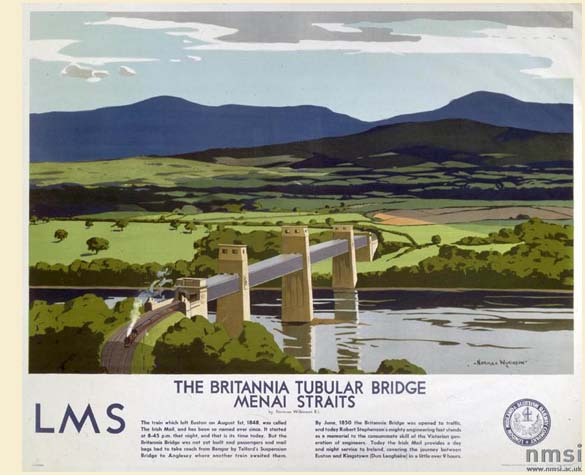 Britannia Bridge was opened to traffic and today Robert Stephenson's mighty engineering feat stands as a memorial to the consummate skill of the Victorian generation of engineers. British artist, Norman Wilkinson RI (1878-1971) studied at Portsmouth and Southsea Schools of Art. He began his career as an illustrator with the Illustrated London News and went on to design posters for the LNWR, LMS and SR. His flamboyant style appeared on many railway posters which can be found on the excellent NMSI Collections Online...a visit is highly recommended. (Inset Below Left) During the final years of steam haulage, the Irish Mail' express was usually worked by one of Holyhead's five 'Britannia' Pacifics until the arrival of the EE Co machines. Back in steam days the ex-LNWR shed at Holyhead was formerly coded 7C from 1935 to May 1952, later recoded 6J by BR up to
Britannia Bridge was opened to traffic and today Robert Stephenson's mighty engineering feat stands as a memorial to the consummate skill of the Victorian generation of engineers. British artist, Norman Wilkinson RI (1878-1971) studied at Portsmouth and Southsea Schools of Art. He began his career as an illustrator with the Illustrated London News and went on to design posters for the LNWR, LMS and SR. His flamboyant style appeared on many railway posters which can be found on the excellent NMSI Collections Online...a visit is highly recommended. (Inset Below Left) During the final years of steam haulage, the Irish Mail' express was usually worked by one of Holyhead's five 'Britannia' Pacifics until the arrival of the EE Co machines. Back in steam days the ex-LNWR shed at Holyhead was formerly coded 7C from 1935 to May 1952, later recoded 6J by BR up to  closure to steam in December 1966. During that time it housed 90 different Black 5s as well as 17 'Royal Scots', a handful of 'Jubilees' and 'Patriots', but perhaps the shed is best known for its allocation of 15 BR7MT 'Britannia' class locos. This included No 70031 Byron which was among the first members of the BR Standard Class Nos 70030-70034 delivered new to the shed between November and December 1952. The locos were attached to BR1 tenders (with inset sides) with a capacity of 7 tons of coal and 4725 gallons of water, but after a short while in service it was found that the tender's inadequate water and coal capacities made them unsuitable for the long distance running of the 'Irish Mail' between Euston and Holyhead; within a month all four were transferred to Longsight (9A).
closure to steam in December 1966. During that time it housed 90 different Black 5s as well as 17 'Royal Scots', a handful of 'Jubilees' and 'Patriots', but perhaps the shed is best known for its allocation of 15 BR7MT 'Britannia' class locos. This included No 70031 Byron which was among the first members of the BR Standard Class Nos 70030-70034 delivered new to the shed between November and December 1952. The locos were attached to BR1 tenders (with inset sides) with a capacity of 7 tons of coal and 4725 gallons of water, but after a short while in service it was found that the tender's inadequate water and coal capacities made them unsuitable for the long distance running of the 'Irish Mail' between Euston and Holyhead; within a month all four were transferred to Longsight (9A).
(Above-Below) 70031 Byron heads the southbound 'Mancunian' at Madeley on 3rd August 1953. Inserted in the photo is a 132 inches-long carriage board which went under the hammer for £290 at a Great Central Railwayana Auction in July 2011. (Below) Class 7MT Britannia No 70049 (later to be named Solway Firth) heads the up 'Irish Mail' at Chester in May 1956. Allocated new to Holyhead on 28 July 1954, 70049 was named week ending 28 May 1960, thus it had the distinction of being the last steam engine named by BR. 70049's final three years were spent in Carlisle at both Upperby and Kingmoor, being withdrawn from Kingmoor in December 1967; the loco was cut up by JMcWilliams at Shettleston in March 1968.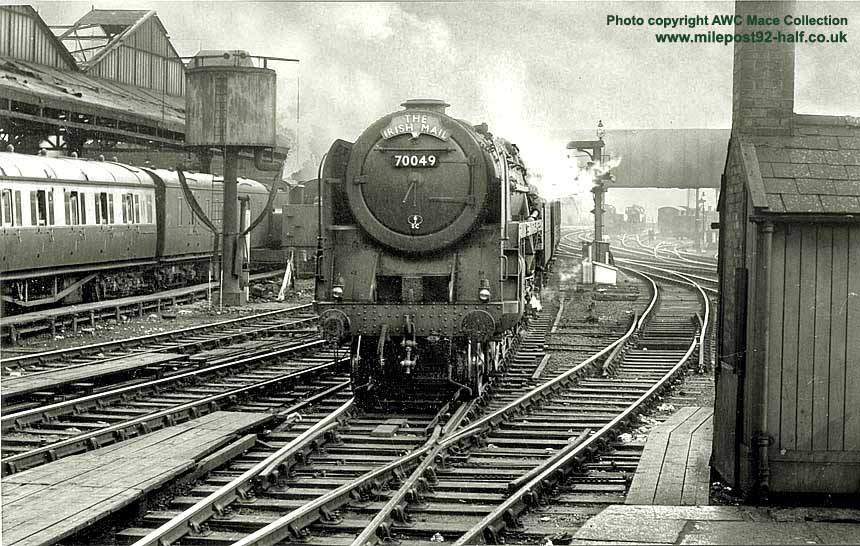
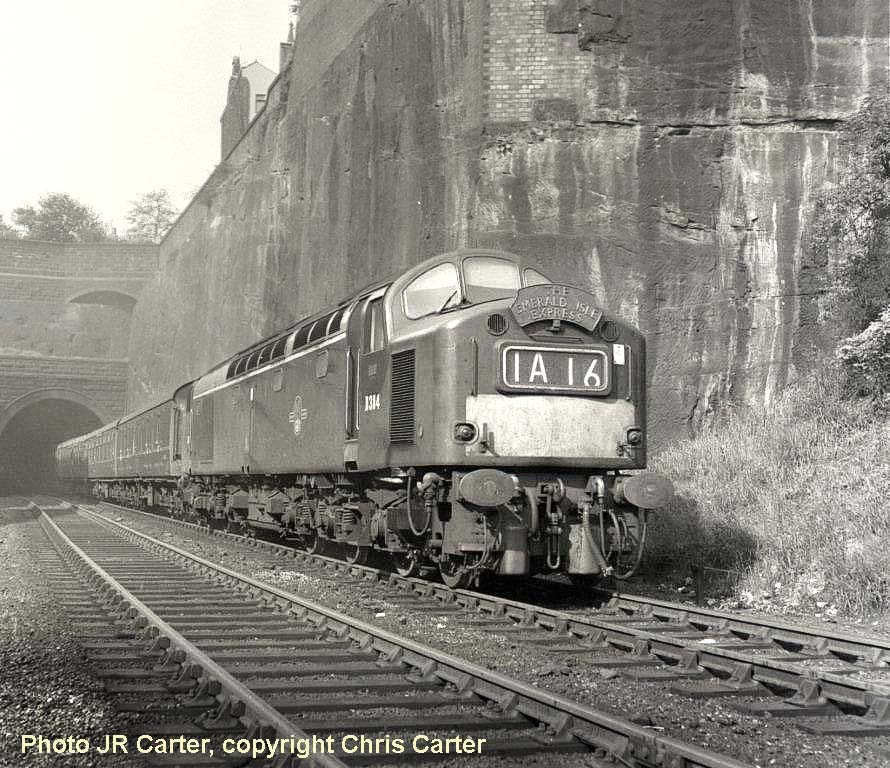
(Above-Below) Both these shots have all the hallmarks of a Jim Carter photograph; it reminds me of the chats I've had with Jim about railway photography in general and his uncanny knack of capturing classic shots - 'Just lucky,' he said modestly. That was typical of Jim! All of us like to imagine we're masters of our own destinies, but in truth there's only so much we can do to coordinate the best photographs; most of the time we're simply blown about by winds of circumstance - the vagaries of the weather being the biggest enemy. However, if you persist often enough then sooner or later you're bound to produce top class results on a regular basis. Jim certainly did...one of his favourite photo locations was the deep sandstone cutting between the tunnels southwest of Chester General, used by all London Midland and Western Region trains bound for North Wales. He spent countless hours there photographing trains, including this shot of EE Co Type No D384 heading the southbound 'Emerald Isle Express' - a Euston to Holyhead and Birkenhead train which connected with sailings to Ireland from 1954 to 1975. (Below) D223 heads the 'up' Welshman' at Chester. This Euston-North Wales service ran from 1927 to 1966, with portions connecting Portmadoc, Pwllheli and Llandudno, and latterly Holyhead.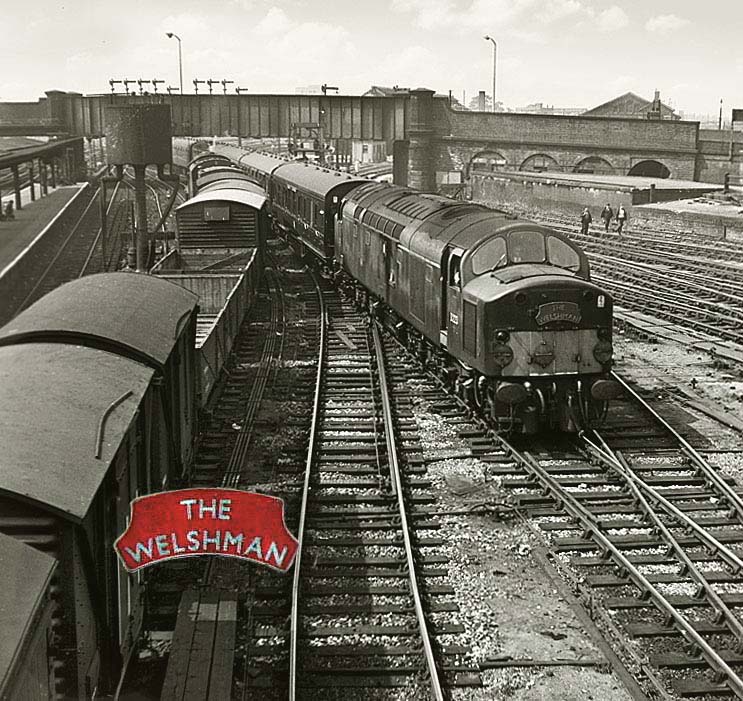
![]()
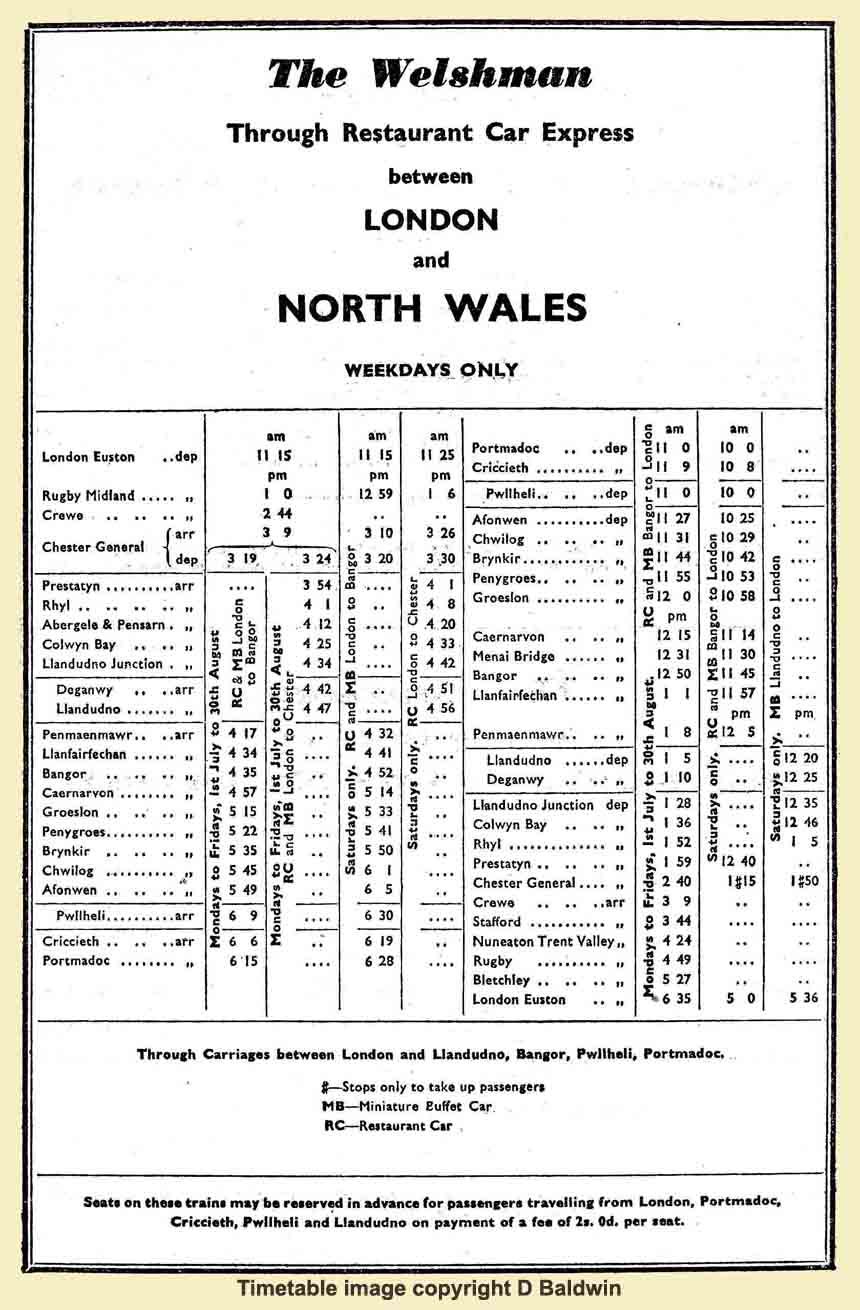
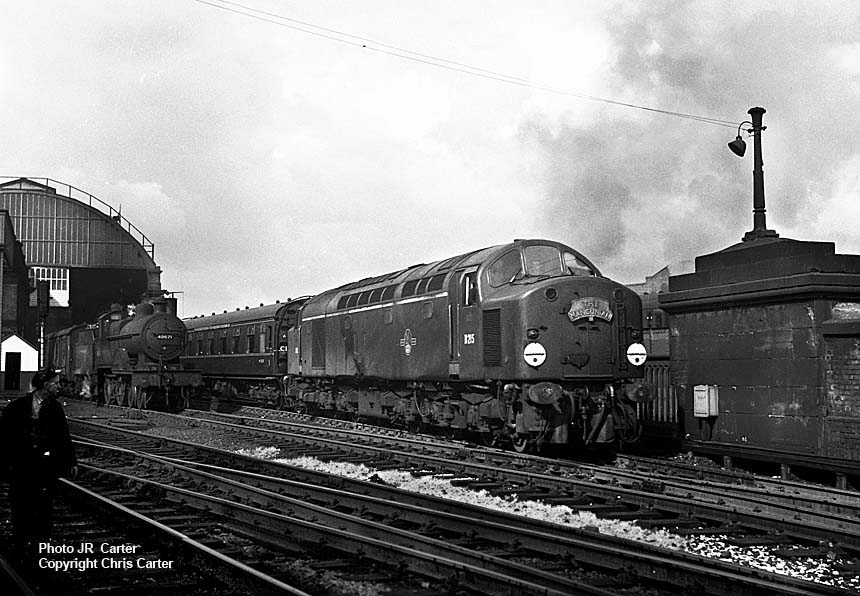
(Above-Below) EE Type D215 (later to be named 'Aquitania' in May 1962) departs Manchester Exchange with the 'up' Manchester-Euston 'Mancunian', diverted from Manchester London Road station (later to be named Piccadilly) due to electrification work. (Below) For many years the Western Division of the LMR had to operate under the baleful influence of modernisation. The nature of engineering work required for WCML electrification between Euston and Crewe included the lifting of road bridges, or lowering of track level to obtain the neccessary clearance for the overhead catenary. The WCML from Euston to Crewe required work on 78% of the 904 bridges concerned, whilst on the 44 mile between Crewe and Manchester, 82% of the bridges had to be rebuilt. Inevitably, the phase of modernisation involved prolonged disruption of train services. Here, another EE Co Type 4, No D231- later to be named Sylvania - heads empty coaching stock of the diverted 'Comet' express through Manchester Exchange for Ordsal Lane carriage sidings. During the Sixties an increasing number of titled train began missing their headboards yet the coaching stock still had side boards mounted at cantrail height to identify the train, but within a few years even these were soon to disappear from Britain's railways and most of the named trains were named only in the timetable.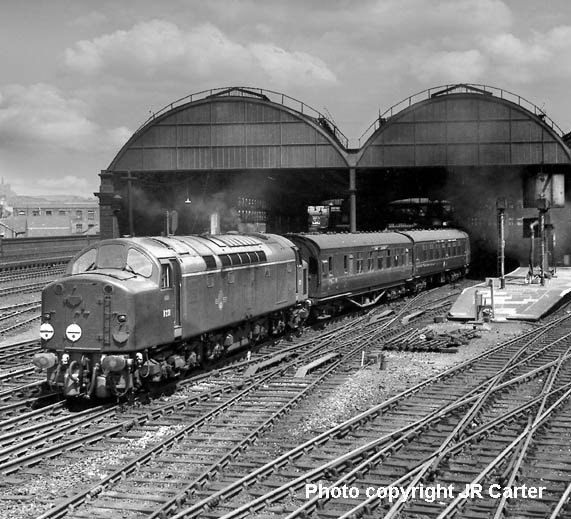
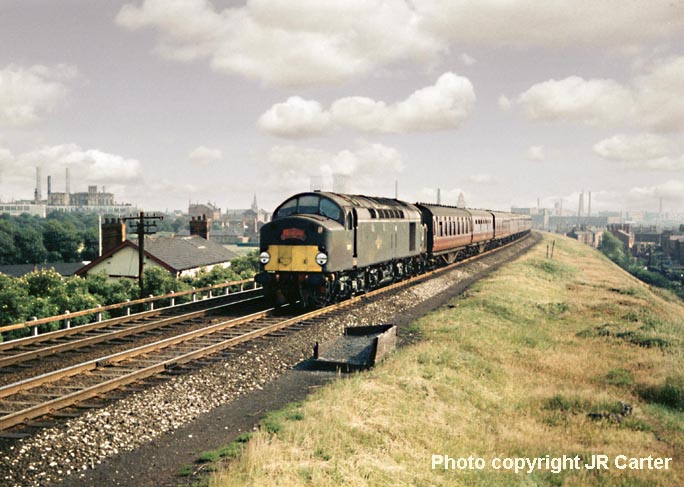
(Above-Below) Another of Jim Carter's favourite locations was the stretch of WCML just north of Wigan North Western station which involved a stiff climb for northbound trains. In between photographing Duchesses at this same spot (seen elsewhere on this site) Jim took this shot of an unidentified EE Type 4 in its pleasing BR standard green livery, with a light grey shoulder band along the bodyside below the roof-mounted filter louvers, heading the 'down' 'Mid-day Scot' (Below) Following the initial batch of EE Co's Type 4s Nos D210-D236, Nos D267-9/87-344 followed in 1960/61 - Nos D305-24 coming from the Robert Stephenson and Hawthorn works in Darlington. Finally, D369-84 arrived in 1961/62. The Type 4 fleet was soon employed on Anglo-Scottish trains, including the 'Royal Scot' often loaded to 14 bogies 510 tons gross. The split-type route indicator boxes of No D326 displays 1M22 southbound 'Royal Scot' as it heads south at Hest Bank on April 3rd 1961. CORRECTION - Martin Ramsdale informs me that the identity of this split box Class 40 is in fact D325 (not D326). Only D325 had the overhead live wire flashes displayed beneath the route indicator boxe, as seen here. Thanks Martin.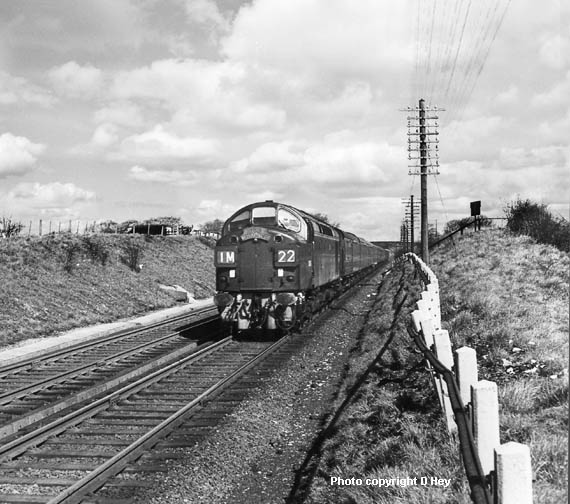

(Above-Inset-Below) In 1960 the down 'Royal Scot' had its departure time from Euston changed to 09:05. The northbound train was speeded up by 40 minutes and the southbound train by 15 minutes, for a new journey time in both directions of 7 hours 15 minutes. This was identical with two other WCML titled trains of the era, namely the 'Caledonian' and the 'Mid-day Scot', all three trains being restricted to fewer coaches 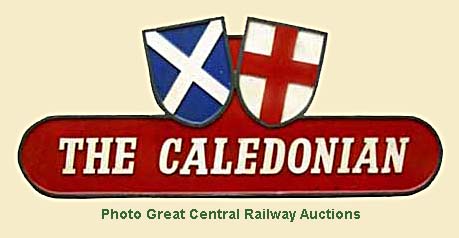 to save weight, and the number of passengers limited to the seating capacity available on the train. (Above) EE Type D305 heads through Eccles station with the diverted up 'Caledonian' due to closure of the WCML following a collison at Warrington in August 1962...modellers should note the white roofs of the coaching stock. (Inset Right) The Anglo-Scottish 'Caledonian' appeared in the timetable on 17th June 1957, as successor to the 'Coronation Scot', which was withdrawn at the outbreak of WW2 and not restored. This extravagant 'Caledonian' locomotive headboard was used on this Anglo-Scottish express train until September 1964. This ex-loco condition headboard measures 59" long crowned by a pair of heraldic shields displaying the white sulture representing St Andrew, the patron saint of Scotland and and the cross of St George, the patron saint of England. This lot sold for £4,000 at Great Central Railwayana Auctions on 18th July 2009. Although headboards were designed for steam locomotives, they sat just as well on the nose of the EE Co Type 4 diesels. (Below) An unidentified Type 4 heads the southbound Caledonian at Warrington.
to save weight, and the number of passengers limited to the seating capacity available on the train. (Above) EE Type D305 heads through Eccles station with the diverted up 'Caledonian' due to closure of the WCML following a collison at Warrington in August 1962...modellers should note the white roofs of the coaching stock. (Inset Right) The Anglo-Scottish 'Caledonian' appeared in the timetable on 17th June 1957, as successor to the 'Coronation Scot', which was withdrawn at the outbreak of WW2 and not restored. This extravagant 'Caledonian' locomotive headboard was used on this Anglo-Scottish express train until September 1964. This ex-loco condition headboard measures 59" long crowned by a pair of heraldic shields displaying the white sulture representing St Andrew, the patron saint of Scotland and and the cross of St George, the patron saint of England. This lot sold for £4,000 at Great Central Railwayana Auctions on 18th July 2009. Although headboards were designed for steam locomotives, they sat just as well on the nose of the EE Co Type 4 diesels. (Below) An unidentified Type 4 heads the southbound Caledonian at Warrington. 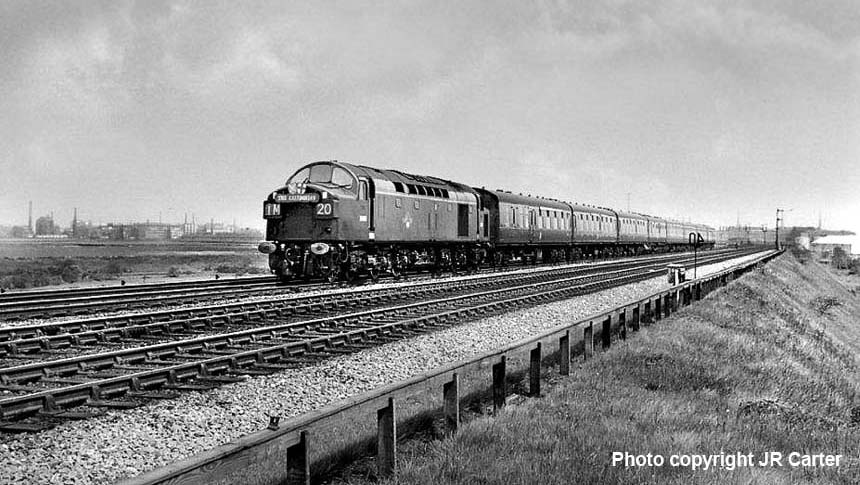
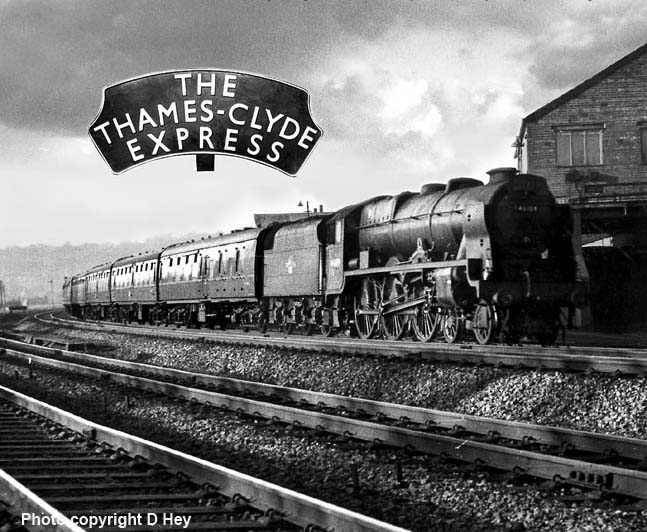
(Above-Inset-Below) The St Pancras-Glasgow (St Enoch) 'Thames-Clyde Express' was inaugurated in 1927, but lost its title at the end of the 74/75 timetable. A second Anglo-Scottish train, the 09.15 St Pancras-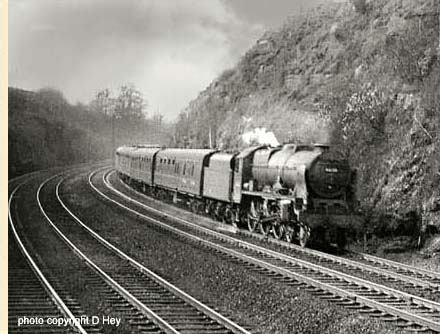 Edinburgh 'Waverley' entered the London Midland Region's timetable on June 17th 1957, but this was temporarily cut back to a Leeds-London service in both directions. The titled train was later reinstated in 1965 until closure of the Waverley route four years later and all through workings between London and Glasgow via the Midland main line ceased in 1977. (Above) Although both trains saw a variety of power in steam days, from what I can recall of my early spotting days (mid-Fifties) the 'Thames-Clyde Express' north of Leeds could be relied upon to produce a Rebuilt 'Royal Scot'. (Above) No 46109 heads the southbound 'Thames-Clyde Express'
Edinburgh 'Waverley' entered the London Midland Region's timetable on June 17th 1957, but this was temporarily cut back to a Leeds-London service in both directions. The titled train was later reinstated in 1965 until closure of the Waverley route four years later and all through workings between London and Glasgow via the Midland main line ceased in 1977. (Above) Although both trains saw a variety of power in steam days, from what I can recall of my early spotting days (mid-Fifties) the 'Thames-Clyde Express' north of Leeds could be relied upon to produce a Rebuilt 'Royal Scot'. (Above) No 46109 heads the southbound 'Thames-Clyde Express' 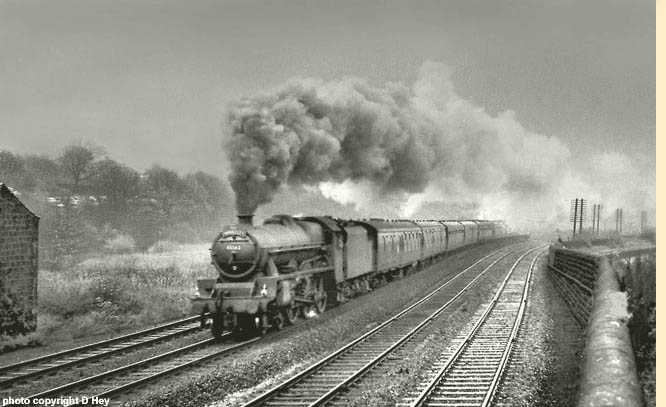 past Kirkstall Forge on the last leg of its run into Leeds in August 1960 (Inset Above) Holbeck's 'Royal Scot class 46117 Welsh Guardsman heads the 'up' train through Newlay Cutting. (Inset Left) 'Jubilee' class No 45562 Alberta heads the northbound 'Waverley' express alongside the Leeds & Liverpool Canal near Kirkstall Forge in April 1960. This lineside location remains one of the few places on the Aire Valley line that is reachable by way of a pleasent walk along the canal towpath between Kirkstall and Newlay; it became a favourite spot for photographing trains in the Sixties. The Aire Valley route between Leeds and Shipley was dequadrified in 1967, retaining loops at Kirkstall for goods traffic. The service linking Leeds, Bradford, Ilkley and Skipton has since been updated
past Kirkstall Forge on the last leg of its run into Leeds in August 1960 (Inset Above) Holbeck's 'Royal Scot class 46117 Welsh Guardsman heads the 'up' train through Newlay Cutting. (Inset Left) 'Jubilee' class No 45562 Alberta heads the northbound 'Waverley' express alongside the Leeds & Liverpool Canal near Kirkstall Forge in April 1960. This lineside location remains one of the few places on the Aire Valley line that is reachable by way of a pleasent walk along the canal towpath between Kirkstall and Newlay; it became a favourite spot for photographing trains in the Sixties. The Aire Valley route between Leeds and Shipley was dequadrified in 1967, retaining loops at Kirkstall for goods traffic. The service linking Leeds, Bradford, Ilkley and Skipton has since been updated 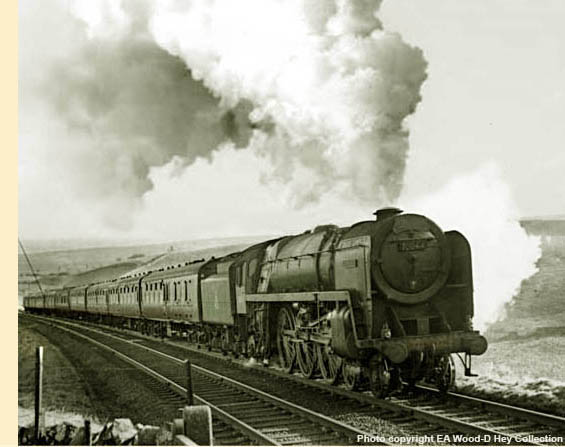 with 25kV overhead line equipment. (Inset Right) Sporting a 55A (Holbeck) shed plate, No 70044 Earl Haigh heads the northbound 'Waverley' near Garsdale of the Settle-Carlisle line (Below) Had it not been for the announcement of the Modernisation Plan in 1955, the emphasis of which was to replace steam with diesel and electric traction, the 'Britannias' may well have had as long and distinguished careers as some of the 'Big Four' engines they had succeeded. Alas it was not to be. Displaced by diesels on the Western and Eastern Regions, the entire class was concentrated on the London Midland Region. The final batch of ten Britannias Nos 70045-54 were coupled to a larger 9 ton capacity BR1D tender which gave a smoother airflow around the footplate than with the conventional tenders with inset sides. The last of the class, No 70054 Dornoch Firth, is being prepared for 'Thames-Clyde' duty at Leeds Holbeck shed.
with 25kV overhead line equipment. (Inset Right) Sporting a 55A (Holbeck) shed plate, No 70044 Earl Haigh heads the northbound 'Waverley' near Garsdale of the Settle-Carlisle line (Below) Had it not been for the announcement of the Modernisation Plan in 1955, the emphasis of which was to replace steam with diesel and electric traction, the 'Britannias' may well have had as long and distinguished careers as some of the 'Big Four' engines they had succeeded. Alas it was not to be. Displaced by diesels on the Western and Eastern Regions, the entire class was concentrated on the London Midland Region. The final batch of ten Britannias Nos 70045-54 were coupled to a larger 9 ton capacity BR1D tender which gave a smoother airflow around the footplate than with the conventional tenders with inset sides. The last of the class, No 70054 Dornoch Firth, is being prepared for 'Thames-Clyde' duty at Leeds Holbeck shed.


(Above-Below) In 1960, an altogether unusual inter-Regional motive power transfer occurred when the NE Region sent eight Gresley A3s from Tyneside to Holbeck shed for use on the Anglo-Scottish expresses. The cascading effect of dieselisation on the ECML was a welcome move for Holbeck crewmen, as most A3s were fitted with the double Kylchap blastpipe which produced a freer steaming engine and gave fireman an easier time over the steeply-graded Settle to Carlisle line. The arrival of the NER's Class A3s led to Holbeck's allocation of five Scots Nos 46109/13/17/30/45 being transferred to Low Moor. Meanwhile, the 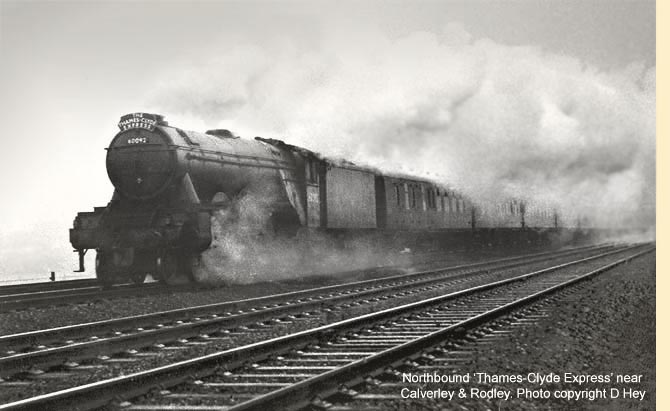 turntables at Holbeck shed were found unsuitable for turning the Gresley A3 Pacifics (length 70ft 5ins) and the locos had to be turned on the triangular junction to the west of the Leeds station. (Above) This excellent shot from Keith Long's 'Cabsaab900' Flickr Photostream, shows Class A3 No 60082 Neil Gow waiting to run from Holbeck shed (55A) to Leeds City station to work the northbound 'Thames-Clyde' on 20th August 1960. (Inset) The 'Thames-Clyde Express' was introduced by the LMS in September 1927 running between St Pancras and Glasgow St Enoch via the Midland main line, Settle & Carlisle line and the ex-G&SWR main line. It was suspended during WWII, but reinstated by BR in 1949 taking some 8 hours 50 minutes to complete the journey. The headboard was used from 1951 on this Anglo-Scottish service, but the train lost its title in May 1975 when the West Coast Main Line north of Crewe was electrified. (Inset Right) Class A3 60086 Gainsborough heads the northbound train out of Leeds in May 1961. The former MR Leeds Wellington station was essentially two halves, north and south, each with its own arrival and departure platforms used by trains to and from the south via Sheffield and derby to St Pancras, and the north via Shipley with connections to Bradford Forster Square, Ilkley and
turntables at Holbeck shed were found unsuitable for turning the Gresley A3 Pacifics (length 70ft 5ins) and the locos had to be turned on the triangular junction to the west of the Leeds station. (Above) This excellent shot from Keith Long's 'Cabsaab900' Flickr Photostream, shows Class A3 No 60082 Neil Gow waiting to run from Holbeck shed (55A) to Leeds City station to work the northbound 'Thames-Clyde' on 20th August 1960. (Inset) The 'Thames-Clyde Express' was introduced by the LMS in September 1927 running between St Pancras and Glasgow St Enoch via the Midland main line, Settle & Carlisle line and the ex-G&SWR main line. It was suspended during WWII, but reinstated by BR in 1949 taking some 8 hours 50 minutes to complete the journey. The headboard was used from 1951 on this Anglo-Scottish service, but the train lost its title in May 1975 when the West Coast Main Line north of Crewe was electrified. (Inset Right) Class A3 60086 Gainsborough heads the northbound train out of Leeds in May 1961. The former MR Leeds Wellington station was essentially two halves, north and south, each with its own arrival and departure platforms used by trains to and from the south via Sheffield and derby to St Pancras, and the north via Shipley with connections to Bradford Forster Square, Ilkley and 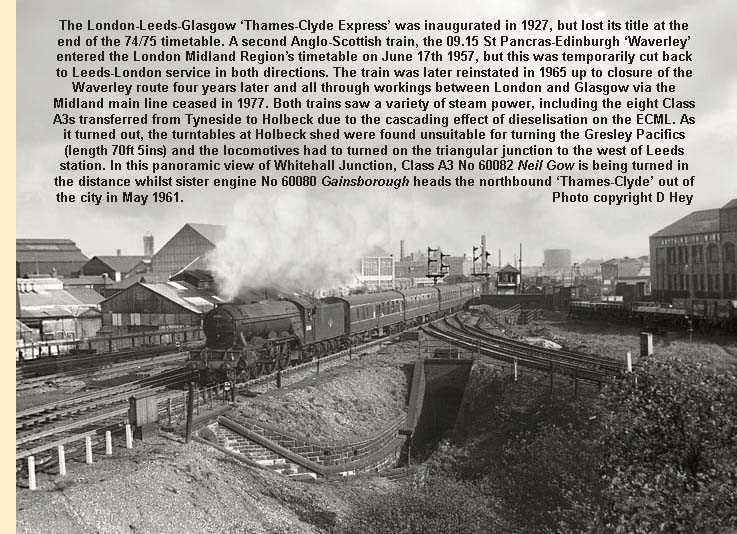 beyond to Skipton and the S&C to Scotland. Being a terminus station, the Anglo-Scottish expresses between St Pancras and Glasgow had to reverse at the Leeds, including the 'Thames-Clyde Express'. Perhaps older enthusiasts will recall a summer timetable in the Fifties when both 'up' and 'down' trains were booked to arrive at Leeds at the same time - approximately 14.30. However, because of the length of both trains, the island platform 5-6 had to be used, therefore passengers entering the station found themselves facing two identical expresses standing side-by-side, each carrying non-reversible 'London-Leeds-Glasgow' roof boards on the carriages, and as both the 'up' and 'down' trains arrived and departed in the same direction, the station staff had to make sure that passengers didn't end up travelling the opposite direction they intended! It later transpired that Skipton became the passing point. The site was later to be developed as a Parcels Depot and then a car park. (Below) Class A3 60092 Fairway approaches Shipley with the northbound 'Thames-Clyde Express' on March 9th 1961. By this time it was clear that the writing was on the wall for steam; on the very same day I photographed one of the new 'Peak' class Type 4 diesels No D12 being utilized for crew training purposes between Leeds and Appleby. At the start of the summer timetable the Anglo-Scottish 'Waverley' and 'Thames-Clyde' expresses became diesel-hauled throughout.
beyond to Skipton and the S&C to Scotland. Being a terminus station, the Anglo-Scottish expresses between St Pancras and Glasgow had to reverse at the Leeds, including the 'Thames-Clyde Express'. Perhaps older enthusiasts will recall a summer timetable in the Fifties when both 'up' and 'down' trains were booked to arrive at Leeds at the same time - approximately 14.30. However, because of the length of both trains, the island platform 5-6 had to be used, therefore passengers entering the station found themselves facing two identical expresses standing side-by-side, each carrying non-reversible 'London-Leeds-Glasgow' roof boards on the carriages, and as both the 'up' and 'down' trains arrived and departed in the same direction, the station staff had to make sure that passengers didn't end up travelling the opposite direction they intended! It later transpired that Skipton became the passing point. The site was later to be developed as a Parcels Depot and then a car park. (Below) Class A3 60092 Fairway approaches Shipley with the northbound 'Thames-Clyde Express' on March 9th 1961. By this time it was clear that the writing was on the wall for steam; on the very same day I photographed one of the new 'Peak' class Type 4 diesels No D12 being utilized for crew training purposes between Leeds and Appleby. At the start of the summer timetable the Anglo-Scottish 'Waverley' and 'Thames-Clyde' expresses became diesel-hauled throughout.
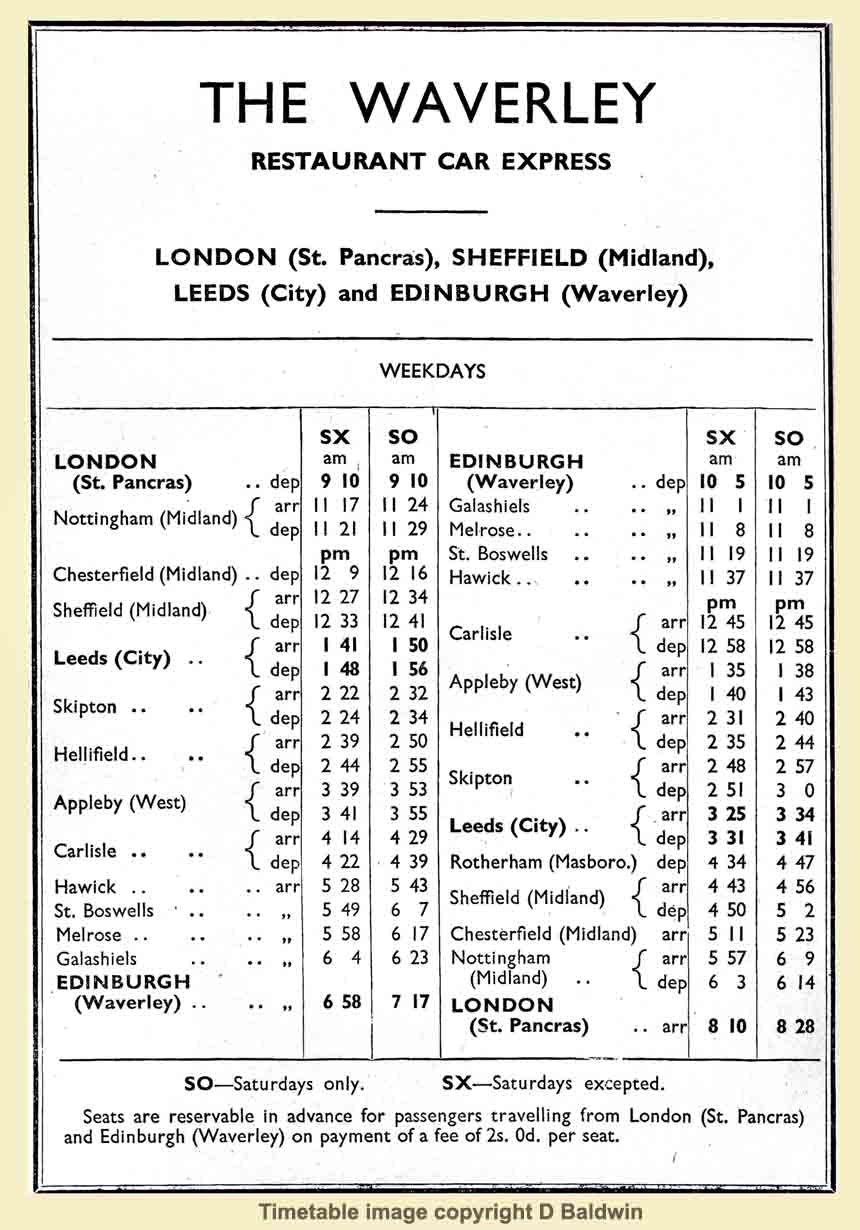
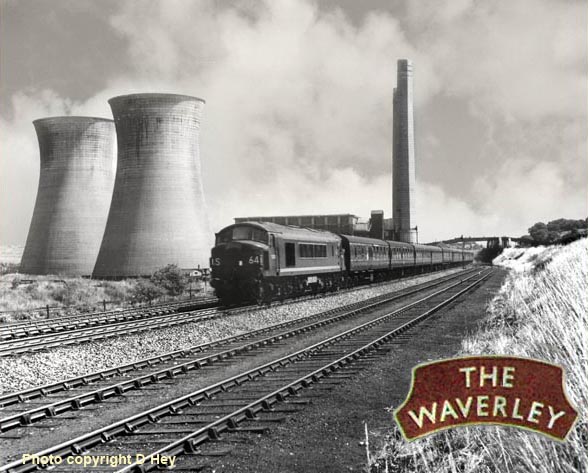
(Above) As mentioned above, the Anglo-Scottish 'Waverley' and 'Thames-Clyde' expresses became diesel-hauled at the start of the 1961 summer timetable. (Above) This stretch of the Aire Valley line between Leeds and Shipley was increased to four tracks at the turn of the century and involved the construction of a flyover junction at Kirkstall to segregate local Leeds-Bradford trains from through traffic to Scotland over the Settle-Carlisle line. The giant cooling towers of Kirkstall Power Station dominate this shot of 'Peak' Type 4 No D30 heading the northbound 1S64 'Waverley' express past Kirkstall Power Station in July 1961. The 183 production 'Peak' Type 4s (Class 45-56) were similar in appearance to the pilot scheme Class 44s except for front-end variations when the gangway doors and headcode discs were abandoned in favour of route indicator panels to aid train identification. The earlier production 'Peaks' appeared with divided headcode boxes either side of the nose whereas the later examples (below) were fitted with their headcode panels centrally placed. This reporting number 1S68 identifies the northbound 'Thames-Clyde Express', hence the carrying of a named train headboard is unnecessary, but it does add panache to the diesel-hauled express. This shot of the 'down' express entering Newlay Cutting in August 1961 is one of only a few shots I have showing a 'Peak' with the 'Thames-Clyde' headboard attached on the nose end.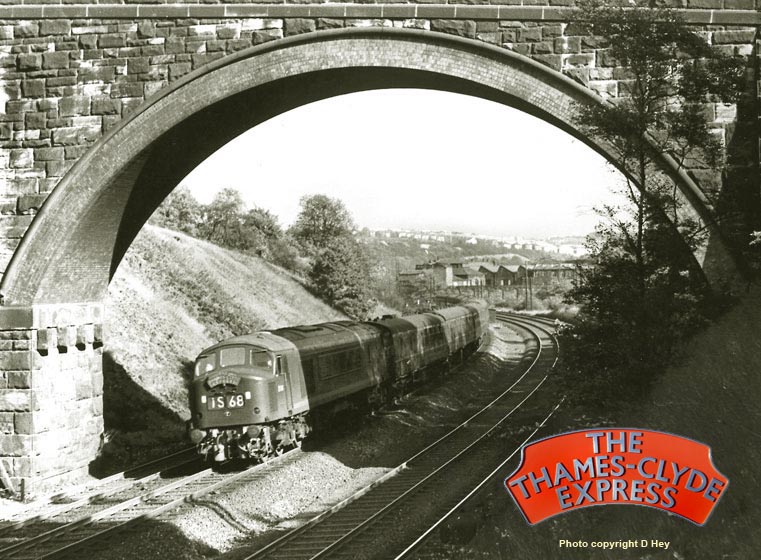

(Above-Inset-Below) Introduced in 1951, the new BR Class 5MT 4-6-0 was a direct descendant of the well-known LMS 'Black 5' introduced in 1934. In view of the 'Black 5s' first-class performances in everyday 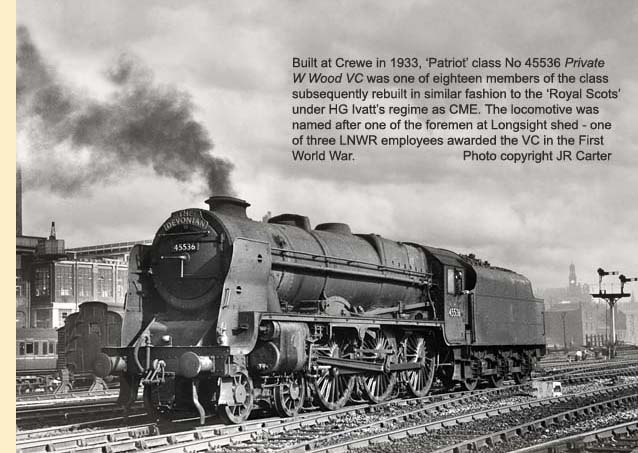 service perhaps it would have been simpler (cheaper) if BR had adopted the Stanier design as one of its standard classes? Although the 'BR5' was basically similar to the Stanier engine in its boiler and motion, the Riddles design looked very different from the LMS engine. Here, No 73131 pilots an unidentified 'Black 5' on the southbound 'Devonian' express out of Leeds City. (Inset Right) Another fine study by Footplate Cameraman, Jim Carter of 'Patriot' class No 45536 Private W Wood VC awaiting the arrival of the 'Devonian' from Bradford Forster Square. 'The Devonian' was an inter-Regional titled train that originated in 1927 and initially applied to the Bradford-Torquay and Paignton section of through coaches, handed over by the LMS to the GWR at Bristol Temple Meads. The service came to an end at the outbreak of World War 2, but was restored in October 1946. The introduction of diesel haulage and the journey time was reduced to just over 8 hours. Latterly a Restaurant Car service was provided between
service perhaps it would have been simpler (cheaper) if BR had adopted the Stanier design as one of its standard classes? Although the 'BR5' was basically similar to the Stanier engine in its boiler and motion, the Riddles design looked very different from the LMS engine. Here, No 73131 pilots an unidentified 'Black 5' on the southbound 'Devonian' express out of Leeds City. (Inset Right) Another fine study by Footplate Cameraman, Jim Carter of 'Patriot' class No 45536 Private W Wood VC awaiting the arrival of the 'Devonian' from Bradford Forster Square. 'The Devonian' was an inter-Regional titled train that originated in 1927 and initially applied to the Bradford-Torquay and Paignton section of through coaches, handed over by the LMS to the GWR at Bristol Temple Meads. The service came to an end at the outbreak of World War 2, but was restored in October 1946. The introduction of diesel haulage and the journey time was reduced to just over 8 hours. Latterly a Restaurant Car service was provided between 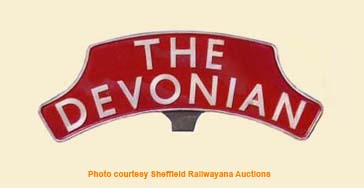 Leeds and Paignton. (Inset Left) A cast aluminium BR(M) 'Devonian' headboard measuring 36" x 12½" was sold at Sheffield Railwayana Auctions for £4,500 in September 2011. For serious students of Britain's railway history the auction catalogues provide some fascinating background details on the items for sale. For example, the back metal of the 'Devonian' headboard (right) was stamped with the legend 'Train Name Board W786 26-4-49'. Similar inscriptions applied to the names of other headboards produced to the same dimensions, such as: 'The Red Rose', 'The Red Dragon', 'The Bristolian' and the 'Inter-City'. The back was also stamped with the word 'Bristol' indicating the owning depot. A link to the interesting Sheffield Railwayana website can be found at the foot of the page.
Leeds and Paignton. (Inset Left) A cast aluminium BR(M) 'Devonian' headboard measuring 36" x 12½" was sold at Sheffield Railwayana Auctions for £4,500 in September 2011. For serious students of Britain's railway history the auction catalogues provide some fascinating background details on the items for sale. For example, the back metal of the 'Devonian' headboard (right) was stamped with the legend 'Train Name Board W786 26-4-49'. Similar inscriptions applied to the names of other headboards produced to the same dimensions, such as: 'The Red Rose', 'The Red Dragon', 'The Bristolian' and the 'Inter-City'. The back was also stamped with the word 'Bristol' indicating the owning depot. A link to the interesting Sheffield Railwayana website can be found at the foot of the page.
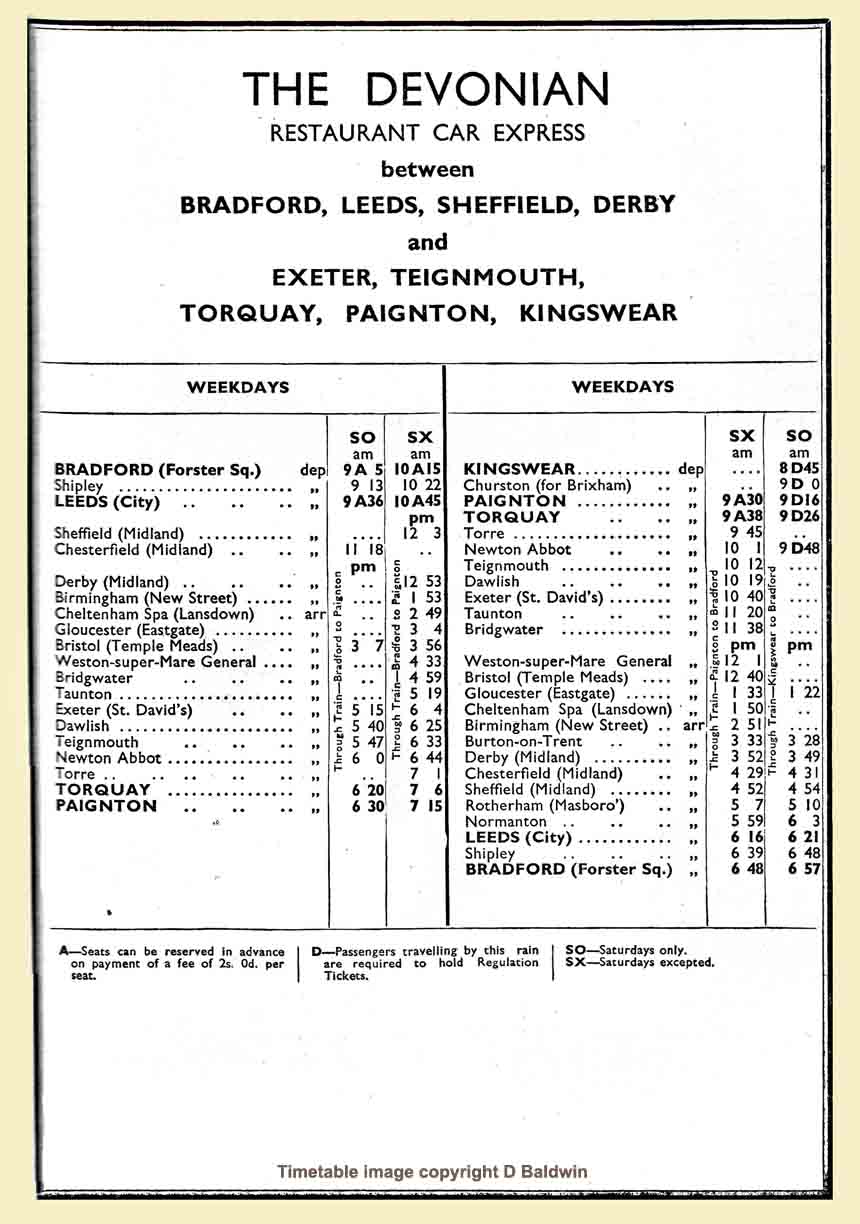
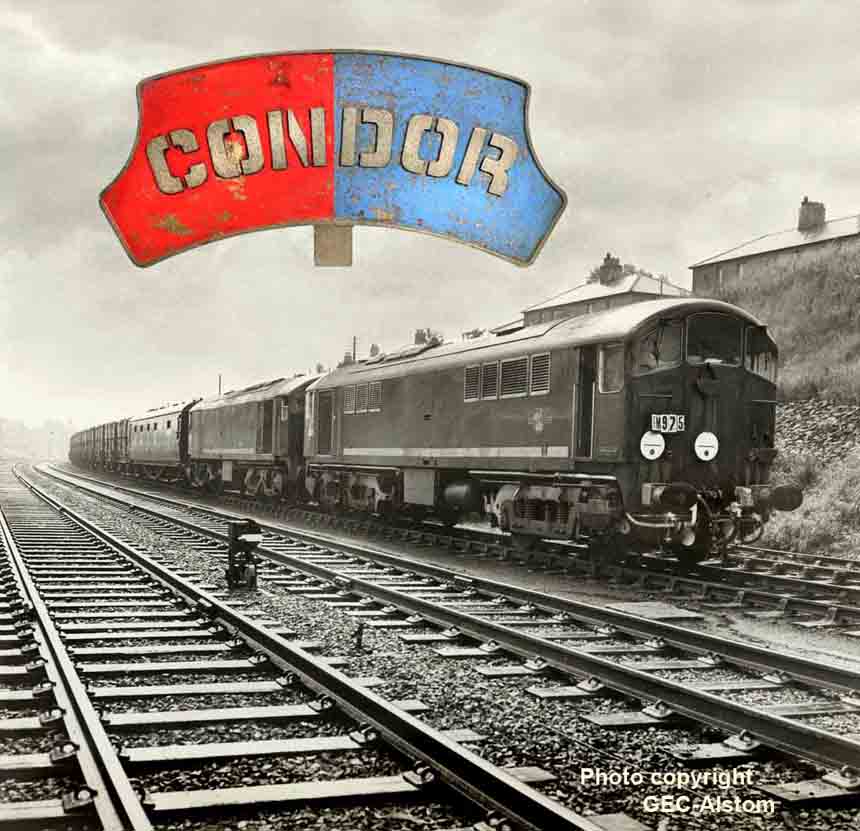
(Above-Below) Before taking our leave of the Midland main line out of St Pancras, we feature a 'named' goods train 'The Condor' which was introduced in 1959. On October 1st 1958, the first of the Metro-Vick Co-Bos Nos D5700 and D5701 hauled a train comprised of 25 fitted 'plateflats' from Hendon to Glasgow in order to evaluate their capabilities when working as a pair on a new 'Condor' overnight freight service. The Condor (an abbreviation of container door-to-door) was one of the first attempts at container freight traffic in Britain, and made its inaugural run on March 16th 1959, its main attraction being a guaranteed overnight delivery between London and Glasgow. Prior to its introduction, tests were carried out under controlled trial conditions, comprised of a dynometer coach and 25 short wheelbase vacuum braked flats. The test train is seen at Skipton. Inserted in the photo is a locomotive headboard, 'The Condor', as carried by the Co-Bos on this London (Hendon) and Birmingham (Aston) to Glasgow (Gushetfaulds) overnight freight services. The London train ran from March 1959 to October 1967 and the Birmingham service from January 1963 to November 1967. This unique style of headboard carries LMR and ScR colours and has split lettering. The headboard - clearly in ex-loco condition - went under the hammer at a Great Central Railwayana Auction in July 2012. (Below) Returning to the WCML titled trains, the 'Manxman' titled train was introduced by the LMS in July 1927, but was withdrawn during the War and re-introduced by BR in July 1951. The service from Euston to Liverpool Lime Street operated only during the summer timetable and ran in conjunction with sailings from Liverpool to the Isle of Man. Its last titled run was on 16th April 1966. Inserted in the phtos is a cast aluminium headboard measuring 32¼" in width and complete with integral bracket and spring clip, which went under the hammer at a Great Central Railwayana Auction in October 2009. The front has multiple coats of red paintwork, the top layer almost certainly applied by BR and there are plenty of signs of wear from day-to-day use. The back is also marked 'The Comet' (a headboard of similar dimensions).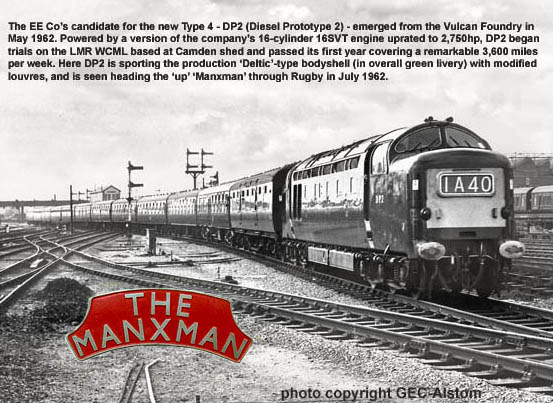
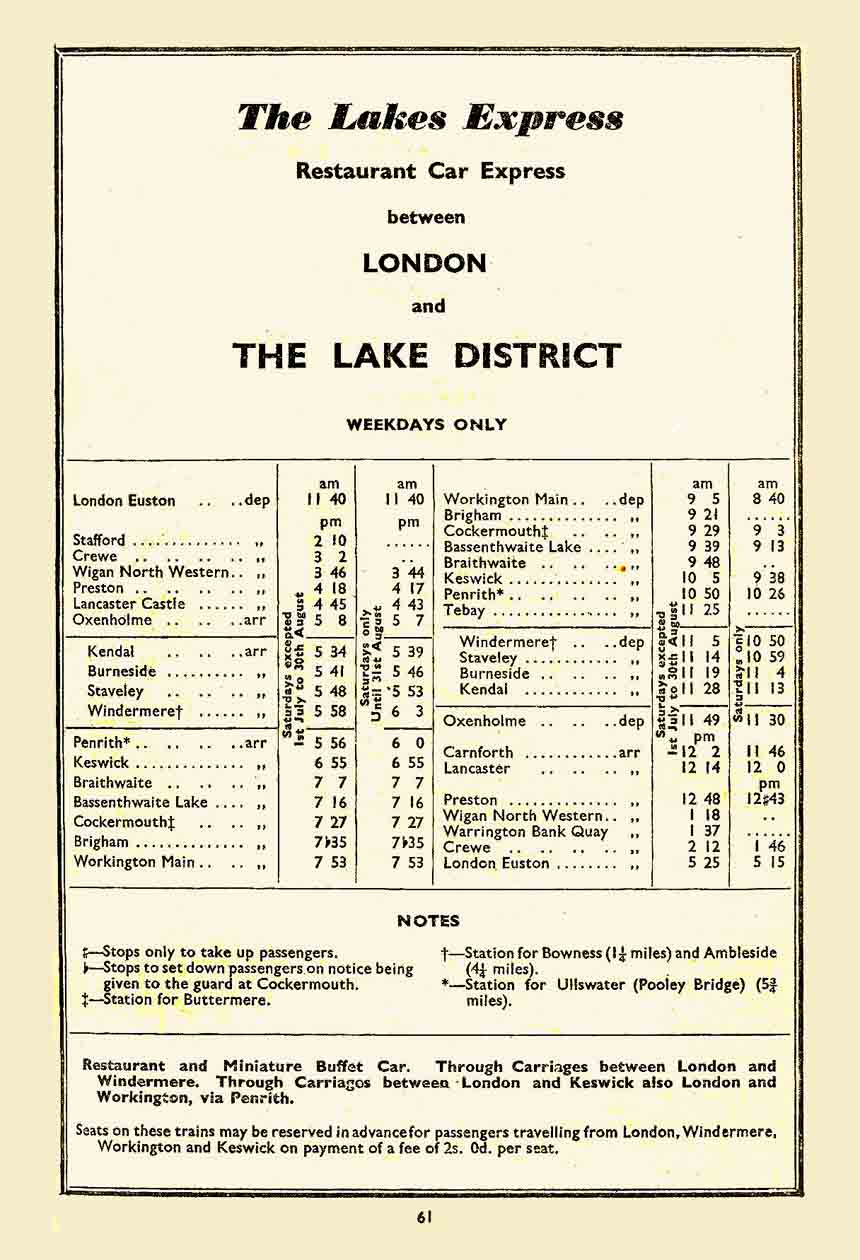
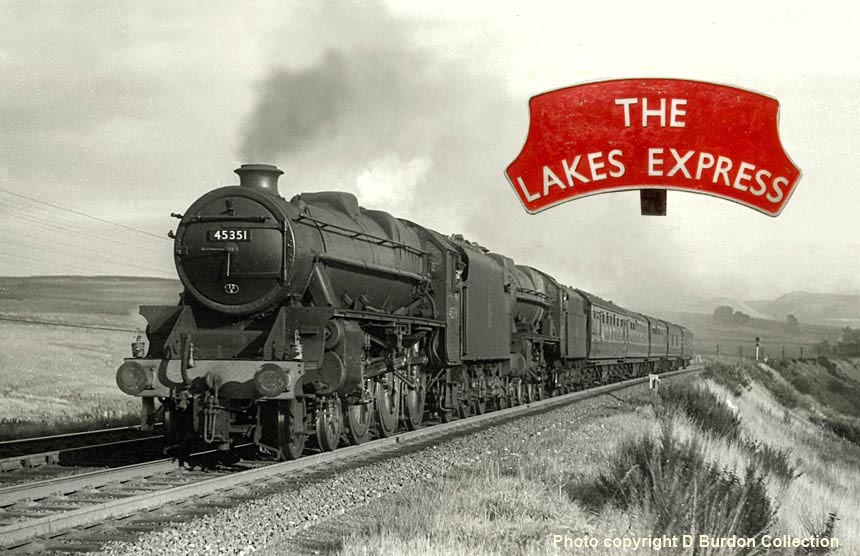
(Above-Insets) The 'Lakes Express' was introduced by the LMS on the Euston to Windermere and Workington service in 1927. It was withdrawn during the war and not re-introduced until 1950. The Windermere portion was detached at Oxenholme and the remaining train went on to Penrith where it reversed direction towards Workington via Keswick. Here an unidentified 'Royal Scot' class is piloted by 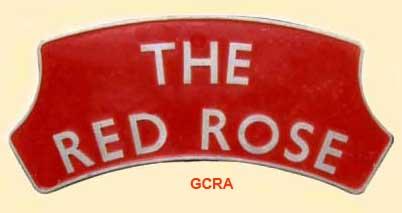 'Black 5' No 45351 on Shap Bank with the 'down' Workington portion. This headboard (inserted in the photo) was introduced in about 1951, this being the only style used on the train. The cast aluminium headboard measuring 33¼" x 15½" went under the hammer at a Great Central Railwayana Auction; the Lot was in ex-loco condition with red paintwork, and the back marked Camden 1B, indicating the owning shed. (Left) The 'Red Rose' was a title introduced by BR on 3rd May 1951 specially for the Festival of Britain and conferred on the existing 12.05
'Black 5' No 45351 on Shap Bank with the 'down' Workington portion. This headboard (inserted in the photo) was introduced in about 1951, this being the only style used on the train. The cast aluminium headboard measuring 33¼" x 15½" went under the hammer at a Great Central Railwayana Auction; the Lot was in ex-loco condition with red paintwork, and the back marked Camden 1B, indicating the owning shed. (Left) The 'Red Rose' was a title introduced by BR on 3rd May 1951 specially for the Festival of Britain and conferred on the existing 12.05 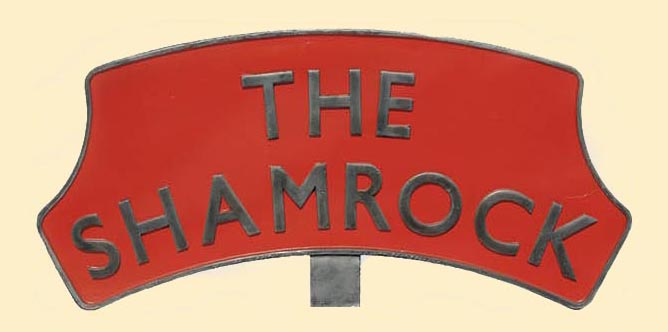 p.m. service from Euston and the 5.25 p.m. return working from Liverpool Lime Street. Its last titled run was on 16th April 1966. A cast aluminium headboard measuring 33¼" with integral bracket and original red paintwork, went under the hammer at a Great Central Railwayana Auction in April 2012. The front of the headboard has been repainted, but the back is in original condition and stamped 1B (Camden) denoting the owning shed. (Right) A locomotive headboard, 'The Shamrock', as carried on the Euston to Liverpool (Lime Street) service which operated in conjunction with sailings from Liverpool to Dublin and Belfast. Its inaugural titled run was on 14 June 1954 and its last on 16 April 1966...
p.m. service from Euston and the 5.25 p.m. return working from Liverpool Lime Street. Its last titled run was on 16th April 1966. A cast aluminium headboard measuring 33¼" with integral bracket and original red paintwork, went under the hammer at a Great Central Railwayana Auction in April 2012. The front of the headboard has been repainted, but the back is in original condition and stamped 1B (Camden) denoting the owning shed. (Right) A locomotive headboard, 'The Shamrock', as carried on the Euston to Liverpool (Lime Street) service which operated in conjunction with sailings from Liverpool to Dublin and Belfast. Its inaugural titled run was on 14 June 1954 and its last on 16 April 1966...![]()
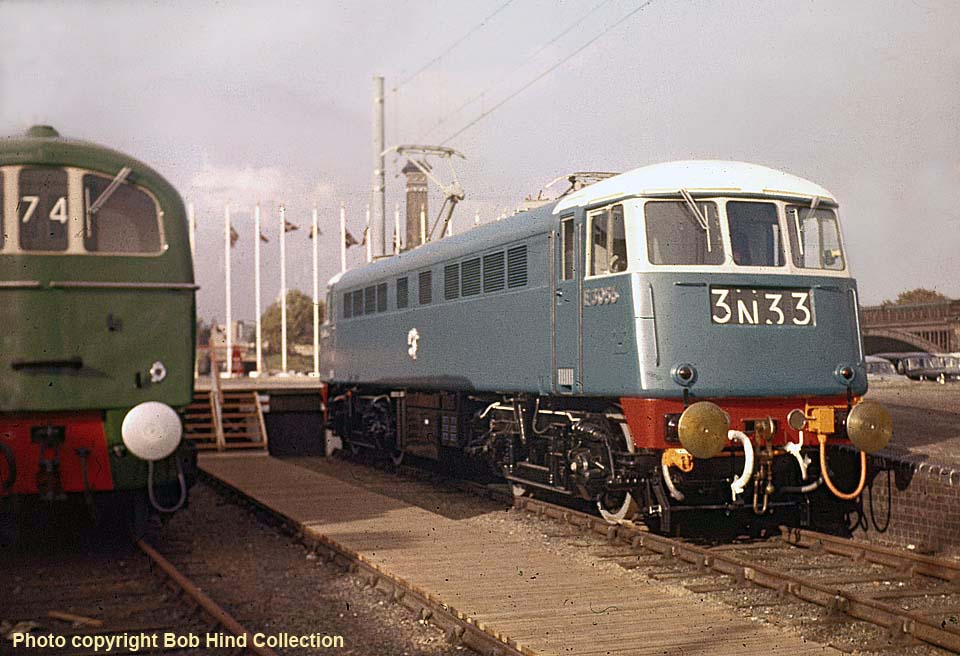
(Inset-Below) 1966...this brings me to the fleet of AC electric locomotives which took over in 1966 following the electrification of the WCML south of Crewe. By 1972 the London departure time of the Royal Scot had become 10.00 (09.25 from Glasgow) with a total journey time of 6 hours 35 minutes. Following completion of electrification 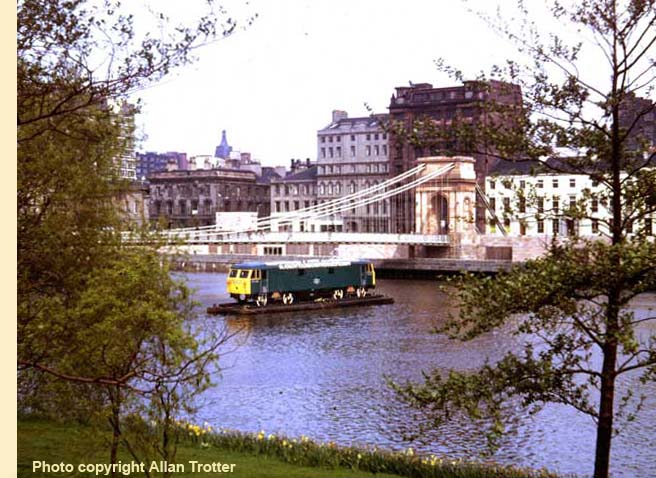 throughout from Euston to Glasgow in 1973-4, British Rail's naming policy decreed that its new Class 87 fleet should become the new 'Royal Scot' class, and the locomotives were named with appropriate Anglo-Scottish themes, however the fleet is better known as 'Electric Scots' to avoid clashing with the earlier steam locomotive class of that name. (Inset Right) It seems fitting to end this page with a tongue-in-cheek poser sent to me by Allan Trotter from Eastbank Model Railway Club, Glasgow; he wrote - 'Did you know there were two locos that carried the number 87001? One was of course the real one but there was also a full size wooden replica. It is seen here as part of British Rail's high seas fleet on a barge moored on the Clyde promoting the introduction of the 'Electric Scots' in May 1974. The vessel was patrolled 24/7 by a chap in a rowing boat as the barge and loco was considered a hazard to navigation.
throughout from Euston to Glasgow in 1973-4, British Rail's naming policy decreed that its new Class 87 fleet should become the new 'Royal Scot' class, and the locomotives were named with appropriate Anglo-Scottish themes, however the fleet is better known as 'Electric Scots' to avoid clashing with the earlier steam locomotive class of that name. (Inset Right) It seems fitting to end this page with a tongue-in-cheek poser sent to me by Allan Trotter from Eastbank Model Railway Club, Glasgow; he wrote - 'Did you know there were two locos that carried the number 87001? One was of course the real one but there was also a full size wooden replica. It is seen here as part of British Rail's high seas fleet on a barge moored on the Clyde promoting the introduction of the 'Electric Scots' in May 1974. The vessel was patrolled 24/7 by a chap in a rowing boat as the barge and loco was considered a hazard to navigation.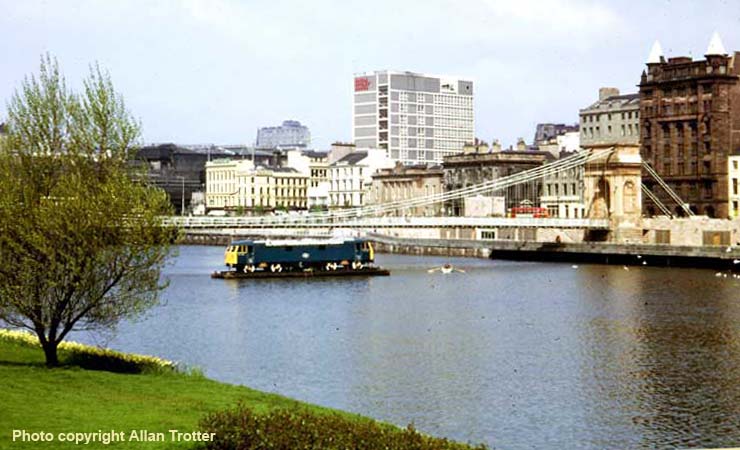
BRITISH TITLED TRAINS - WESTERN REGION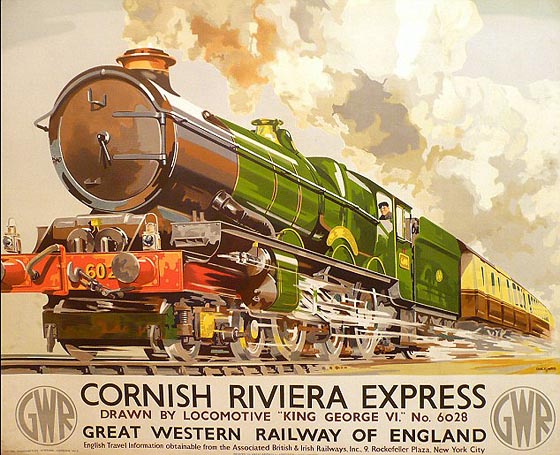
(Above-Below) I can think of no other train that captured the imagination of this small boy than the GWR's 'Cornish Riviera Express'; the name alone conjured up images of blue seas and sun-kissed beaches. Back in the Fifties, pictures of chocolate and cream carriages being hauled by a mighty 'King' class locomotive seemed to feature in every small boys 'Bumper' book of trains. Indeed the 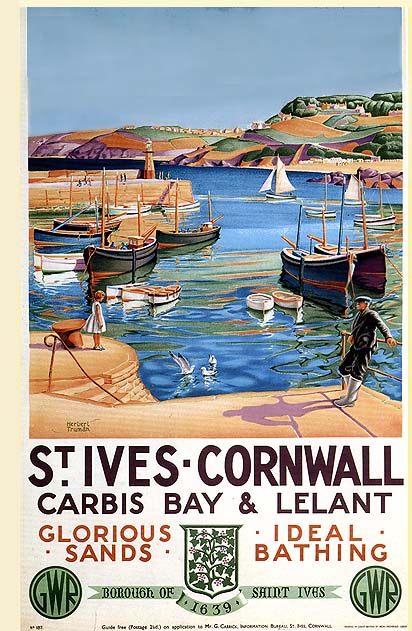 company's publicity machine elevated the London-Penzance express into one of the most famous trains in the world. Photographs of the express skirting the south Devon coastline were a marketing man's dream!
company's publicity machine elevated the London-Penzance express into one of the most famous trains in the world. Photographs of the express skirting the south Devon coastline were a marketing man's dream!
Prior to nationalisation in 1948, the 'Big Four' railway companies commissioned a number of artists, including members of the Royal Academy, to produce artwork for railway travel posters. In particular they were keen to promote the most beautiful parts of the country through which their lines served, and the GWR wasted no time in publicizing the holiday destinations in the West Country. It's fair to say that during the inter-war years the popularity of many Devon and Cornish resorts was largely due to the enterprise of the GWR's promotional campaigns. For example, the 'Cornish Riviera' was promoted intensively not only in the UK but also in the USA, including this fine study (above) of 'King' class No 6028 King George V1 - perhaps the company was playing on America's inordinate fondness for British royalty since the name of the engine features prominently on the poster. Then there is this fine study by Murray Seccretan (below) of a 'King' class emerging from Parson's Tunnel between Dawlish and Teignmouth in 1935. The NRM's Collections is a superb website and includes a range of railway posters HERE...a visit is highly recommended.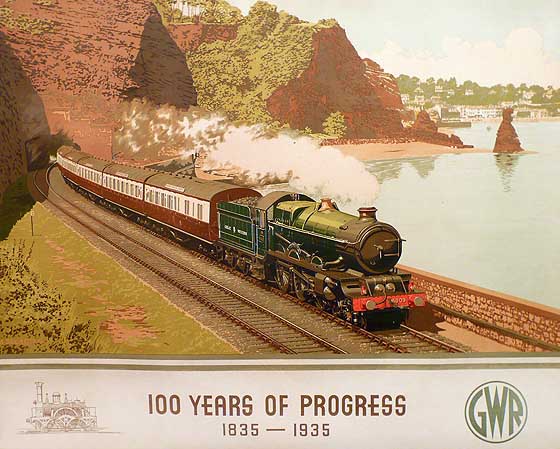

(Above-Inset-Below) During the Fifties, BR made great strides with the fitting of titled train headboards to the front of locomotives. The standard pattern keystone-shaped headboards had polished Gill Sans  lettering mounted on a black background (later red was adopted by the London Midland Region and blue by the Eastern Region). By 1956, however, the Western region took full advantage of BR's leniency towards the uniformity of headboard designs, including changes to the wording on the headboards too. The WR's new 'Cornish Riviera Express' headboard had a cast crest which superceded the earlier (shorter) 'Cornish Riviera' title, as seen (above) on 'King' class No 6015 King Richard 111 heading the 'up' Cornish Riviera' through Reading on 31st August 1951. Inserted in the photo is a locomotive headboard, as used on this famous Paddington to Penzance service. The cast aluminium headboard board measures 33" across with the integral bracket stamped LA (Laira) indicating the owning depot. The headboard went under the
lettering mounted on a black background (later red was adopted by the London Midland Region and blue by the Eastern Region). By 1956, however, the Western region took full advantage of BR's leniency towards the uniformity of headboard designs, including changes to the wording on the headboards too. The WR's new 'Cornish Riviera Express' headboard had a cast crest which superceded the earlier (shorter) 'Cornish Riviera' title, as seen (above) on 'King' class No 6015 King Richard 111 heading the 'up' Cornish Riviera' through Reading on 31st August 1951. Inserted in the photo is a locomotive headboard, as used on this famous Paddington to Penzance service. The cast aluminium headboard board measures 33" across with the integral bracket stamped LA (Laira) indicating the owning depot. The headboard went under the 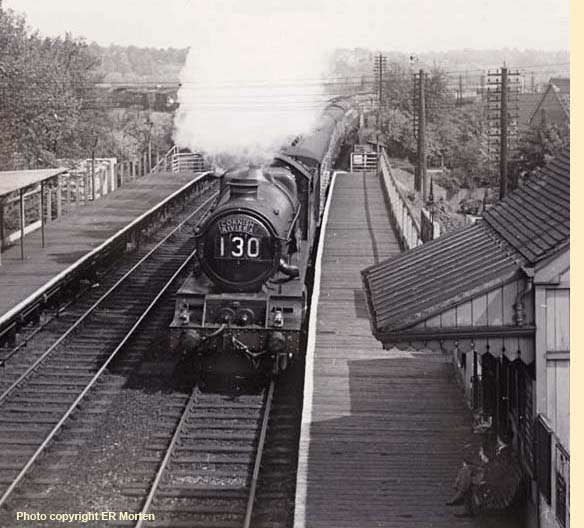 hammer at a Great Central Railwayana Auction in January 2012. A link to the GCRA's website can be found at the foot of the page. (Inset Left) 'King' class No 6026 King John heads the 'down' train through Reading West, a little over 36 miles out of Paddington on its 305 mile run to Penzance on 10th May 1952. (Below) The Great Western Railway and the St Ives branch in its heyday! The arrival of the 'Cornish Riviera Express' from Paddington must have been quite something! Having survived the Beeching axe the original station was replaced by a smaller terminus built on the site of the abandoned goods shed, seen extreme right of photo - goods traffic was withdrawn in September 1963. This shot of the 'Cornish Riveria Express' is posted courtesy of the St Ives Museum, which is situated in the old fishing quarter overlooking St Ives Bay. The museum houses displays and collections relating to this beautiful Cornish town.
hammer at a Great Central Railwayana Auction in January 2012. A link to the GCRA's website can be found at the foot of the page. (Inset Left) 'King' class No 6026 King John heads the 'down' train through Reading West, a little over 36 miles out of Paddington on its 305 mile run to Penzance on 10th May 1952. (Below) The Great Western Railway and the St Ives branch in its heyday! The arrival of the 'Cornish Riviera Express' from Paddington must have been quite something! Having survived the Beeching axe the original station was replaced by a smaller terminus built on the site of the abandoned goods shed, seen extreme right of photo - goods traffic was withdrawn in September 1963. This shot of the 'Cornish Riveria Express' is posted courtesy of the St Ives Museum, which is situated in the old fishing quarter overlooking St Ives Bay. The museum houses displays and collections relating to this beautiful Cornish town. 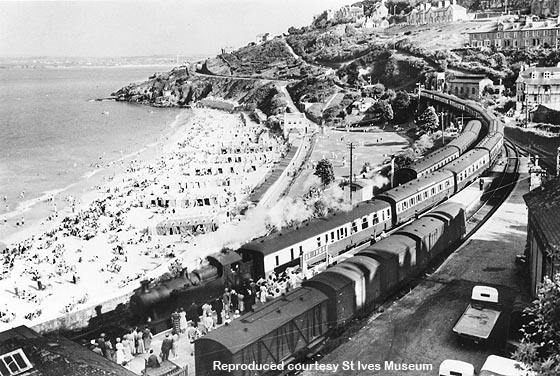

(Above-Below). Cornish Riviera oil on canvas...one of the best ways of painting a technical artwork is by copying the detail from a photograph. But that raises the question of who owns the copyright - the artist or the photographer? Indeed, few artists can claim not to be inspired by a great photograph. I certainly have. The one man who has fired my enthusiasm for the Western Region is Dick Blenkinsop, whose photographs have been a source of inspiration. In particular I recall his shot of 'Battle of Britain' class No 34061 73  Squadron heading a local Plymouth-Exeter train along the seal wall between Dawlish and Teignmouth. It appears in 'Echoes of the Big Four', in which he says - 'It is not easy to obtain pictures of trains with a clear seascape in the background.' Oh, but there is! It's called artistic licence! And this is the result: a painting of No 6024 King Edward 1 heading the 'down' 'Cornish Riviera Express', albeit judging from the lighting the train is running very early or extremely late! (Below) Steam haulage was replaced by the early diesel-hydraulic 'Warship' class (D600s) in 1958 before the D800 Warships took over in 1960. The new 'Warship' class was an innovative design inspired by the Deutsche Bundesbahn V200 series incorporating the use of a stressed skin construction which enabled a high power/weight ratio to be achieved. The first 33 locomotives (and final five) were built at Swindon, whereas Nos D833-D865 were constructed by the North British Locomotive Company, Glasgow. Here Swindon-built D817 Foxhunter awaits departure from Plymouth with the 'Cornish Riviera Express'. By this time British Railways had abandoned the aged 'disc' display system (a legacy of steam days) in favour of a new four-character letter and numeral headcode display. The train classification, destination and identification system was introduced to assist signalmen in identifying trains. The headcodes consisted of a four-character display; the first numeral identifying the class of train, followed by a letter indicating the destination, whilst the next two digits represented the train reporting number. For example, a headcode display starting with a '1' denoted an express passenger train and, until the system came fully into operation, locomotives were often seen with the first numeral showing only, or in this case the letter 'A' is displayed.
Squadron heading a local Plymouth-Exeter train along the seal wall between Dawlish and Teignmouth. It appears in 'Echoes of the Big Four', in which he says - 'It is not easy to obtain pictures of trains with a clear seascape in the background.' Oh, but there is! It's called artistic licence! And this is the result: a painting of No 6024 King Edward 1 heading the 'down' 'Cornish Riviera Express', albeit judging from the lighting the train is running very early or extremely late! (Below) Steam haulage was replaced by the early diesel-hydraulic 'Warship' class (D600s) in 1958 before the D800 Warships took over in 1960. The new 'Warship' class was an innovative design inspired by the Deutsche Bundesbahn V200 series incorporating the use of a stressed skin construction which enabled a high power/weight ratio to be achieved. The first 33 locomotives (and final five) were built at Swindon, whereas Nos D833-D865 were constructed by the North British Locomotive Company, Glasgow. Here Swindon-built D817 Foxhunter awaits departure from Plymouth with the 'Cornish Riviera Express'. By this time British Railways had abandoned the aged 'disc' display system (a legacy of steam days) in favour of a new four-character letter and numeral headcode display. The train classification, destination and identification system was introduced to assist signalmen in identifying trains. The headcodes consisted of a four-character display; the first numeral identifying the class of train, followed by a letter indicating the destination, whilst the next two digits represented the train reporting number. For example, a headcode display starting with a '1' denoted an express passenger train and, until the system came fully into operation, locomotives were often seen with the first numeral showing only, or in this case the letter 'A' is displayed.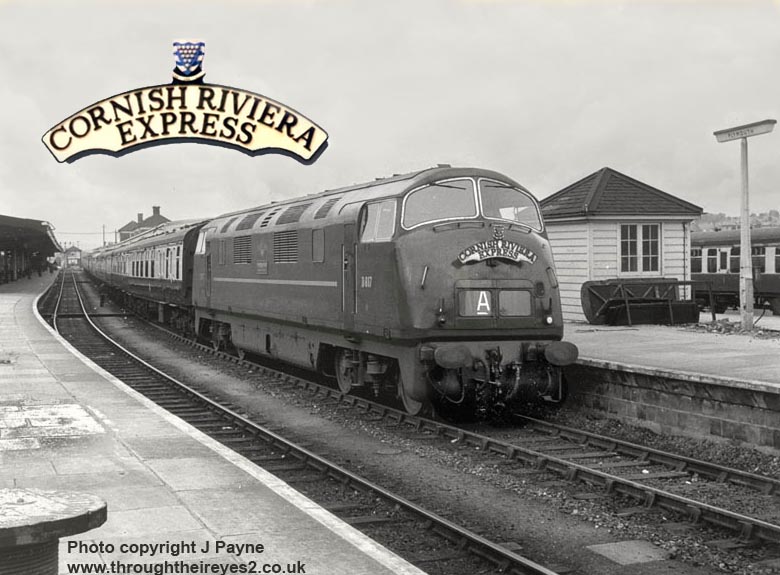
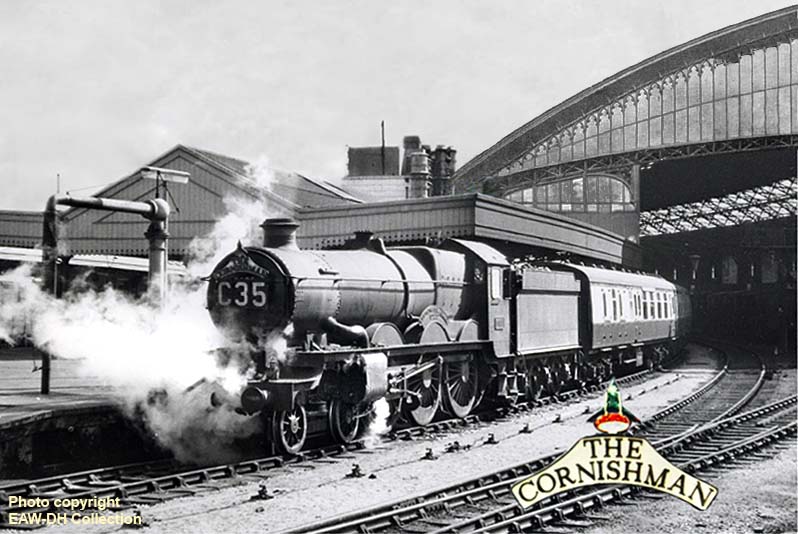
(Above-Below) The 'Cornishman' has a long and varied career. The train made its debut on Brunel's Broad 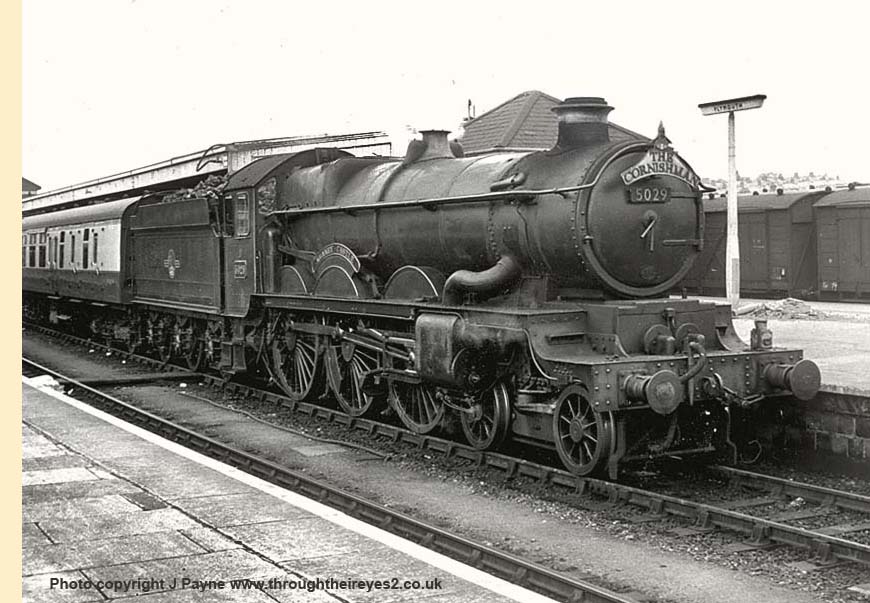 Gauge in the summer of 1890 between London and Penzance, departing Paddington at 10.15 and stopping at Bristol, Exeter and Plymouth, with arrival at Penzance at 19.50. With a journey time of 8hrs 35 minutes for the 325 miles, the 'Cornishman' was the fastest train in the west of England. The GWR replaced the 'Cornishman' with the 'Cornish Riviera Limited' in 1904 and the name was not used again until 1935 when it appeared in the summer timetable for one year only as the 10.35 relief to the Limited. The 'Cornishman' title was reinstated by the BR Western Region' in June 1952, departing Wolverhampton Low Level at 09.15 and travelling via Birmingham Snow Hill, Stratford-upon-Avon, Cheltenham and Bristol, arriving at Penzance at 17.55. In 1967, the train was extended northwards over the LMR via Derby and Sheffield to Leeds and Bradford Forster
Gauge in the summer of 1890 between London and Penzance, departing Paddington at 10.15 and stopping at Bristol, Exeter and Plymouth, with arrival at Penzance at 19.50. With a journey time of 8hrs 35 minutes for the 325 miles, the 'Cornishman' was the fastest train in the west of England. The GWR replaced the 'Cornishman' with the 'Cornish Riviera Limited' in 1904 and the name was not used again until 1935 when it appeared in the summer timetable for one year only as the 10.35 relief to the Limited. The 'Cornishman' title was reinstated by the BR Western Region' in June 1952, departing Wolverhampton Low Level at 09.15 and travelling via Birmingham Snow Hill, Stratford-upon-Avon, Cheltenham and Bristol, arriving at Penzance at 17.55. In 1967, the train was extended northwards over the LMR via Derby and Sheffield to Leeds and Bradford Forster  Square. Sporing the ornate 'Cornishman' headboard featuring a leprechaun leapfrogging a toadstool (Above) 'Castle' class No 5089 Westminster Abbey' awaits departure from Bristol Temple Meads with the northbound train in the early 1960s. (Inset Right) 'Castle' class No 5029 Nunney Castle awaits departure from Plymouth with the 'Cornishman. (Below) The first six NBL Co's Type 2 B-B diesel-hydraulic locos Nos D6300-D6305 (later Class 22) were ordered as part of the BTC's pilot-scheme, but as so often happened in the mad rush to get rid of steam, an order for 52 more machines was placed even before the first, No D6300, had been built. The Type 2 was designed to be used singly for secondary work or coupled in multiple for heavier duties, which entailed the fitting of gangway connections in the nose ends. However, the NBL/MAN engine of the additional locos were uprated to 1,100hp in order to correspond with the NBL-built D800 Warship class then being built, thus providing further flexibility in multiple working and future engine changes between both classes. The entire Class 21 was later fitted with four character headcode boxes on either side of the centre gangway door. Here North British Type 3 B-Bs Nos D6321-18 have just backed onto the 'Cornishman' coaching stock at Plymouth.
Square. Sporing the ornate 'Cornishman' headboard featuring a leprechaun leapfrogging a toadstool (Above) 'Castle' class No 5089 Westminster Abbey' awaits departure from Bristol Temple Meads with the northbound train in the early 1960s. (Inset Right) 'Castle' class No 5029 Nunney Castle awaits departure from Plymouth with the 'Cornishman. (Below) The first six NBL Co's Type 2 B-B diesel-hydraulic locos Nos D6300-D6305 (later Class 22) were ordered as part of the BTC's pilot-scheme, but as so often happened in the mad rush to get rid of steam, an order for 52 more machines was placed even before the first, No D6300, had been built. The Type 2 was designed to be used singly for secondary work or coupled in multiple for heavier duties, which entailed the fitting of gangway connections in the nose ends. However, the NBL/MAN engine of the additional locos were uprated to 1,100hp in order to correspond with the NBL-built D800 Warship class then being built, thus providing further flexibility in multiple working and future engine changes between both classes. The entire Class 21 was later fitted with four character headcode boxes on either side of the centre gangway door. Here North British Type 3 B-Bs Nos D6321-18 have just backed onto the 'Cornishman' coaching stock at Plymouth. 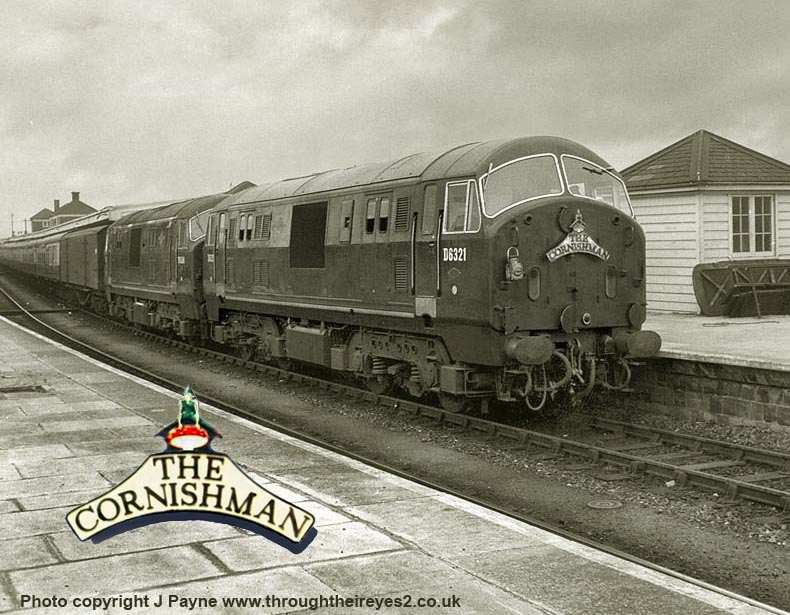
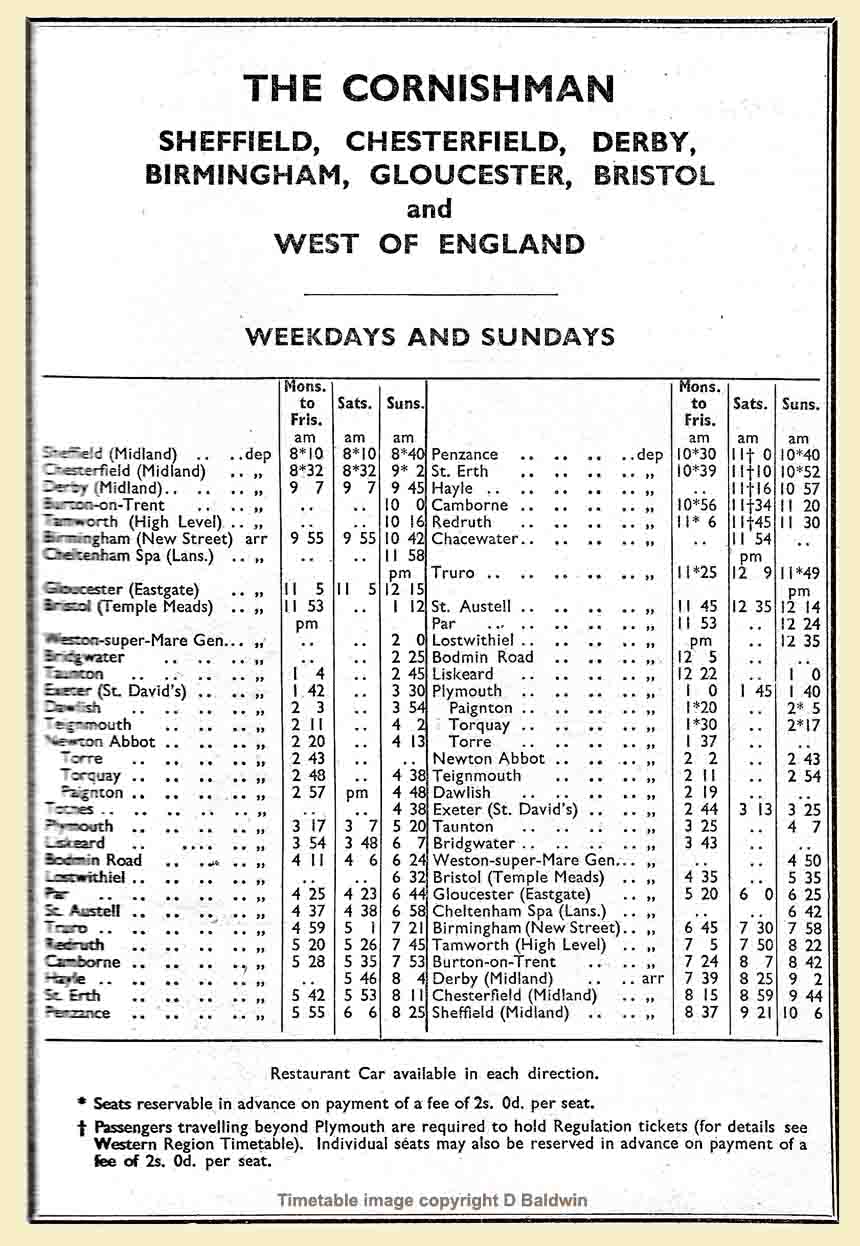
(Inset Right-Below) An unidentified 'Castle' class arrives at Bristol Temple Meads with the northbound 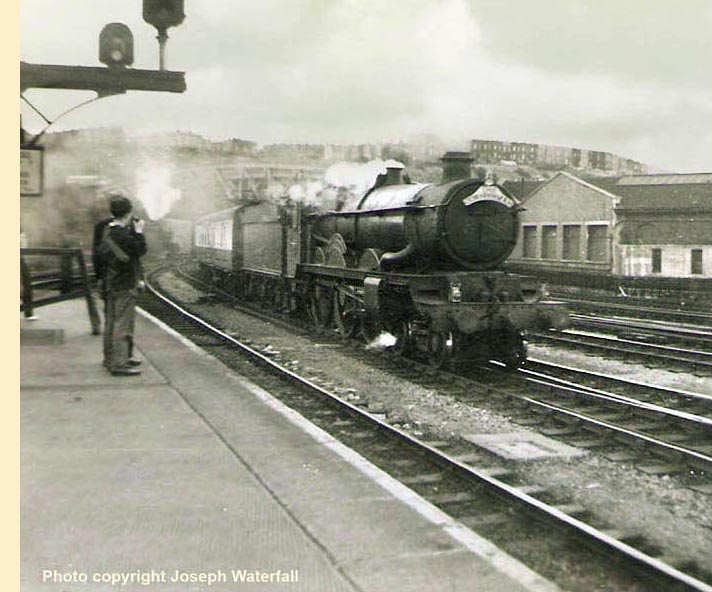 'Cornishman' in June 1959. (Below) On the same day, Joseph Waterfall took this photo of an unidentified 'Warship' class with his trusty Kodak Brownie 127 and describes it as arriving at Bristol Temple Meads from Penzance in June 1959. Now it is not always easy to establish every detail in some of our fifty-odd year old photos, but on closer inspection the headboard looks suspiciously like 'The Bristolian' to me. Perhaps the train reporting number '075' offers the biggest clue…my own research has drawn a blank. The non-stop 'Bristolian' from London (Paddington) to Bristol (Temple Meads) was introduced in 1935 as part of the celebrations to mark the Centenary of the Great Western Railway. Departing Paddington at 10.00am the high-speed journey via Bath produced an average speed of 67.6 mph for the 1¾-hour journey. The 4.30pm return working via the shorter direct line through Badmington was similarly timed at 1¾ hours. However, like
'Cornishman' in June 1959. (Below) On the same day, Joseph Waterfall took this photo of an unidentified 'Warship' class with his trusty Kodak Brownie 127 and describes it as arriving at Bristol Temple Meads from Penzance in June 1959. Now it is not always easy to establish every detail in some of our fifty-odd year old photos, but on closer inspection the headboard looks suspiciously like 'The Bristolian' to me. Perhaps the train reporting number '075' offers the biggest clue…my own research has drawn a blank. The non-stop 'Bristolian' from London (Paddington) to Bristol (Temple Meads) was introduced in 1935 as part of the celebrations to mark the Centenary of the Great Western Railway. Departing Paddington at 10.00am the high-speed journey via Bath produced an average speed of 67.6 mph for the 1¾-hour journey. The 4.30pm return working via the shorter direct line through Badmington was similarly timed at 1¾ hours. However, like 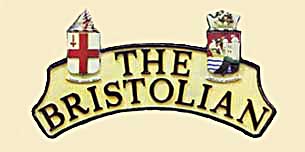 many expresses of the day, the 'Bristolian' was postponed during the Second World War and it wasn't until 1954 that British Railways restord the service; the headboard (inset left) with the coats of arms of London and Bristol was introduced in the summer timetable of 1956. The seven-coach formation of 220 tons was usually hauled by a 'Castle' class and speeds of 100 mph were not unknown; several instances of the journey being completed in less than 94 minutes (averaging 75.2 mph) were recorded. The last 'Bristolian' titled train ran in June 1965, though the name continues to be used by First Great WesternPlymouth.
many expresses of the day, the 'Bristolian' was postponed during the Second World War and it wasn't until 1954 that British Railways restord the service; the headboard (inset left) with the coats of arms of London and Bristol was introduced in the summer timetable of 1956. The seven-coach formation of 220 tons was usually hauled by a 'Castle' class and speeds of 100 mph were not unknown; several instances of the journey being completed in less than 94 minutes (averaging 75.2 mph) were recorded. The last 'Bristolian' titled train ran in June 1965, though the name continues to be used by First Great WesternPlymouth.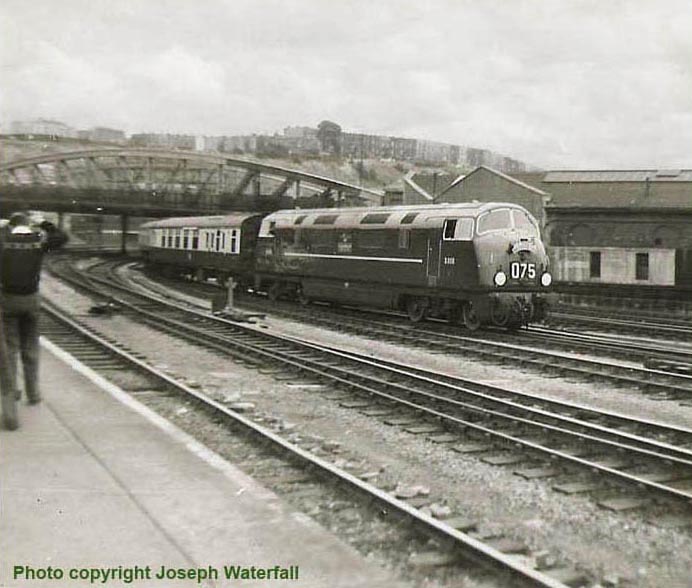

(Above-Below) Framed by typical GWR lower quadrant signals, the doyen of Collett's 'King' class, introduced to traffic in 1927, celebrity loco No 6000 King George V, heads the 'Cambrian Coast Express' at Hatton. (Below) An impressive titled train headboard - 'Cambrian Coast Express - as carried by the locomotives working the through service from Paddington to Aberystwyth and Pwllheli in North Wales. The titled train was introduced by the GWR in July 1927, but withdrawn in September 1939 at the outbreak of World War Two. The Western Region of British Railways reinstated the service in July 1951. This style of headboard, incorporating the Cambrian Railways coat-of-arms, was used from the start of the 1958 summer timetable until the last titled run on 4th March 1967. This headboard (illustrated) was sold at Great Central Auctions for £13,600 on 16th July 2011, and of particular interest is that it was the last headboard used in service. The Lot came complete with bracket and wing nut fixings, together with a purpose-made steel bracket which, when fixed to a wall, would support the overall 52½" span of the headboard for display...a fantastic piece of railway memorabilia courtesy Great Central Railwayana Auctions. A link to the GCRA website can be found at the foot of this page.


(Insets-Below) The 'Devonian' was an inter-regional titled train that originated in 1927 and initially applied to the Bradford-Torquay and Paignton section of through coaches, handed over by the LMS to the GWR at 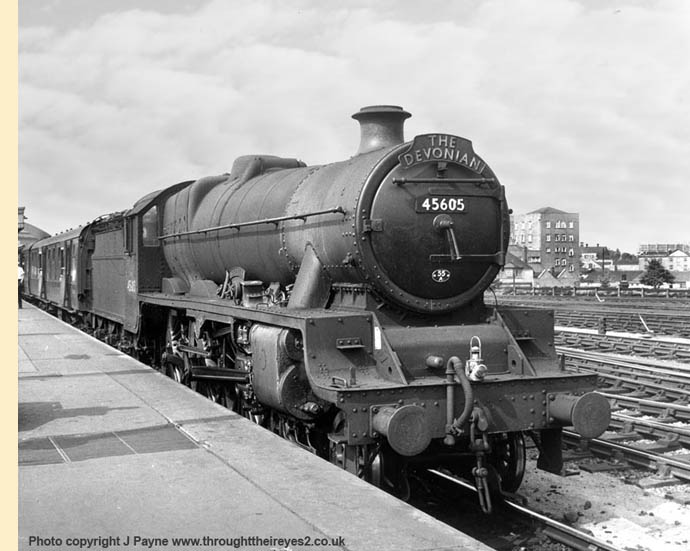 Bristol Temple Meads. Following the LMS Midland Division accelerations of 1937 the train departed Bradford at 10:25am arriving Torquay at 6:44pm and Paignton at 6:51pm. The northbound train left Paignton at 9:15am arriving Bradford at 5:54pm. The service came to an end at the outbreak of World War 2, but was restored in October 1946, albeit with an increased journey time. This was not improved upon until the introduction of diesel haulage and the journey time was reduced to just over 8 hours. Latterly a Restaurant Car service was provided between Leeds and Paignton. (Inset Right) Holbeck's 'Jubilee' class No
Bristol Temple Meads. Following the LMS Midland Division accelerations of 1937 the train departed Bradford at 10:25am arriving Torquay at 6:44pm and Paignton at 6:51pm. The northbound train left Paignton at 9:15am arriving Bradford at 5:54pm. The service came to an end at the outbreak of World War 2, but was restored in October 1946, albeit with an increased journey time. This was not improved upon until the introduction of diesel haulage and the journey time was reduced to just over 8 hours. Latterly a Restaurant Car service was provided between Leeds and Paignton. (Inset Right) Holbeck's 'Jubilee' class No 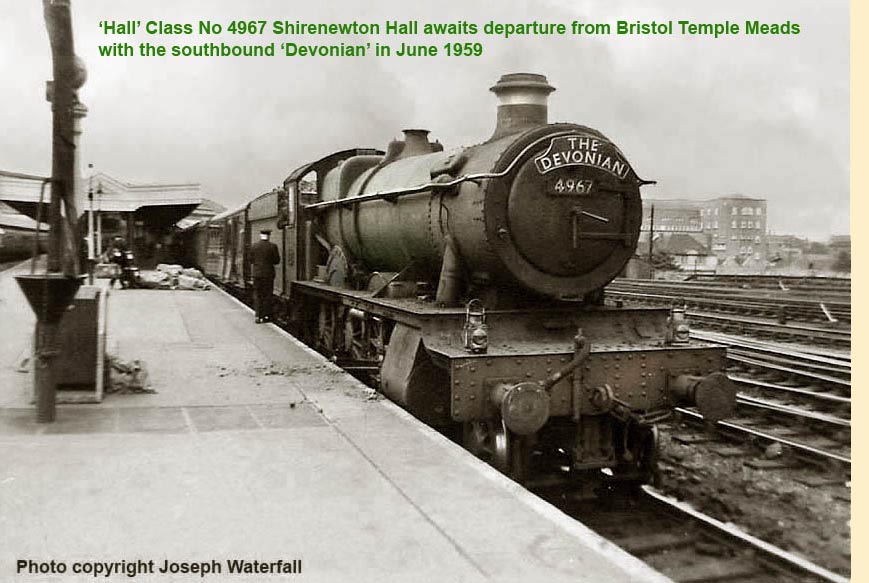 45605 Cyprus couples onto the stock of the 'Devonian' at Bristol Temple Meads in June 1960. (Below) A cast aluminium BR(M) 'Devonian' headboard measuring 36" x 12½" was sold at Sheffield Railwayana Auctions for £4,500 on 10th September 2011. For serious students of Britain's railway history the auction catalogues provide some fascinating background details on the items for sale. For example, the back metal of the 'Devonian' headboard was stamped with the legend 'Train Name Board W786 26-4-49'. Similar inscriptions applied to the names of other headboards produced to the same dimensions, such as: 'The Red Rose', 'The Red Dragon', 'The Bristolian' and the 'Inter-City'. The back was also stamped with the word 'Bristol' indicating the owning depot. A link to the interesting Sheffield Railwayana website can be found bottom of page.
45605 Cyprus couples onto the stock of the 'Devonian' at Bristol Temple Meads in June 1960. (Below) A cast aluminium BR(M) 'Devonian' headboard measuring 36" x 12½" was sold at Sheffield Railwayana Auctions for £4,500 on 10th September 2011. For serious students of Britain's railway history the auction catalogues provide some fascinating background details on the items for sale. For example, the back metal of the 'Devonian' headboard was stamped with the legend 'Train Name Board W786 26-4-49'. Similar inscriptions applied to the names of other headboards produced to the same dimensions, such as: 'The Red Rose', 'The Red Dragon', 'The Bristolian' and the 'Inter-City'. The back was also stamped with the word 'Bristol' indicating the owning depot. A link to the interesting Sheffield Railwayana website can be found bottom of page.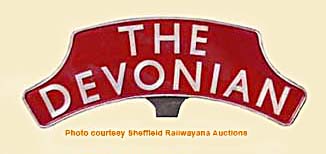
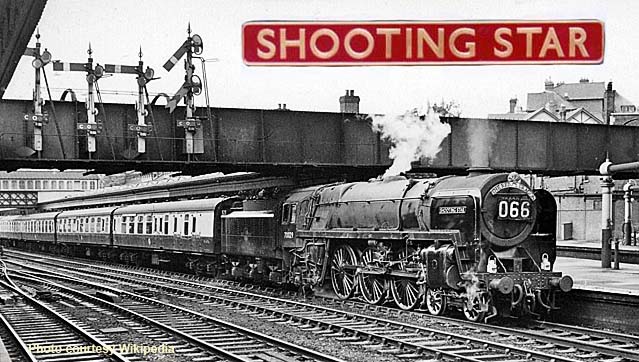
(Above-Below) The 'Red Dragon' at Newport Station on 10th October 1958. Newport was one of the busiest railway stations in Britain, with about 250 trains daily, two-thirds of which consisted of freight traffic originating from the South Wales coal mines located in the Eastern and Western Valleys. One of the station's most prestigious trains was the 07.30 Carmarthen-Paddington 'Red Dragon', seen here headed by BR Standard Class 7MT 'Britannia' 4-6-2 No 70029 'Shooting Star'. Built at Crewe to Order E483/228 under Swindon Lot 403, No 70029 entered service at Cardiff Canton in November 1952 and stayed there until September 1961. This was followed by a three-year spell based at Aston before the loco was transfered to Carlisle Kingmoor in October 1964, where it was withdrawn in October 1967 and finally broken up at J McWilliam, Shettleston in March 1968. This cast brass nameplate (inset) went under the hammer for £15,100 at a Sheffield Railwayana Auction in March 2009. 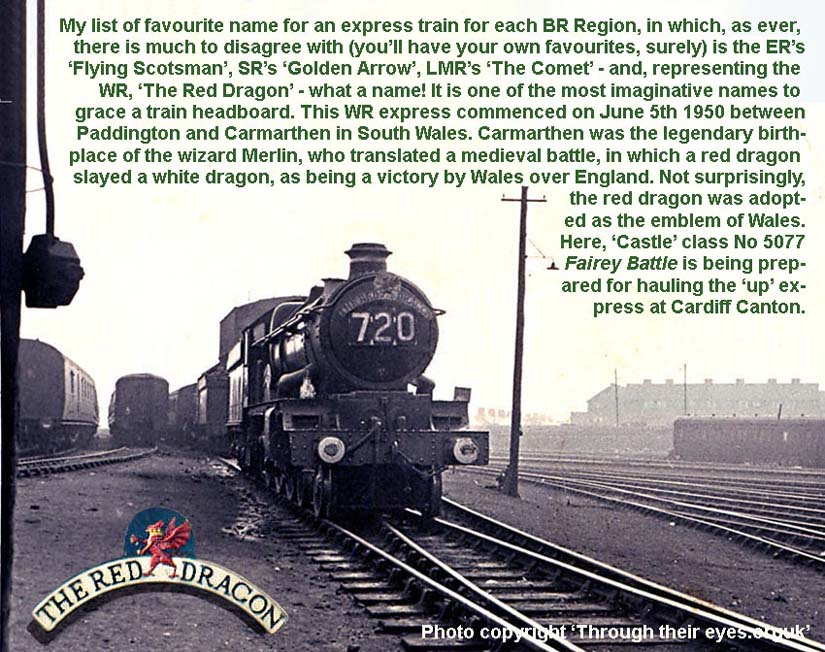

(Above-Below) The 'Cathedrals Express' was another flamboyant WR train headboard which went under the hammer at a Great Western Railwayana Auction in May 2010....link at bottom of page. The headboard was carried by both Worcester and Old Oak 'Castles' on 'The Cathedrals Express' between Paddington and the cathedral cities of Oxford, Worcester and Hereford. The titled train first appeared in the Western Region timetable on 16th September 1957, departing Hereford at 06.43 and returning at 18.22 from Paddington. (Below) 'Castle' class No 5001 Llandovery Castle arrives at Paddington with the morning train on 15th May 1962. Built in September 1926, No 5001 underwent performance tests during a brief spell in 1931 when its standard 6ft 8½ inch coupled wheels were substituted by smaller 6ft 6in driving wheels. A double chimney and 4 row superheater were fitted in June 1961, but with the introduction of Type 4 diesel-hydraulics gathering pace the loco was one of several ousted from traffic on the Western Region in 1963. No 5001 was withdrawn from Old Oak Common in February 1963 and scrapped at Cashmore's, Great Bridge.
FOOTNOTE A message has been left on the Guest Book Page by Phillip Dredge, who writes - 'Please don't forget that the 'Cathedrals Express' also had a Kidderminster portion linking up at Worcester Shrub Hill. It was normally pulled by a small prairie tank complete with headboard...' Duly noted...thanks Phillip.

(Above) 'Castle' class No 5079 Lysander of Newton Abbot shed (83A) heads the down 'Torbay Express' on Wednesday 13 June 1951, only a short time before the delayed 1951 Summer timetable came into operation on 2 July and all reporting numbers were revised; the down 'Torbay Express' subsequently became 146. On a Wednesday, the first stop for the down train was Exeter (2.52pm-2.57pm) followed by Torquay (3.35pm-3.39pm) then Kingswear by 4.10pm. No 5079 will haul the train throughout the 208½ miles. The loco was built as Lydford Castle in May 1939, acquiring its new name (one of twelve Castles renamed after WWII aircraft) in November 1940. It became one of the five Castles converted to oil-burners between January 1947 and September 1948. During that time it was in constant use between Newton Abbot and Penzance, and OS Nock had runs behind it that he described as 'excellent'. Withdrawal came in May 1960. 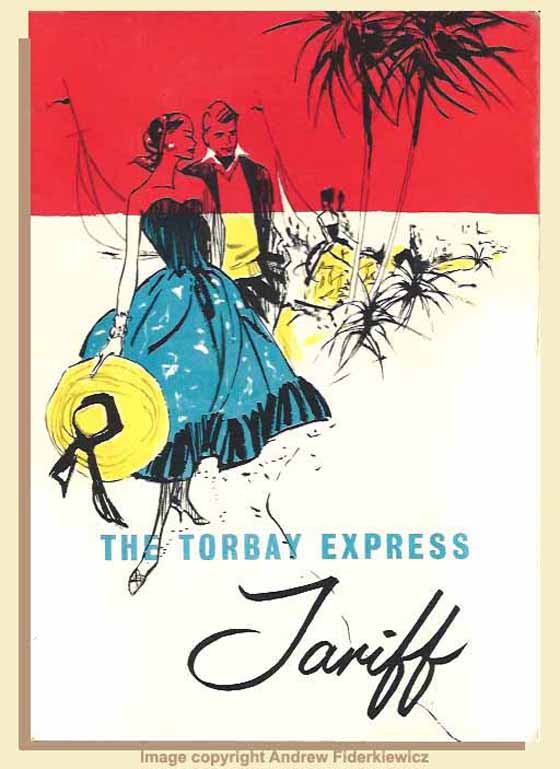
(Above-Below) My thanks to Andrew Fiderkiewicz for scanning this attractive 1960s menu cover and tariff for the 'Torbay Express' dining car. As a young train spotter living in Devon, Andrew cadged them from the dining car attendants during stopovers at stations! 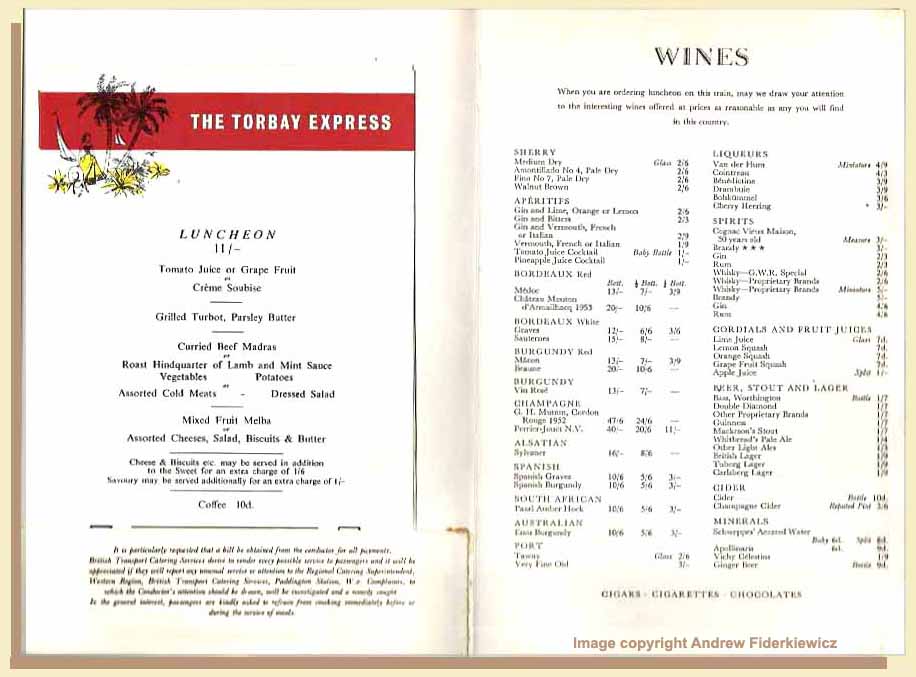
(Below) 'Castle' class No 5069 Isambard Kingdom Brunel heads the 'Royal Duchy' through Sonning Cutting. 5069 had been a Laira engine since 1954, acquiring a double chimney in November 1958 and was withdrawn in February 1962. Motive power for this train this was varied: sometimes a King, often a Castle, and more than once in the Summer of 1958 a 4700 class 2-8-0. On other occasions, a Modified Hall was used, and in extremis, a Collett Hall. Back to this picture, 5069 had a Heavy Intermediate overhaul at Swindon Works in early 1957; this photograph was taken soon after. 
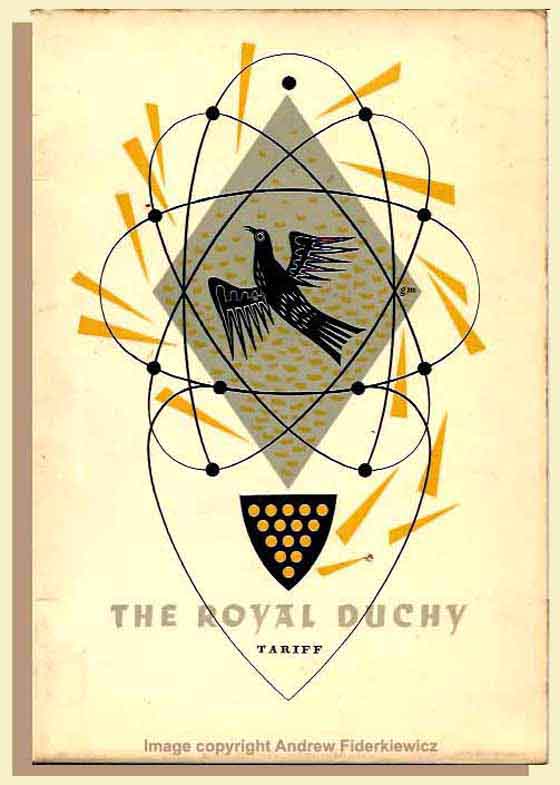
(Above-Below) Two more scans kindly sent by Andrew Fiderkiewicz showing the cover and inserted menu for the 'Royal Duchy' dining car from the 1960s. Of interest to WR fans is Andrew's feature 'Dainton Memories' on page 22 HERE which relates to the stop boards at the summit of Dainton Bank where all loose-coupled 'up' goods and mineral trains halted so that the required number of wagon brakes could be pinned down before departure down the bank. Andrew is currently restoring the corresponding sign for the picking up of brakes which was sited at the bottom of the incline alongside the Aller Junction up main starting signal. 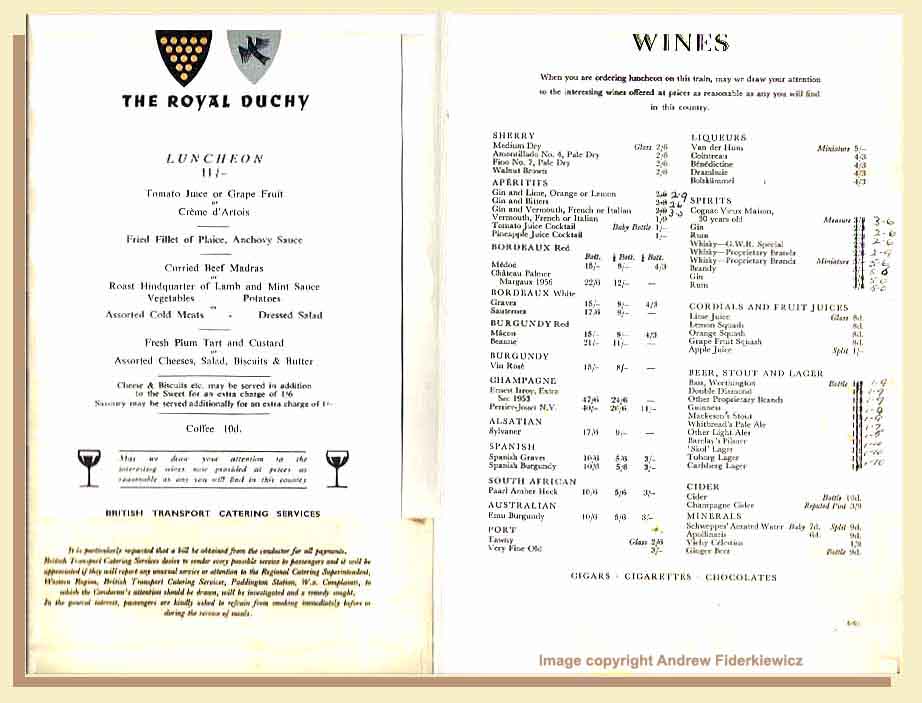
(Insets Below Left-Right) I just love surfing the Auction websites. Not only do they bring back fond memories of spotting days but they are a fantastic means of researching Britain's railway history. The background detail 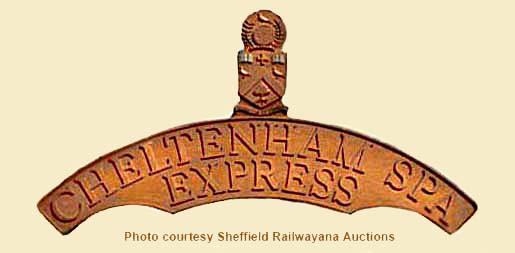 provided for each Lot is exemplary and the vast range of railwayana to be found is simply breathtaking; certainly Sheffield Railwayana Auctions has turned up some interesting Lots in its time. I was intrigued by the wooden patterns that recently went under the hammer; it begs the question whether they could be used to produce bona fide BR (WR) headboards. In other words - originals as opposed to replicas? This wooden pattern (left) for the 'Cheltenham Spa Express' - went under the hammer at a Sheffield Railwayana Auction in June 2009. The pattern was used to cast the aluminium headboard, and came complete with the 'Shop Copy' of the original drawings and specifications first drawn in 1956 with further modifications dated 1960 and 1962. The drawings show details of all dimensions, sizes, lettering, motif, colouring and finishes. The wooden pattern measures 56" in width and 10" at the widest part, plus an additional 13½" for the City of Cheltenham crest. It was a wonderful chance to purchase a beautifully crafted piece of BR's Western Region's history. The name was conferred on the afternoon Cheltenham-Paddington train after World War Two. The express had the nickname 'Cheltenham Flyer' after various accelerations in the 1920s, but this was never officially used. It was for a time the fastest train in the world scheduled to run at over 70mph in 1932, covering the 77¼ miles between
provided for each Lot is exemplary and the vast range of railwayana to be found is simply breathtaking; certainly Sheffield Railwayana Auctions has turned up some interesting Lots in its time. I was intrigued by the wooden patterns that recently went under the hammer; it begs the question whether they could be used to produce bona fide BR (WR) headboards. In other words - originals as opposed to replicas? This wooden pattern (left) for the 'Cheltenham Spa Express' - went under the hammer at a Sheffield Railwayana Auction in June 2009. The pattern was used to cast the aluminium headboard, and came complete with the 'Shop Copy' of the original drawings and specifications first drawn in 1956 with further modifications dated 1960 and 1962. The drawings show details of all dimensions, sizes, lettering, motif, colouring and finishes. The wooden pattern measures 56" in width and 10" at the widest part, plus an additional 13½" for the City of Cheltenham crest. It was a wonderful chance to purchase a beautifully crafted piece of BR's Western Region's history. The name was conferred on the afternoon Cheltenham-Paddington train after World War Two. The express had the nickname 'Cheltenham Flyer' after various accelerations in the 1920s, but this was never officially used. It was for a time the fastest train in the world scheduled to run at over 70mph in 1932, covering the 77¼ miles between  London and Swindon in just 65 minutes. The name lasted well into the 1970s. (Inset Right) Another wooden pattern, this one for 'The Merchant Venturer', went under the hammer in June 2011. The headboard measures 39" width and 17½" at the widest, and features the Merchant Venturers of Bristol coat of arms along with the Latin quotation 'Indocilis Pauperium Pati' (A poor man to suffer ignorance). This pattern was used to make the mould to cast the aluminium headboard and came complete with the 'Shop Copy' of the original drawings and specifications dated 1960. The drawings show all details of dimensions, sizes, lettering, motif, colouring and finishes. The train was introduced by the Western Region in 1951 running between Paddington and Weston-Super-Mare via Bristol; the service was named after the Society of Merchant Venturers, a private entrepreneurial and charitable organisation that was formed in 13th century Bristol. The Society helped to fund the building of Brunel's Clifton Suspension Bridge and also helped establish the Great Western Railway. The name continues to be used by First Great Western on the Paddington-Penzance via Bristol service.
London and Swindon in just 65 minutes. The name lasted well into the 1970s. (Inset Right) Another wooden pattern, this one for 'The Merchant Venturer', went under the hammer in June 2011. The headboard measures 39" width and 17½" at the widest, and features the Merchant Venturers of Bristol coat of arms along with the Latin quotation 'Indocilis Pauperium Pati' (A poor man to suffer ignorance). This pattern was used to make the mould to cast the aluminium headboard and came complete with the 'Shop Copy' of the original drawings and specifications dated 1960. The drawings show all details of dimensions, sizes, lettering, motif, colouring and finishes. The train was introduced by the Western Region in 1951 running between Paddington and Weston-Super-Mare via Bristol; the service was named after the Society of Merchant Venturers, a private entrepreneurial and charitable organisation that was formed in 13th century Bristol. The Society helped to fund the building of Brunel's Clifton Suspension Bridge and also helped establish the Great Western Railway. The name continues to be used by First Great Western on the Paddington-Penzance via Bristol service. 
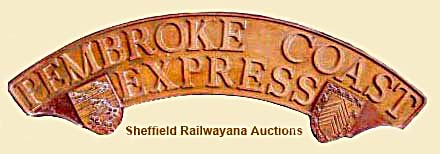 (Above-Inserts-Below) Another original wooden pattern for a locomotive headboard, 'The Pembroke Express', measuring 52" in width which was used to cast the aluminium headboard. Like the previous lots it came complete with the 'Shop Copy' of the original drawings and specifications dated 1960. The drawings show all details of dimensions, sizes, lettering, motif, colouring and finishes. The train was the 10.55 departure from Paddington for
(Above-Inserts-Below) Another original wooden pattern for a locomotive headboard, 'The Pembroke Express', measuring 52" in width which was used to cast the aluminium headboard. Like the previous lots it came complete with the 'Shop Copy' of the original drawings and specifications dated 1960. The drawings show all details of dimensions, sizes, lettering, motif, colouring and finishes. The train was the 10.55 departure from Paddington for  Pembroke Dock. (Insert Right) The name 'Capitals United' was originally used between 1956 and 1963 by British Railways Western Region for the service between Paddington and Cardiff-Swansea service to highlight the importance of the rail link between the capitals of England and Wales. (Below) King Class 4-6-0 No 6016 'King Edward V' heads the down 'Capitals United Express' through Reading on 1st July 1961. No 6016 was built at Swindon and allocated new to Laira in June 1928. It was withdrawn from Stafford Road on 7th September 1962 and sold for scrap to Cox & Danks of Langley Green on 15th November 1963.
Pembroke Dock. (Insert Right) The name 'Capitals United' was originally used between 1956 and 1963 by British Railways Western Region for the service between Paddington and Cardiff-Swansea service to highlight the importance of the rail link between the capitals of England and Wales. (Below) King Class 4-6-0 No 6016 'King Edward V' heads the down 'Capitals United Express' through Reading on 1st July 1961. No 6016 was built at Swindon and allocated new to Laira in June 1928. It was withdrawn from Stafford Road on 7th September 1962 and sold for scrap to Cox & Danks of Langley Green on 15th November 1963.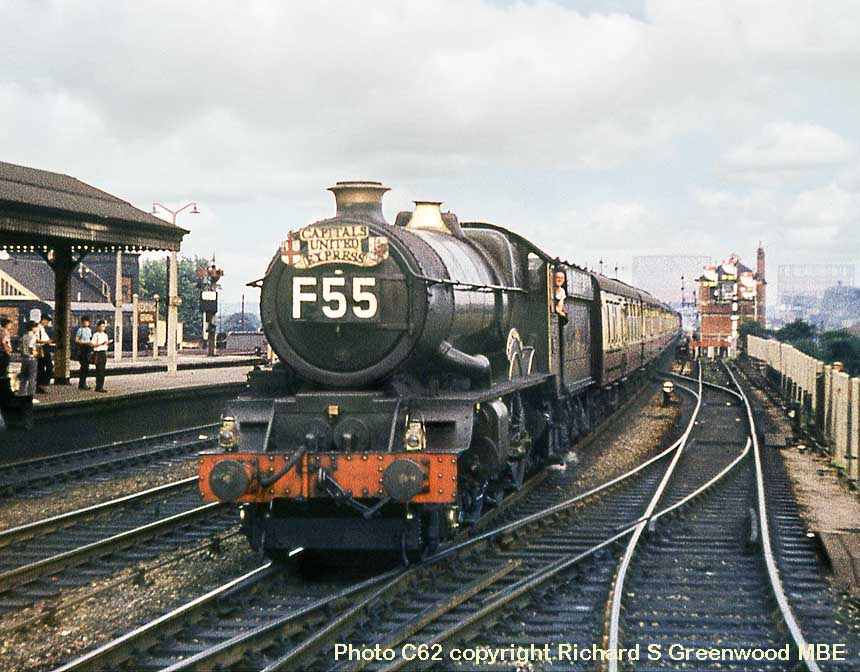
BR SOUTHERN REGION NAMED EXPRESSES
(Above-Inset Right-Below) Of all the Southern Region's luxury Pullman trains the 'Golden Arrow' was certainly the best known. The train began life in 1926 when a new all-first-class French Pullman train called  the 'Flèche d'Or' first ran between Calais and Paris, with a connecting ferry service across the English Channel to Dover. Three years later the Southern
the 'Flèche d'Or' first ran between Calais and Paris, with a connecting ferry service across the English Channel to Dover. Three years later the Southern 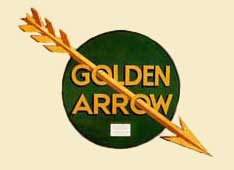 Railway introduced a first class Pullman service of its own, which provided cossetted passengers with their own reserved section on the cross-Channel steamer. On 15th May 1929 both the new 'Golden Arrow' and 'Flèche d' Or' trains left London and Paris at 11.00 am; the British train comprised of ten Pullman cars, headed by one of the Southern Railway's new 'Lord Nelson' class locos. At the outbreak of World War Two the luxury Pullman was suspended until hostilities ceased and the service wasn't resumed until 15th April 1946. (Above) A rare 1956 carriage print 'Golden Arrow Continental Express' reproduced from a water colour by Richard Ward, went under the hammer at a recent GW Railway Auction. The print shows the train emerging from the unusually shaped portals of Shakespeare Tunnel, between Dover and Folkestone. The locomotive is one of BR Standard 'Britannia' class 4-6-2 Pacifics. (Inset Left) Another
Railway introduced a first class Pullman service of its own, which provided cossetted passengers with their own reserved section on the cross-Channel steamer. On 15th May 1929 both the new 'Golden Arrow' and 'Flèche d' Or' trains left London and Paris at 11.00 am; the British train comprised of ten Pullman cars, headed by one of the Southern Railway's new 'Lord Nelson' class locos. At the outbreak of World War Two the luxury Pullman was suspended until hostilities ceased and the service wasn't resumed until 15th April 1946. (Above) A rare 1956 carriage print 'Golden Arrow Continental Express' reproduced from a water colour by Richard Ward, went under the hammer at a recent GW Railway Auction. The print shows the train emerging from the unusually shaped portals of Shakespeare Tunnel, between Dover and Folkestone. The locomotive is one of BR Standard 'Britannia' class 4-6-2 Pacifics. (Inset Left) Another 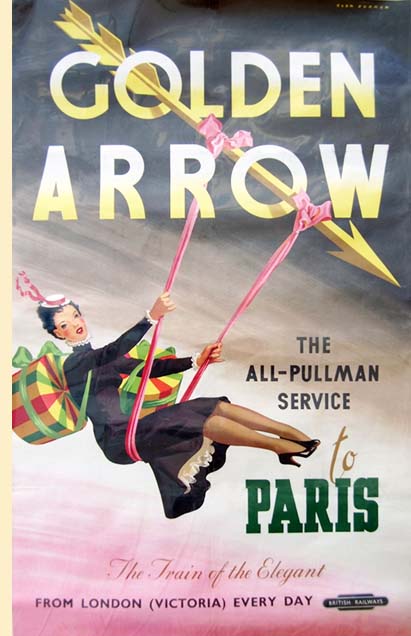 variation on the 'Golden Arrow' theme is this wooden presentation headboard 'Golden Arrow' painted in the original colours by staff at Eastleigh, the three-flight arrow with gold leaf is 66" from tip to tail and the central disc 33" in diameter as in the original steel version. BR Southern Region commissioned the design which coincided both with the introduction of BR's two 'Britannia' Class 7MT Pacifics, Nos 70004 William Shakespeare and 70014 Iron Duke to the service in 1951, and with the 'Festival of Britain' exhibition held in London the same year. The ornate headboard was used until the early 1960s when the service was taken over by the 2,550hp third-rail electric locomotives (later Class 71) and a plain headboard was deemed more suitable (see photo of Dover Marine below). At the base is an ivorine label which states that the headboard was presented by BR Southern Region on the occasion of the renaming of a Public House in the 1950s. The vendor purchased the board when the establishment in Dover closed some years ago. The item went under the hammer for £1,800 at a Sheffield Railwayana Auction in September 2008 (Below) Yet another variation...a superb Hornby Class 7MT 'Britannia' class No 70004 William Shakespeare. The quality of today's ready-to-run models are nothing like I remember them as a lad!
variation on the 'Golden Arrow' theme is this wooden presentation headboard 'Golden Arrow' painted in the original colours by staff at Eastleigh, the three-flight arrow with gold leaf is 66" from tip to tail and the central disc 33" in diameter as in the original steel version. BR Southern Region commissioned the design which coincided both with the introduction of BR's two 'Britannia' Class 7MT Pacifics, Nos 70004 William Shakespeare and 70014 Iron Duke to the service in 1951, and with the 'Festival of Britain' exhibition held in London the same year. The ornate headboard was used until the early 1960s when the service was taken over by the 2,550hp third-rail electric locomotives (later Class 71) and a plain headboard was deemed more suitable (see photo of Dover Marine below). At the base is an ivorine label which states that the headboard was presented by BR Southern Region on the occasion of the renaming of a Public House in the 1950s. The vendor purchased the board when the establishment in Dover closed some years ago. The item went under the hammer for £1,800 at a Sheffield Railwayana Auction in September 2008 (Below) Yet another variation...a superb Hornby Class 7MT 'Britannia' class No 70004 William Shakespeare. The quality of today's ready-to-run models are nothing like I remember them as a lad! 
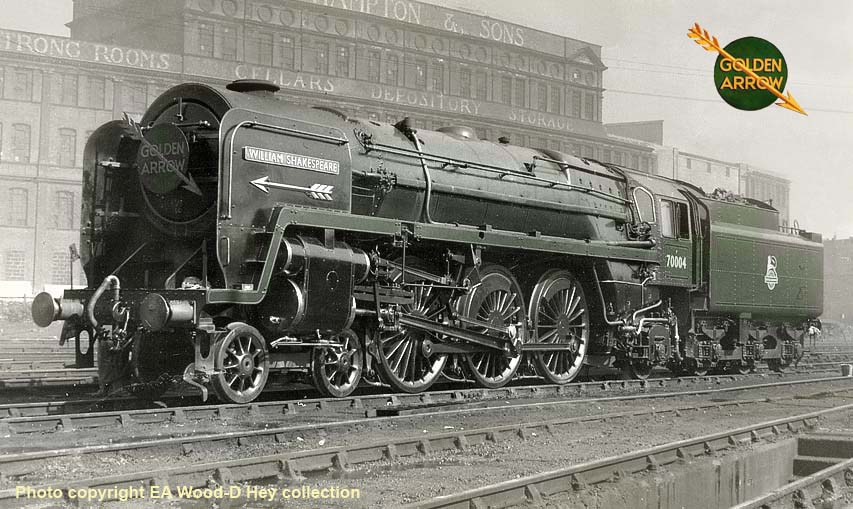
(Above-Inserts-below) And now to the real thing...although the BR Standard 7MTs were initially allocated to the GE line out of Liverpool Street, three Britannias were transferred to the Southern Region, with No 70009 going to Nine Elms and Nos 70004/70014 going to Stewarts Lane. Out of all the Britannias, however, 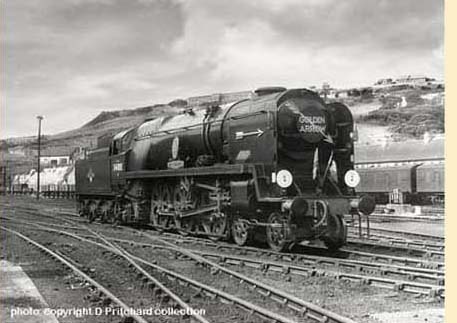 the best known to the public is No 70004 William Shakespeare, which was displayed at the Festival of Britain exhibition in 1951. Thereafter it was kept in immaculate condition for hauling the 'Golden Arrow' and other boat train services to the continent. (Inset Left) Not wishing to incur the wrath of SR fans, but the removal of the air-smooth casing greatly enhanced the looks of the Bulleid Pacifics. Here, rebuilt 'Battle of Britain' class No 34088 213 Squadron is entrusted with hauling the famous cross-Channel London Victoria-Folkestone and Dover 'Golden Arrow' Pullman car train that ran in conjunction with the 'Fleche d'Or' for the Calais-Paris run. By 1972, increased competition from air travel meant that BR couldn't justify the retention of a set of Pullman cars for just one return trip daily from London to the Channel coast and this prestigious service was withdrawn. After the final 'Golden Arrow' ran on 30th September 1972, some of the
the best known to the public is No 70004 William Shakespeare, which was displayed at the Festival of Britain exhibition in 1951. Thereafter it was kept in immaculate condition for hauling the 'Golden Arrow' and other boat train services to the continent. (Inset Left) Not wishing to incur the wrath of SR fans, but the removal of the air-smooth casing greatly enhanced the looks of the Bulleid Pacifics. Here, rebuilt 'Battle of Britain' class No 34088 213 Squadron is entrusted with hauling the famous cross-Channel London Victoria-Folkestone and Dover 'Golden Arrow' Pullman car train that ran in conjunction with the 'Fleche d'Or' for the Calais-Paris run. By 1972, increased competition from air travel meant that BR couldn't justify the retention of a set of Pullman cars for just one return trip daily from London to the Channel coast and this prestigious service was withdrawn. After the final 'Golden Arrow' ran on 30th September 1972, some of the 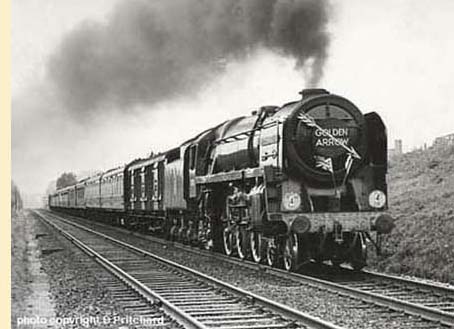 Pullman cars have since been restored and are now in use in the English portion of the 'Venice-Simplon Orient Express'. (Inset Right) I recall spotting 70004 William Shakespeare during the final years of London Midland Region steam and the grimy appearance of her paintwork was in complete contrast to her Stewarts Lane existance where she was kept in immaculate condition along with one other Stewarts Lane Britannia No 70004 William Shakespeare for working the 'Golden Arrow' and other boat train services until 1958. For the record, both No 70004 and 70014 were among the last thirteen Britannias withdrawn from traffic at Carlisle Kingmoor in December 1967. (Below) The times are changing at Dover Marine...
Pullman cars have since been restored and are now in use in the English portion of the 'Venice-Simplon Orient Express'. (Inset Right) I recall spotting 70004 William Shakespeare during the final years of London Midland Region steam and the grimy appearance of her paintwork was in complete contrast to her Stewarts Lane existance where she was kept in immaculate condition along with one other Stewarts Lane Britannia No 70004 William Shakespeare for working the 'Golden Arrow' and other boat train services until 1958. For the record, both No 70004 and 70014 were among the last thirteen Britannias withdrawn from traffic at Carlisle Kingmoor in December 1967. (Below) The times are changing at Dover Marine...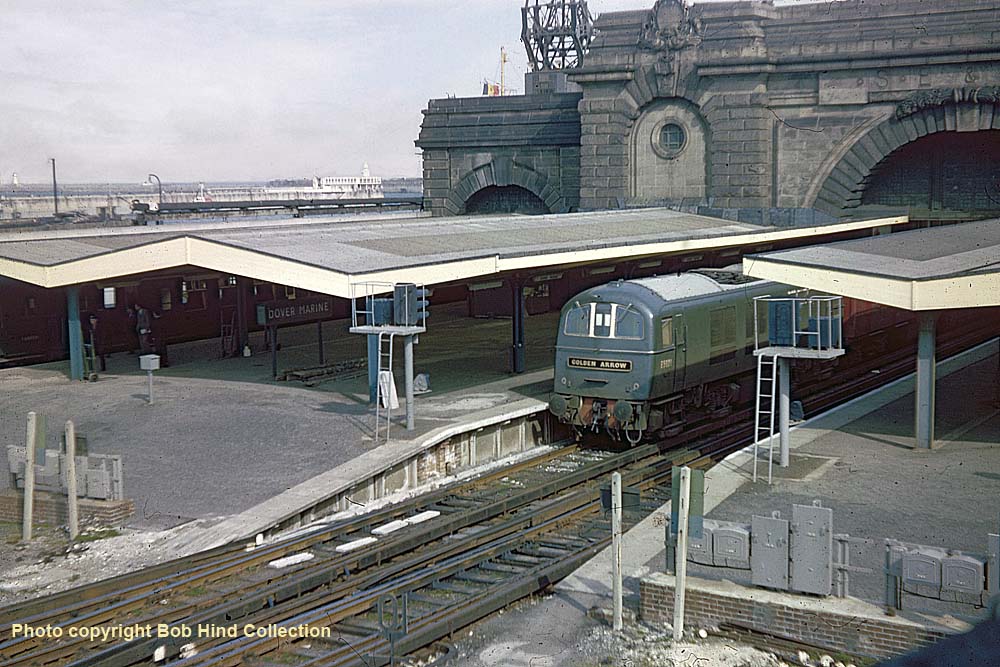
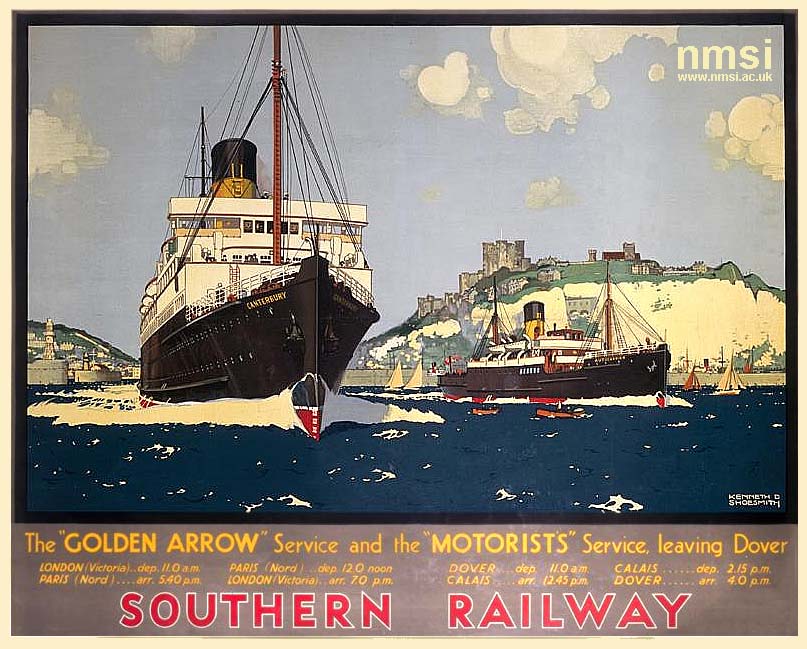
(Above) The stunning images from the NMSI collection show the quality of poster art to be seen on station platforms across the country. For the record, the NMSI family is comprised of four award-winning museums, each with their own diverse identity: the Science Museum, the National Media Museum and, of course, the National Railway Museum (NRM) at York which houses the world's pre-eminent railway collection. Spread across three halls, the Great Hall - formerly the steam engine shed (50A) - is complete with a working turntable, while the Station Hall (previously York's central goods depot) is now laid out like a 'period' railway station. The Science Museum Swindon is a massive site housing collections ranging from the iconic Lockheed Constellation airliner to super computers, bicycles and the last Fleet Street printing press, however the NMSI's full collection is so big that only 8% of the artefacts are on public view. The rest are hidden-away at an ex-WW2 airfield just off the M4. The NMSI Collections Online is a superb website which displays countless thousands of objects including a range of fabulous railway travel posters HERE...a visit is highly recommended. This Southern Railway - 'Golden Arrow Service and the Motorists Service leaving Dover' - was painted by Kenneth Shoesmith and published in 1932.
(Above-inset) A fine study by 'Footplate Cameraman', Jim Carter, of 'Battle of Britain' class No 34064 Fighter Command at Southampton. (Inset) A cast aluminium headboard 'The Cunarder' measuring 51" x 15" went 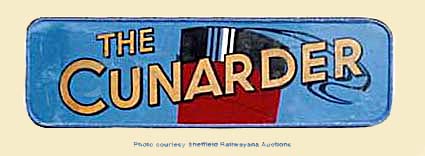 under the hammer for £7,900 at a Sheffield Railwayana Auction in July 2009. The ornate headboard features a painting of a ships funnel in red and black against a blue background with the title "The Cunarder" in gold diagonally across. The face plate is mounted on a frame 58" x 8" with slots which fitted the brackets on the front of Bulleid Pacifics. The back of one of the supports is clearly stamped 'Eastleigh MP Dept'. Dating from SR and BR days, the train ran between Waterloo and Southampton Docks to connect with the sailings of trans-Atlantic steamers.
under the hammer for £7,900 at a Sheffield Railwayana Auction in July 2009. The ornate headboard features a painting of a ships funnel in red and black against a blue background with the title "The Cunarder" in gold diagonally across. The face plate is mounted on a frame 58" x 8" with slots which fitted the brackets on the front of Bulleid Pacifics. The back of one of the supports is clearly stamped 'Eastleigh MP Dept'. Dating from SR and BR days, the train ran between Waterloo and Southampton Docks to connect with the sailings of trans-Atlantic steamers. 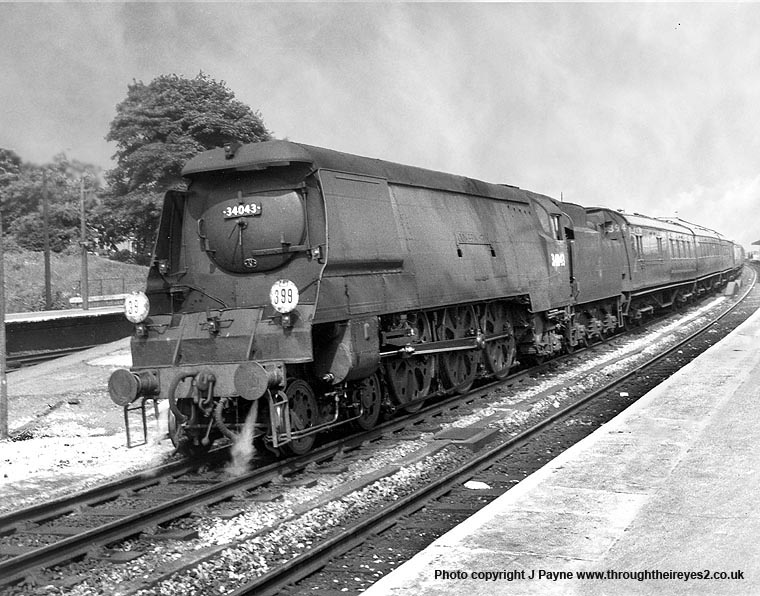
(Above-Insets-Below) The headcode on Unrebuilt West Country Class 34043 'Coombe Martin' denotes that she is working 'The Pines Express' at Basingstoke on its Southbound journey. The 'Pines Express' ran 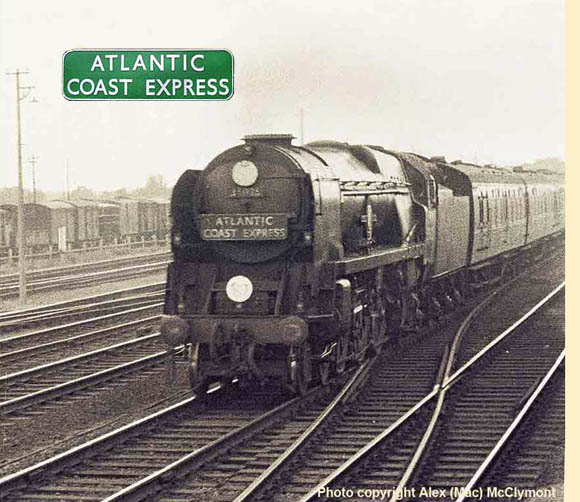 daily between Manchester London Road (later Piccadilly) and Bournemouth West from September 26th 1927 to 1967, and is perhaps best known for running via the steeply-graded Somerset and Dorset Joint Railway route (S&DJR) over the Mendips south of Bath Green Park to Bournemouth. Due to BR's Regional boundary changes the S&DJR's future was uncertain and after Class 9F 92220 Evening Star hauled the last Pines Express over the route on 8th September 1962 the train was diverted over the Western Region's lines via Oxford, Reading, Basingstoke and Southampton. The last Pines Express ran on 8th September 1962. (Inset Left) Rebuilt 'Merchant Navy' class 35023 'Holland-Afrika Line' shown hurtling through Basingstoke with 'The Atlantic Coast Express' - known to spotters as the 'ACE' - which departed Waterloo at 11am and reached Exeter Central in 2 hours 56 minutes. This Waterloo-West Country express began operations during LSWR days but it wasn't until 1927 that it was given the title 'Atlantic Coast Express'. The train had as many as nine different sections in the formation, including Ilfracombe,
daily between Manchester London Road (later Piccadilly) and Bournemouth West from September 26th 1927 to 1967, and is perhaps best known for running via the steeply-graded Somerset and Dorset Joint Railway route (S&DJR) over the Mendips south of Bath Green Park to Bournemouth. Due to BR's Regional boundary changes the S&DJR's future was uncertain and after Class 9F 92220 Evening Star hauled the last Pines Express over the route on 8th September 1962 the train was diverted over the Western Region's lines via Oxford, Reading, Basingstoke and Southampton. The last Pines Express ran on 8th September 1962. (Inset Left) Rebuilt 'Merchant Navy' class 35023 'Holland-Afrika Line' shown hurtling through Basingstoke with 'The Atlantic Coast Express' - known to spotters as the 'ACE' - which departed Waterloo at 11am and reached Exeter Central in 2 hours 56 minutes. This Waterloo-West Country express began operations during LSWR days but it wasn't until 1927 that it was given the title 'Atlantic Coast Express'. The train had as many as nine different sections in the formation, including Ilfracombe,  Torrington, Padstow, Bude and Plymouth. The service ceased in the mid-1960s when most of the lines it served closed as part of the Beeching Axe. (Inset Right) A cast aluminium headboard measuring 51" x 15" face on brackets 8½" deep, and probably one of the most desirable 'Southern' titled train headboards recently went under the hammer at a Sheffield Railwayana Auction. (Below) Rebuilt 'Merchant Navy' class 35020 'Bibby Line' shown hurtling through Basingstoke with 'The Atlantic Coast Express' in 1960. Beneath it is a carriage board measuring 11' in length, as used on this most evocative of all Southern Region trains that plied the route from Waterloo to holiday destinations in Devon and Cornwall. The carriage board went under the hammer for £560 at a Great Western Railwayan Auction in May 2012.
Torrington, Padstow, Bude and Plymouth. The service ceased in the mid-1960s when most of the lines it served closed as part of the Beeching Axe. (Inset Right) A cast aluminium headboard measuring 51" x 15" face on brackets 8½" deep, and probably one of the most desirable 'Southern' titled train headboards recently went under the hammer at a Sheffield Railwayana Auction. (Below) Rebuilt 'Merchant Navy' class 35020 'Bibby Line' shown hurtling through Basingstoke with 'The Atlantic Coast Express' in 1960. Beneath it is a carriage board measuring 11' in length, as used on this most evocative of all Southern Region trains that plied the route from Waterloo to holiday destinations in Devon and Cornwall. The carriage board went under the hammer for £560 at a Great Western Railwayan Auction in May 2012.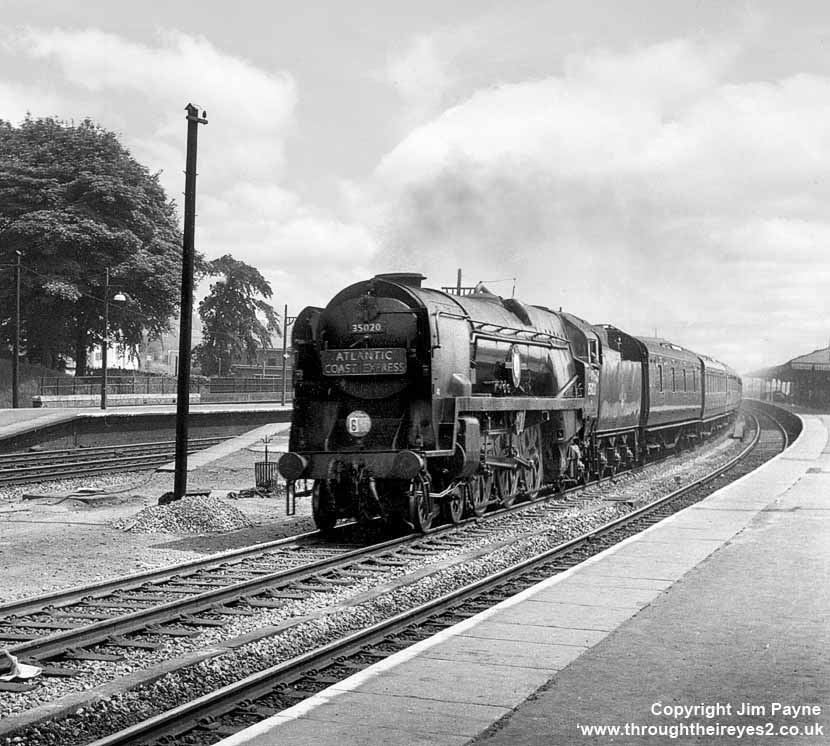
![]()
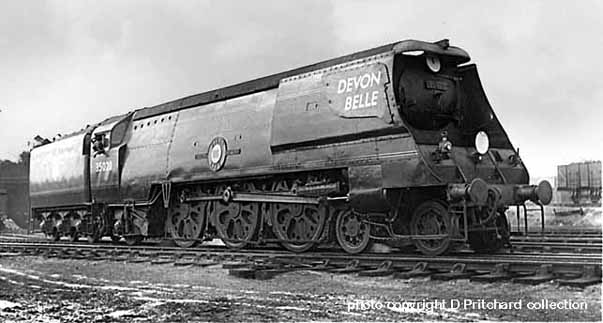
(Above-Inset) Being Yorkshire-born and bred, my interest in trains has its roots in ex-LNER and ex-LMS locomotives, therefore the Southern Railway's engines were all foreign to me, and the 'Spam Cans' in their original form (with air-smooth casing) did little to change that view. Odder still, under the Southern Railway's numbering scheme the Pacifics carried a 21C prefix that represented the continental system of wheel arrangement - the number of axles on the bogie was denoted by a '2', followed by a '1' for 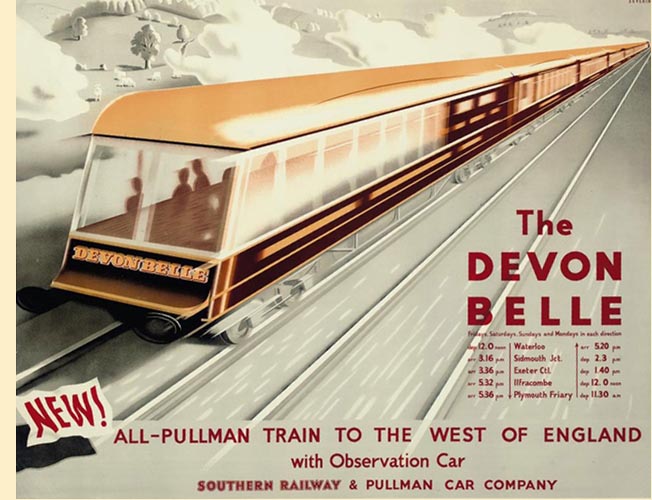 the pony truck, and the six driving wheels were represented by the letter 'C'. The first Bulleid Pacifics were named in honour of the Merchant seamen and shipping lines involved in the U-Boat war in the Atlantic, and became known as the 'Merchant Navy' class. Here, No 35020 Bibby Line is endowed with the 'Devon Belle' chevrons at its home shed of Nine Elms. (Inset)Introduced in June 1947, the prestigious all-Pullman 'Devon Belle' service from Waterloo to Ilfracombe included the provision of a tail-end beaver car, one of two vehicles Nos 13-14, both converted at the Pullman Company's Brighton Works for use especially on the 'Devon Belle'. When the Pullman service was withdrawn in 1954, the vehicles were used on the Scottish Region's scenic Oban and Kyle of Lochalsh lines. Today vehicle No 13 is preserved on the Paignton and Dartmouth Steam Railway, whereas No 14 was recently repatriated to Britain from the USA where it had languished in San Francisco after the ill-fated 'Flying Scotsman USA Tour' was abandoned in 1969. The vehicle is currently being restored on the Swanage Railway. This modern-looking 1947 poster by Marc Severin captures perfectly the striking 'art deco' style that once featured prominently in the design of the Southern Railway's promotional and advertising posters. The 'Devon Belle' is featured on the excellent Southern E-Group's website...click here
the pony truck, and the six driving wheels were represented by the letter 'C'. The first Bulleid Pacifics were named in honour of the Merchant seamen and shipping lines involved in the U-Boat war in the Atlantic, and became known as the 'Merchant Navy' class. Here, No 35020 Bibby Line is endowed with the 'Devon Belle' chevrons at its home shed of Nine Elms. (Inset)Introduced in June 1947, the prestigious all-Pullman 'Devon Belle' service from Waterloo to Ilfracombe included the provision of a tail-end beaver car, one of two vehicles Nos 13-14, both converted at the Pullman Company's Brighton Works for use especially on the 'Devon Belle'. When the Pullman service was withdrawn in 1954, the vehicles were used on the Scottish Region's scenic Oban and Kyle of Lochalsh lines. Today vehicle No 13 is preserved on the Paignton and Dartmouth Steam Railway, whereas No 14 was recently repatriated to Britain from the USA where it had languished in San Francisco after the ill-fated 'Flying Scotsman USA Tour' was abandoned in 1969. The vehicle is currently being restored on the Swanage Railway. This modern-looking 1947 poster by Marc Severin captures perfectly the striking 'art deco' style that once featured prominently in the design of the Southern Railway's promotional and advertising posters. The 'Devon Belle' is featured on the excellent Southern E-Group's website...click here
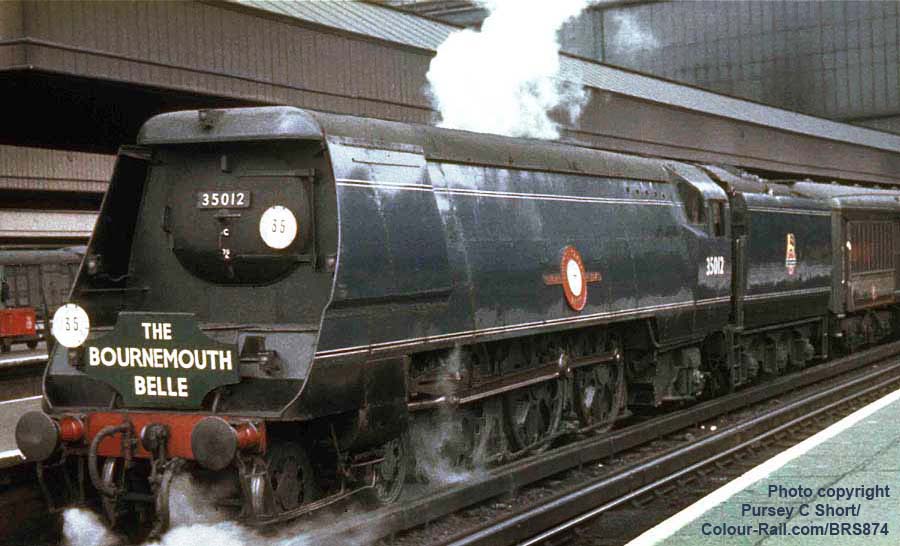
(Above-Insert-Below) Sporting the early British Railways standard blue livery, Merchant Navy class Pacific No 35012 United States Line awaits departure from Waterloo for the Hampshire coast with the 'down' Bournemouth Belle Pullman train in June 1951. (Below) Fast-forward to February 1957, and the SR's Pacifics' original air-smoothed casing has gone; the 30-strong Merchant Navy class was rebuilt at Eastleigh between 1956 and 1959. The work included the removal of the troublesome chain-driven valve gear (encased in an oil bath) to be replaced by the conventional outside Walschaerts valve gear. Here, No 35014 Nederland Line heads the 'down' ex-Waterloo train out of Southampton (and not the 'up' service as 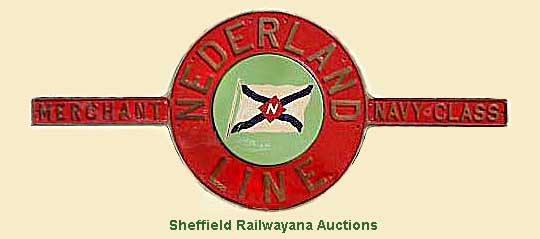 described in the photo). This SR Bullied Merchant Navy Class 4-6-2 entered service in February 1945. It was rebuilt in 1956 minus its original 'air-smoothed' casing and withdrawn in March 1967 from Weymouth shed and towed away for scrapping at Cashmore's of Newport the following September. It was originally numbered 21C14 by the Southern Railway and became 35014 in BR days. Nederland Line was a Dutch shipping company that operated from 1870 until 1970 before merging with several other companies to form what would become Royal Nedlloyd and eventually part of Maersk. (Insert) A 'Nederland Line' nameplate - overall dimensions: 73½" length x 30" diameter target, repainted red background, face lightly polished, the central enamel flag (facing the correct way) with a couple of well-executed repairs, otherwise ex-loco condition - went under the hammer for £26,500 at a Sheffield Railwayana Auction in June 2010. The photos above and below are among the many thousands of images to be found on the Colour-Rail website.
described in the photo). This SR Bullied Merchant Navy Class 4-6-2 entered service in February 1945. It was rebuilt in 1956 minus its original 'air-smoothed' casing and withdrawn in March 1967 from Weymouth shed and towed away for scrapping at Cashmore's of Newport the following September. It was originally numbered 21C14 by the Southern Railway and became 35014 in BR days. Nederland Line was a Dutch shipping company that operated from 1870 until 1970 before merging with several other companies to form what would become Royal Nedlloyd and eventually part of Maersk. (Insert) A 'Nederland Line' nameplate - overall dimensions: 73½" length x 30" diameter target, repainted red background, face lightly polished, the central enamel flag (facing the correct way) with a couple of well-executed repairs, otherwise ex-loco condition - went under the hammer for £26,500 at a Sheffield Railwayana Auction in June 2010. The photos above and below are among the many thousands of images to be found on the Colour-Rail website. 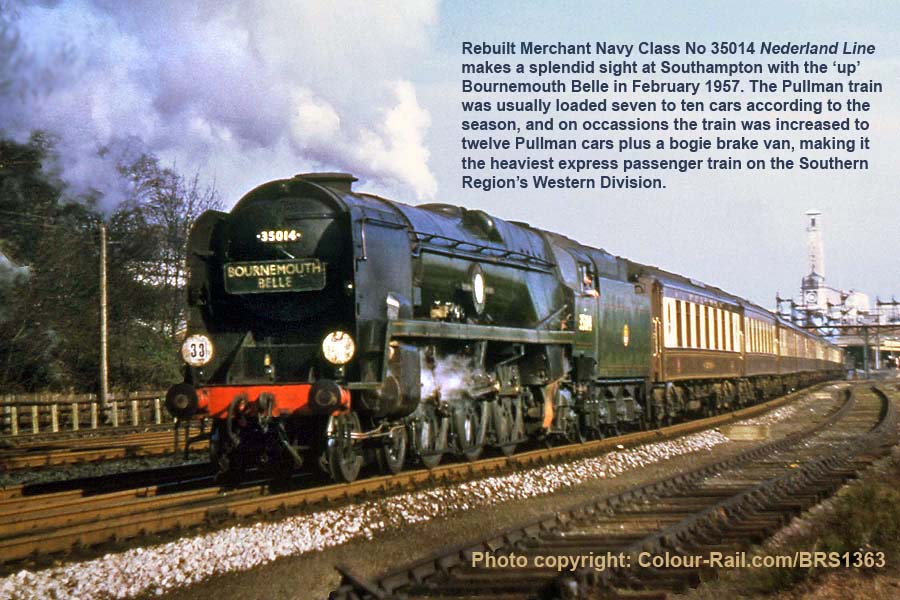
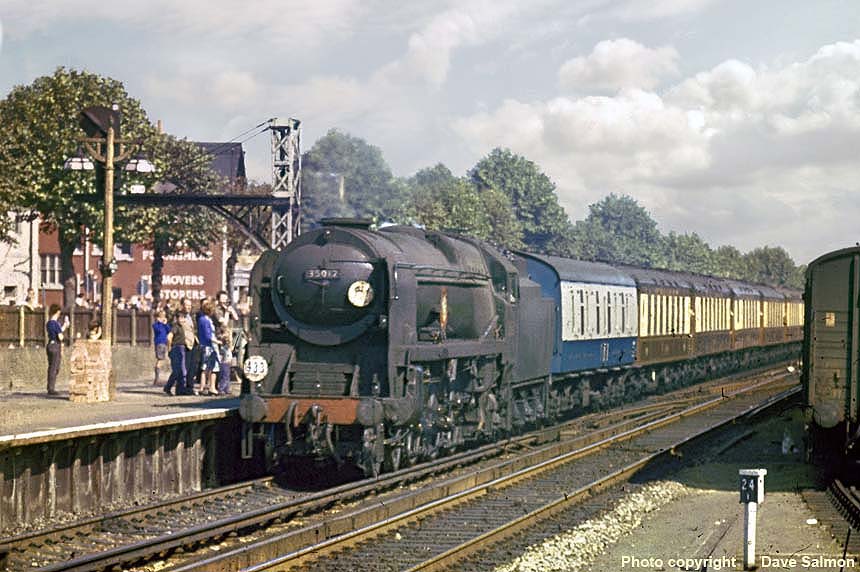
![]() (Above-Inset) 'Merchant Navy' class 35012 United States Line at Woking...date to be established. (Inset) 'Bournemouth Belle" original painted wooden Carriage Board. A fine example of the short style board only 60 in. long. This Pullman train ran between Bournemouth West and London Waterloo commencing in July 1931, it ceased in July 1967 by which time it was starting from Bournemouth Central.
(Above-Inset) 'Merchant Navy' class 35012 United States Line at Woking...date to be established. (Inset) 'Bournemouth Belle" original painted wooden Carriage Board. A fine example of the short style board only 60 in. long. This Pullman train ran between Bournemouth West and London Waterloo commencing in July 1931, it ceased in July 1967 by which time it was starting from Bournemouth Central.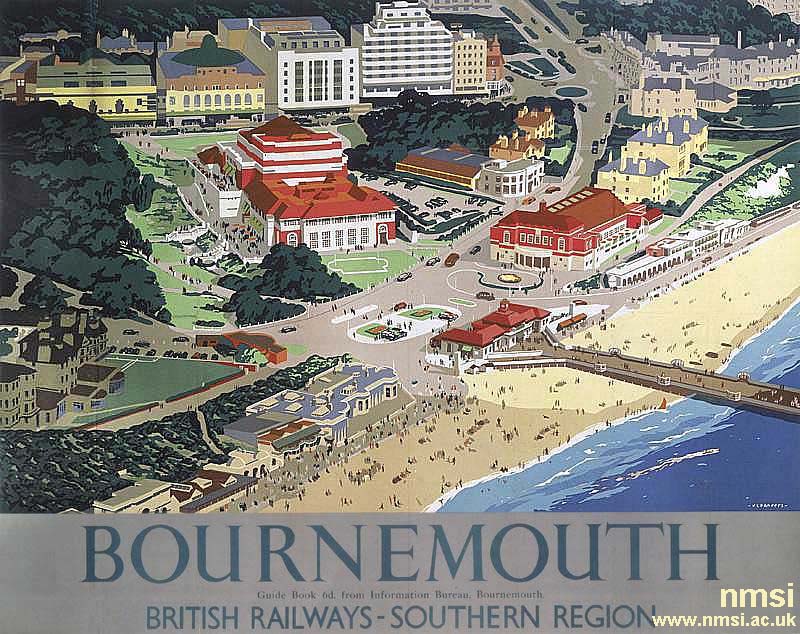
(Above) Another stunning image from the NSNI Collection Online is this British Railways (Southern Region) poster - 'Bournemouth' - painted by Verney L Danvers in 1948 depicting an aerial view of the beach, featuring the Lower Gardens, pier and seafront.
. 
Great Central Railwayana Auctions....click here.
GW Railwayana Auctions.....................click here.
Polite notice: All text and photographs are protected by copyright and reproduction is prohibited without the prior consent of the © owners. If you wish to discuss using the contents of this page the email address is below. Please note - this is not a 'clickable' mail-to link via Outlook Express. You will have to email manually.
dheycollection@ntlworld.com




